# Učenje i proučavanje stranih jezika
# The relationship between shyness, willingness to communicate, and foreign language anxiety
| ##### **Alenka Mikulec1, Helena Prugovečki2**
1 *University of Zagreb, Faculty of Teacher Education*
2 *Primary School Sesvete, Zagreb*
|
| **Foreign languages education and research**
| Number of the paper: 72 | **Original scientific paper**
|
| ##### **Abstract**
|
| Foreign language learning (FLL) has been considered a very complex process affected by a number of factors, some of which have been identified as significant barriers to successful language learning. Among these, language anxiety has frequently been singled out as a factor that may have a negative impact on FLL. Since previous studies have confirmed connection between shyness and willingness to communicate with foreign language anxiety, this research aimed to ascertain if the relationship between those three factors would also be confirmed on the sample of preservice primary teachers. It was hypothesized that the participants who have higher results on the shyness scale and those who are less willing to communicate would report a higher level of foreign language anxiety. The participants were 71 students enrolled at the Faculty of Teacher Education University in Zagreb. The research instrument was a four-part anonymous online questionnaire used to elicit the participants' 1) general information, 2) level of shyness (the McCroskey Shyness Scale), 3) willingness to communicate (the Willingness to Communicate (WTC) Scale), and 4) foreign language anxiety (Foreign Language Classroom Anxiety Scale). Research results showed that the majority of the participants reported low or moderate levels of anxiety, shyness, and willingness to communicate. The relationship between FL anxiety and shyness was not confirmed, but it was found that the participants who reported less willingness to communicate also reported a higher level of FL anxiety. Therefore, it is proposed that these factors should be dedicated more attention in foreign language teaching and learning at the tertiary level as well.
|
| ***Key words***
|
| *anxiety;* *communication; foreign language learning; preservice teachers*
|
##### Introduction
During their education, some foreign language learners may struggle and experience great discomfort, and foreign language anxiety (FLA) has been identified as one of the significant factors contributing to such feelings. It has been defined by Horwitz et al. (1986, p. 128) as “a distinct complex of self-perceptions, beliefs, feelings, and behaviors related to classroom language learning arising from the uniqueness of the language learning process”. MacIntyre’s (2007) definition emphasizes a person’s worry and usually negative emotions exhibited when learning or using a FL, whereas Gardner and MacIntyre (1993, p. 5) defined it as “the apprehension experienced when a situation requires the use of a second language with which the individual is not fully proficient”. Hence, it may be proposed that FLA is manifested as uncomfortable feelings such as nervousness, tension, apprehension or similar feelings observed while listening, writing, reading, or/and speaking in a foreign language. Mihaljević Djigunović (2002) mentioned four language anxiety components: 1) cognitive, which refers to a feeling of inability to perform well in a social context caused by lack of self-esteem, 2) emotional, which “implies feelings of unease, discomfort and tension” (Puškar, 2013, p. 81), 3) behavioural, manifested as “clumsiness, restraint and disturbances in gesture and speech” (Puškar, 2013, p. 81), and 4) physiological, which includes high-blood pressure, sweating, etc.
Several factors have been identified as being closely related with FLA, such as shyness, test anxiety, fear of negative evaluation (Horwitz et al., 1986) and willingness to communicate. This paper will focus on two of these – shyness and willingness to communicate. Shyness has been defined as “discomfort in social-communicative situations, a tendency to withdraw, a tendency to be timid and lack confidence, and a tendency to be quiet, neither assertive nor responsive to others”” (McCroskey & Richmond, 1982, p. 460). The same authors also propose that shyness may result from social anxiety, low social skills or low self-esteem. ). However, according to Chu (2008, pp. 12-13), even researchers are not in complete agreement on a unified definition of shyness which has been described as a form of social anxiety (Buss, 1980; Leary & Schlenker, 1981; Zimbardo, 1977), “a pattern of avoidant, reticent, and inhibited behavior” (Phillips, 1980; Pilkonis, 1977a), or as a manifestation of anxious feelings and inhibited or avoidant behavior (Cheek & Buss, 1981; Crozier, 1979; Jones & Russell, 1982). Whichever of the above explanations of shyness we choose, it has to be remembered that, in addition to the behaviours described above, shy students may also be at risk of being overlooked or being invisible by teachers and peers in the classroom (Gresham & Kern, 2004; Nilsen, 2018). Therefore, it is considered a significant factor in the classroom in general, but even more so in foreign language classrooms which are predominantly based on communication, and shy students usually refuse to speak or speak quietly or briefly.
In addition to shyness, willingness to communicate (WTC) i.e., a probability that someone will initiate communication in different social situations, has also been recognized as an important factor related to FLA. One’s willingness to communicate in L2 depends on a combination of variables such as personality, L2 self-confidence, interpersonal communication (MacIntyre et al., 1998), personal traits and a situation in which communication occurs (for instance, interlocutor’s appearance, status, a person’s feelings, conversation topic, etc.) (McCroskey, 1985). The model proposed by MacIntyre et al. (1998, p. 547) includes six categories of variables that have an impact on WTC. These categories have been divided into those representing situation-specific influences such as 1) L2 use, 2) willingness to communicate, 3) desire to communicate with a specific person and state communicative self-confidence, and the ones representing stable, enduring influences like 4) motivation and L2 self-confidence, 5) intergroup attitudes, social situation, communicative competence, and 6) social and individual context. Mihaljević Djigunović (2002) proposed that an individual analyses the social group and possible communicative outcomes, and if the group has not fulfilled the individual’s expectations, he or she may have low self-esteem and may avoid situations in which communication occurs, which may subsequently affect one’s willingness to communicate.
Finally, language proficiency has also been mentioned as a significant factor affecting FLA. It has been proposed that students who have better developed language skills have fewer negative experiences and thus their foreign language anxiety may gradually disappear (MacIntyre & Gardner, 1989; Mihaljević Djigunović, 2002).
##### Methods
**Aim and hypotheses**
The aim of this research was to establish the level of shyness, willingness to communicate, and foreign language anxiety among preservice teachers, and to find out if there is a positive or negative relationship between these three variables.
The following hypotheses were defined:
1\. Students with higher results on the shyness scale will also report a higher level of foreign language anxiety.
2\. Students with lower results on the willingness to communicate scale will report higher levels of foreign language anxiety.
**Participants**
The research participants were preservice teachers, i.e., 71 first, third, fourth, and fifth-year students of the Faculty of Teacher Education in Zagreb enrolled in two study programmes (Table 1). The average age of the participants was 22.7 years (SD = 1.1, min. 21, max. 25) and the majority were female (Table 1).The students’ average length of learning English was 11.97 years (SD = 2.45), and their average grade in English in primary school was 4.86 (SD = 0.42), whereas in secondary school it was somewhat lower at 4.59 (SD = 0.62). Most students reported not learning English outside school (n = 52) while the rest (n = 19) reported an average of 4.26 years.
Table 1. Research participants
| Gender
| male
| n = 8, f = 11.3%
|
| female
| n = 63, f = 88.7%
|
| Study programme
| Primary and English/German Teacher Education (foreign language majors)
| n = 46, f = 64.8%
|
| Primary Teacher Education with modules (non-foreign language majors)
| n = 25, f = 35.2%
|
| Year of studies
| First
| n = 1, f =1.4%
|
| Third
| n = 20, f = 28.2%
|
| Fourth
| n = 13, f = 18.3%
|
| Fifth
| n = 37, f = 52.1%
|
| Exposure to English outside college more than 10 hours per week
| foreign language majors
| n = 26, f = 56.5%
|
| non-foreign language majors
| n = 3, f = 26%
|
| Self-assessed EFL proficiency
| foreign language majors
| M = 4.5 (SD = 0.69)
|
| non-foreign language majors
| M = 3.8 (SD = 0.71)
|
All students reported some exposure to English outside college, with the majority (n = 32) reporting weekly exposure to English more than 10 hours per week, for 23 students the weekly exposure was only five hours while for the rest (n = 16) it was up to 10 hours. Differences in the exposure to English were observed when the results were compared between the foreign language majors and non-foreign language majors, with the former reporting more exposure than the latter (Table 1). Most participants seem fairly confident about their EFL proficiency, as the average self-assessed knowledge of English was 4.25 (SD = 0.77). However, here again, a difference between the foreign language majors and non-foreign language majors can be observed in favour of the former group (Table 1). As previously mentioned, language proficiency has been identified as an important factor related with FLA, therefore, the results were compared according to whether students were foreign language majors or not, following the assumption that foreign language majors are more proficient than the other group.
All students reported some exposure to English outside college, with the majority (n = 32) reporting weekly exposure to English more than 10 hours per week, for 23 students the weekly exposure was only five hours while for the rest (n = 16) it was up to 10 hours. Differences in the exposure to English were observed when the results were compared between the foreign language majors and non-foreign language majors, with the former reporting more exposure than the latter (Table 1). Most participants seem fairly confident about their EFL proficiency, as the average self-assessed knowledge of English was 4.25 (SD = 0.77). However, here again, a difference between the foreign language majors and non-foreign language majors can be observed in favour of the former group (Table 1). As previously mentioned, language proficiency has been identified as an important factor related with FLA, therefore, the results were compared according to whether students were foreign language majors or not, following the assumption that foreign language majors are more proficient than the other group.
**Research instruments**
For the purpose of the present research, an anonymous four-part online questionnaire was developed and made accessible to the students throughout April 2021. Information about their age, gender, field and year of studies, level of English etc. was collected in the first part of the questionnaire. The following section was the McCroskey Shyness Scale (http://www.jamescmccroskey.com/measures/shyness.htm), whose objective was to yield information about the students’ level of shyness. The scale consists 14 statements, which the students assessed on the five-point Likert scale as follows: strongly disagree (1), disagree (2), neutral (3), agree (4), or strongly agree (5). The third part of the questionnaire was the Willingness to Communicate (WTC) Scale (http://www.jamescmccroskey.com/measures/WTC.htm), designed by McCroskey and Richmond (1987) to measure the participants’ willingness to initiate communication. The scale is based on twenty different situations for which the participants were required to state the percentage indicating how often they would choose to communicate in a particular situation (e.g., Present a talk to a group of strangers.).
The last section of the questionnaire was the Foreign Language Classroom Anxiety Scale (FLCAS) (Horwitz et al., 1986), which was used to measure the participants’ level of self-reported foreign language anxiety. The questionnaire consists of 33 statements which the participants also assessed on a five-point Likert-type scale.
##### Results and discussion
In this chapter, the obtained results are presented according to the three scales that were used (shyness, willingness to communicate and foreign language anxiety). In addition, for all three scales, the overall results are given as well as the results according to the study programme and the year of studies.
**Shyness and willingness to communicate**
Figure 1 shows that most of the students (n = 40, f = 56.3%) indicated a moderate level of shyness, a fairly small number (n = 8, f = 11.3%) reported a high level (scores above 52), while the rest (n = 23, f = 32.4%) reported a low level of shyness (scores below 32). The highest level of shyness, reported by two students, was 67 and the lowest level was 15, reported by three students. A possible explanation of this result is that the participants are students who have chosen teaching as their future job and are therefore believed to be extroverts, as teaching is considered “an actively social profession” (McWilliams, 2019, p. 8). Moreover, research evidence has indicated that the majority of teachers have relatively high levels of extraversion, especially when compared to the general population (Roy, 1995; Kent & Fisher, 1997; McCutcheon, Schmidt, & Bolden, 1991; Vorkapic, 2012). This is no surprise since the profession requires daily social interactions, speaking in front of groups, and facilitating discussions and interactions among students.
[](https://hub.ufzg.hr/uploads/images/gallery/2022-11/93.png)
Figure 1. Students’ level of shyness
Figures 2 and 3 show the analysis of students’ levels of shyness according to their study programme.
[](https://hub.ufzg.hr/uploads/images/gallery/2022-11/92.png)
Figure 2. The level of shyness among the foreign language majors
Based on the results, it was observed that 37% (n = 17) of the foreign language majors reported a low level of shyness compared to 24% (n = 6) of the students enrolled in the other study programme. None of the non-foreign language majors reported high levels of shyness compared to 17.4% (n = 8) of the foreign language majors. Finally, 45.6% (n = 21) of the foreign language majors reported a moderate level of shyness compared to 76% (n = 19) of the students in the other group.
[](https://hub.ufzg.hr/uploads/images/gallery/2022-11/91.png)
Figure 3. The level of shyness among the non-foreign language majors
The comparison of the levels of shyness according to the year of studies indicates that none of the fourth-year students reported a high level of shyness while 16.2 % (n = 6) of the fifth-year students and 10% (n = 2) of the third-year students did report a high level of shyness. The results further show that there is little difference among the students enrolled in the third, fourth, and fifth years of studies regarding their moderate (n = 11, f = 55%; n = 8, f = 61.5%; and n = 20, f = 54.1%, respectively) and low levels of shyness (n = 7, f = 35%, n = 5, f = 38.5%; and n = 11, f = 29.7%, respectively). The results of the fifth-year students are somewhat unexpected because, being in their final year of studies, they were expected to report the lowest levels of shyness. Namely, shyness has been related with environmental factors (Gard, 2000) and the fifth-year students have had the most experience in being in situations where they have had to overcome their shyness such as teaching primary school students and giving presentations in front of their colleagues, mentors, and teachers, so it was justifiably expected that they would report the lowest levels of shyness.
[](https://hub.ufzg.hr/uploads/images/gallery/2022-11/90.png)
Figure 4. The level of students’ willingness to communicate
The results obtained for students’ willingness to communicate (Figure 4) show that most participants (n = 37, f = 52.1%) reported moderate, the minority (n = 8, f = 11.3%) reported a high level (scores above 82), and the rest (n = 26, f = 36.6%) reported a low level of willingness to communicate (scores below 52). The highest score was 95, reported by two students, and the lowest score was 16.3, reported by one student. Since the teaching profession requires frequent communication with students, parents, other teachers etc., it is surprising that a fairly high percentage of the participants reported moderate to low willingness to communicate.
[](https://hub.ufzg.hr/uploads/images/gallery/2022-11/89.png)
Figure 5. The level of willingness to communicate among the foreign language majors
The analysis according to the study programme (Figures 5 and 6) has not indicated much difference between the students: 10.7% (n = 5) high, 35% (n = 16) low and 54% (n = 25) moderate willingness to communicate for foreign language majors and 12% (n = 3) high, 40% (n = 10) low and 48% (n = 12) moderate willingness to communicate for the non-foreign language majors. In both cases, the majority of the students reported moderate to low levels of willingness to communicate, with somewhat higher percentage of the non-foreign language majors reporting low levels.
[](https://hub.ufzg.hr/uploads/images/gallery/2022-11/69.png)
Figure 6. The level of willingness to communicate among the non-foreign language majors
Analysis according to the year of studies shows that none of the fourth-year students and only few of the fifth (n = 4, f = 10.8%) and third-year (n = 4, f = 20%) students reported high levels of willingness to communicate. When their moderate and low levels of willingness to communicate are compared, little difference can be observed between the fifth (n = 14, f = 37.8% low and n = 19, f = 51.4% moderate), fourth (n = 5, f = 38.5% low and n = 8, f = 61.5% moderate), and third-year students (n = 6, F = 30% low and n = 10, f = 50% moderate). However, the results show that, somewhat surprisingly, the fewest of the youngest students (third-year students) reported the lowest level of willingness to communicate.
When the two scales (the McCroskey Shyness Scale and the Willingness to Communicate Scale) are compared, it may be observed that the majority of the participants have a moderate level of shyness (n = 40) as well as a moderate level of willingness to communicate (n = 37).
##### Foreign language anxiety
The results of the Foreign Language Classroom Anxiety Scale (Figure 7) show that only several participants (11.3%, n = 8) reported a high level of foreign language anxiety (scores 120 or above). The number of the participants with scores lower than 76, i.e., a low level of anxiety (n = 30, f = 42.3%) or scores between 76 and 119, i.e., a moderate level of anxiety (n = 33, f = 46.5%) was similar. The highest score was 143, reported by one student, and the lowest was 36, also reported by only one student.
[](https://hub.ufzg.hr/uploads/images/gallery/2022-11/68.png)
Figure 7. Results of the Foreign Language Classroom Anxiety Scale
Students’ foreign language anxiety level was also compared according to the study programme (Figures 8 and 9). **[](https://hub.ufzg.hr/uploads/images/gallery/2022-11/67.png)**
Figure 8. Foreign language anxiety level among the foreign language majors
Foreign language (English/German) majors are required to listen to some lectures and study approximately four courses per semester in the foreign language. As expected, the analysis showed that only a few of the participants attending this study programme reported a high level of language anxiety (n = 4, f = 8.7%), while the majority reported low (n = 24, f = 52.2%) or moderate levels of anxiety (n = 18, f = 39.1%). On the other hand, the percentage of non-foreign language majors who reported a high level of foreign language anxiety was somewhat higher (n = 4, f = 16%). More than half of the students enrolled in this study programme reported a moderate level of language anxiety (n = 15, f = 60%) while the others (n = 6, f = 24%) indicated a low level.
[](https://hub.ufzg.hr/uploads/images/gallery/2022-11/66.png)
Figure 9. Foreign language anxiety level among the non-foreign language majors
In order to gain a better insight into the students’ foreign language anxiety, some of the statements which most of the students disagreed with were analysed. The greatest number of students strongly disagreed with the following statements, indicating a low level of anxiety: 5. During language class, I find myself thinking about things that have nothing to do with the course (M = 1.82, n = 35); 21. The more I study for a language test, the more confused I get (M = 1.65, n = 42); 25. Language class moves so quickly I worry about getting left behind (M = 1.96, n = 35); 26. I feel more tense and nervous in my language class than in my other classes (M = 2.2, n = 31); 31. I am afraid that the other students will laugh at me when I speak the foreign language (M = 2.27, n = 32). These statements present situations or aspects which mostly do not cause problems for the participants while learning and using a foreign language.
In order to gain a better insight into the students’ foreign language anxiety, some of the statements which most of the students disagreed with were analysed. The greatest number of students strongly disagreed with the following statements, indicating a low level of anxiety: 5.
During language class, I find myself thinking about things that have nothing to do with the course The more I study for a language test, the more confused I get Language class moves so quickly I worry about getting left behind I feel more tense and nervous in my language class than in my other classes
(M = 2.2, n = 31); 31. I am afraid that the other students will laugh at me when I speak the foreign language (M = 2.27, n = 32). These statements present situations or aspects which mostly do not cause problems for the participants while learning and using a foreign language.
**Correlations between FLA, shyness and willingness to communicate**
One of the objectives of the research was to ascertain if there was a correlation between the three studied variables. Spearman’s rho test was used in the analysis of a possible correlation between shyness and foreign language anxiety, and the result indicated no correlation between the two variables (Table 2). That is to say, the students who reported higher level of shyness did not report experiencing higher level of foreign language anxiety. These results are not in accordance with those obtained by Ordulj and Grabar (2014), who found that Croatian students learning Italian in foreign language schools did experience foreign language anxiety, and that although the level and years of learning were not related with anxiety, the level of foreign language anxiety was found to be higher among shy students. The authors proposed that the possible explanation of such results may be because “quite often there is teasing or making fun of a person who pronounces the word wrongly, applies rules in a wrong way, or finds it hard to answer a question using adequate words” (Ordulj & Grabar, 2014, p. 219). On the other hand, the results in this study are similar to those presented by Bashosh et al. (2013), who also found no significant relationship between shyness and foreign language anxiety among 60 undergraduates learning English as a foreign language in Iran.
Table 2. Correlations between willingness to communicate, shyness and FLA
|
| Anxiety (FLCAS)
| Shyness
| Willingness to communicate
|
| Willingness to communicate
| 0.249\*
| 0.416\*\*
| -
|
| Shyness
| 0.207
| -
|
|
| Anxiety (FLCAS)
| -
|
|
|
| [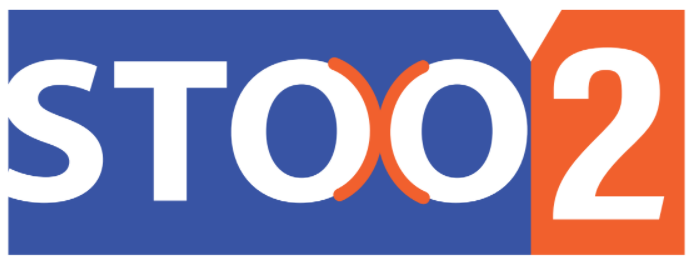](https://hub.ufzg.hr/uploads/images/gallery/2022-10/stoo2.png)
| *2. međunarodna znanstvena i umjetnička konferencija Učiteljskoga fakulteta Sveučilišta u Zagrebu Suvremene teme u odgoju i obrazovanju – STOO2 - in memoriam prof. emer. dr. sc. Milanu Matijeviću, Zagreb, Hrvatska*
|
##### **Odnos između straha od stranoga jezika, spremnosti na komunikaciju i sramežljivosti**
| ##### **Sažetak**
|
| Učenje stranih jezika smatra se vrlo složenim procesom na koji utječe niz čimbenika, od kojih su neki prepoznati kao značajne prepreke uspješnom učenju jezika. Među njima se strah od jezika često izdvaja kao čimbenik koji može imati negativan utjecaj na učenje stranih jezika. Budući da je prethodnim istraživanjima potvrđena povezanost sramežljivosti i spremnosti na komunikaciju sa strahom od stranoga jezika, ovo je istraživanje imalo za cilj utvrditi postoji li veza između tri navedena čimbenika i među budućim učiteljima. U istraživanju se krenulo od pretpostavke da će sudionici koji imaju više rezultate na ljestvici sramežljivosti i oni koji su manje spremni na komunikaciju osjećati veći strah od stranoga jezika. U istraživanju su sudjelovali 71 student i studentica Učiteljskog fakulteta Sveučilišta u Zagrebu. Instrument korišten u istraživanju bio je četverodijelni anonimni *online *upitnik kojim su prikupljeni sljedeći podatci o sudionicima 1) opće informacije, 2) razina sramežljivosti (McCroskeyjeva skala sramežljivosti), 3) spremnost na komunikaciju (Skala spremnosti na komunikaciju), i 4) strah od stranoga jezika (Skala straha od stranoga jezika u učionici). Rezultati istraživanja pokazali su da većina sudionika osjeća nisku ili umjerenu razinu straha od stranoga jezika, sramežljivosti i spremnosti na komunikaciju. Povezanost između straha od stranoga jezika i sramežljivosti nije potvrđena, ali je utvrđeno da ispitanici koji smatraju da su manje spremni na komunikaciju na materinskom jeziku osjećaju izraženiji strah od stranoga jezika. Stoga se predlaže da se navedenim čimbenicima posveti više pažnje u poučavanju i učenju stranih jezika i na višim razinama obrazovanja.
|
| ***Ključne riječi***
|
| *budući učitelji; komunikacija; strah; učenje stranih jezika*
|
# Anglizismen in deutschen und österreichischen Onlinenachrichten der privaten und öffentlich-rechtlichen Fernsehsender
| ##### **Ana Aničić1, Damir Velički2**
1 *Grundschule Pušća, Donja Pušća*
2* Fakultät für Lehrerbildung der Universität Zagreb*
|
| **Foreign languages education and research**
| Number of the paper: 73 | **Original scientific paper**
|
| ##### **Abstract**
|
| Ziel dieser Arbeit ist, die Häufigkeit von Anglizismen in deutschen und österreichischen Onlinenachrichten öffentlich-rechtlicher und privater Fernsehsender zu ermitteln. Das Forschungskorpus besteht aus stichprobenartig ausgewählten Texten aus den Bereichen Innenpolitik, Außenpolitik, Wirtschaft, Technologie und Sport. Der Begriff *Anglizismus* wird unterschiedlich definiert, doch für den Zweck dieser Arbeit wird er als Oberbegriff für formale Entlehnungen aus englischsprachigen Regionen angesehen. Für die Analyse der deutschen Onlinenachrichten wurden Texte der Onlinenachrichten *Tagesschau* und *RTL* ausgewählt, während für die österreichischen Onlinenachrichten *ORF* und *Puls24* ausgewählt wurden. Innerhalb des Intervalls von einem Monat wurden jeweils fünf Texte aus den oben genannten Bereichen ausgewählt. Die Ergebnisse zeigten, dass es in Deutschland, wenn auch äußerst gering, Unterschiede in der Häufigkeit der Nutzung von Anglizismen zwischen online -Nachrichten öffentlich-rechtlicher und privater Fernsehsender gibt. Der Unterschied in der Nutzungshäufigkeit der Anglizismen zwischen Onlinenachrichten öffentlich-rechtlicher und privater Fernsehsender war in Österreich stärker ausgeprägt als in Deutschland. Im Vergleich zu den deutschen und österreichischen Onlinenachrichten, werden in den Onlinenachrichten des privaten Fernsehsenders *Puls24* in Österreich mehr Anglizismen verwendet als in den Onlinenachrichten des deutschen *RTL*. Bei den öffentlich-rechtlichen Fernsehsendern verwendeten die Onlinenachrichten der *Tagesschau* mehr Anglizismen als die österreichischen Onlinenachrichten des *ORF*. Insgesamt ist der Anteil der Anglizismen jedoch sowohl bei deutschen als auch bei österreichischen Onlinenachrichten der Fernsehsender relativ gering, sie waren aber in allen Bereichen präsent. Dies hat zu der Schlussfolgerung geführt, dass Anglizismen einen festen Platz in den deutschen als auch österreichischen Nachrichten haben und aufgrund der hohen Leserzahl haben sie einen direkten Einfluss auf die Verbreitung der Anglizismen, was sich wiederum auf den Sprachwandel in der deutschen Sprache auswirkt.
|
| ***Schlüsselbegriffe***
|
| *sprachliche Entlehnung; Anglizismen; Onlinenachrichten; Fernsehen*
|
##### **Einführung**
Der Einfluss des Englischen auf das Deutsche wurde mehrfach untersucht, und mit der zunehmenden Anzahl der Anglizismen sowie deren Verwendung in allen Gesellschaftsbereichen sind Anglizismen in der deutschen Sprache ein reichhaltiges Forschungsgebiet. Bezüglich dieser Arbeiten ist die Untersuchung von Adler (2004) am relevantesten, denn sie befasste sich mit Anglizismen in deutschen Massenmedien. Die vorliegende Arbeit beschäftigt sich mit Anglizismen in deutschen und österreichischen Onlinenachrichten der öffentlich-rechtlichen und privaten Fernsehsender. Hierbei bezieht sich der Begriff Onlinenachrichten auf schriftliche Texte in Internetseiten der jeweiligen Fernsehsender.
In dieser Arbeit wird zuerst erklärt, was Sprachkontakt, Sprachwandel und sprachliche Entlehnungen sind, darauffolgend wird der Begriff Anglizismus definiert und die verschiedenen Unterteilungen der Anglizismen werden dargestellt. Im empirischen Teil der Arbeit werden als erstes das Ziel und die Hypothesen der Untersuchung angeführt, anschließend wird die Untersuchungsmethode erklärt und das Korpus der Analyse vorgestellt. Zuletzt werden die Ergebnisse der Untersuchung präsentiert und diskutiert.
##### **Sprachkontakt, Sprachwandel und sprachliche Entlehnungen**
Beim Sprachkontakt vermittelt die eine Sprache ihre Sprachelemente und/oder Strukturmuster, während die andere sie aufnimmt, deshalb ist ein direkter oder indirekter Kontakt zwischen diesen beiden Gesellschaften, bzw. Sprachen, erforderlich (Burmasova, 2010). Der Sprachwandel, d.h. die Veränderung oder Entwicklung einer Sprache, erfolgt durch Sprachkontakt. Eine Sprache kann durch eine andere beeinflusst werden, was zu Änderungen innerhalb der Sprachnorm führen kann. Im Laufe der Zeit können solche Veränderungen zunehmend von den Sprechern akzeptiert werden und somit im Allgemeinen vollständig in die Empfängersprache integriert werden.
Der Grund für die Entlehnung betrifft nahezu alle Bereiche des menschlichen Zusammenlebens. Einer der häufigsten Gründe sind „semantische Lücken“ in der Sprache des Empfängers (Altleitner, 2007). Solche semantischen Lücken können sich wegen kulturellen, politischen, wissenschaftlichen oder sonstigen Veränderungen im Ausland bilden, z.B. wenn technologische Neuerungen im Ausland entstehen und man diese im eigenen Land aufnimmt, gleichzeitig versucht man die passenden Begriffe in den eigenen Wortschatz zu integrieren (Adler, 2004).
##### **Anglizismus**
Aus lexikalischer Sicht kann Anglizismus als Oberbegriff angesehen werden für formale Entlehnungen, die aus dem britischen Englischen und amerikanischen Englischen sowie anderen englischsprachigen Regionen wie Australien, Kanada oder Südafrika entlehnt sind (Yang, 1990).
Eine der bekanntesten Definitionen des Anglizismus ist die nach Horst Zindler, der den Begriff folgendermaßen definiert: „Ein Anglizismus ist ein Wort aus dem britischen oder amerikanischen Englisch im Deutschen oder eine nicht übliche Wortkomposition, jede Art der Veränderung einer deutschen Wortbedeutung oder Wortverwendung(Lehnbedeutung, Lehnübersetzung, Lehnübertragung, Lehnschöpfung, Frequenzsteigerung, Wiederbelebung) nach britischem oder amerikanischem Vorbild“ (Zindler, 1959). Anglizismen können nach verschiedenen Kategorien unterteilt werden. Eine der üblichsten Klassifikationen ist die nach dem evidenten und latenten Lehngut (Glahn, 2000). Eine weitere Klassifikation, die für diese Arbeit relevant ist, ist die nach den Wortarten (Burmasova, 2010). Einige Wörter wie Tourismus, Sport, sowie Präfigierungen mit anti-, ex-, mikro-, mini- und super- sind nicht eindeutige Anglizismen, denn die Quellensprachen sind Lateinisch, Griechisch und Französisch. Doch sie wurden unter dem Einfluss des Englischen ins Deutsche entlehnt und werden deswegen in dieser Arbeit als Anglizismen angesehen (Adler, 2004).
##### **Anglizismen nach dem evidenten Lehngut**
Evidentes Lehngut
Ein Anglizismus gilt als evident, bzw. sichtbar, wenn sein englischer Ursprung sofort erkennbar ist. Es wird weiter zwischen direkter und indirekter Entlehnung unterschieden. Die direkte Entlehnung unterteilt sich in Lehnwörter und Fremdwörter und die indirekte Entlehnung in Scheinentlehnungen und Mischkompositionen (Glahn, 2000). Schwierigkeiten bereitet hier die Unterteilung in Lehn- und Fremdwörter, da es keine klare Grenze zwischen den beiden Begriffen gibt. Als Kriterium dafür, ob es sich bei dem fremden Wortgut um ein Fremdwort oder ein Lehnwort handelt, wird der Grad der Eindeutschung analysiert (Mayer und Putnik, 2011). Behält ein Anglizismus die ursprüngliche Orthographie, Phonologie und Morphologie, lässt er sich als Fremdwort unterteilen; weicht aber ein Anglizismus aufgrund eines Merkmals von seinem Ursprung ab, dann hat der Entlehnungsprozess bereits begonnen (Bohmann, 1996).
Fremdwörter
Fremdwörter sind der deutschen Schreibweise und Aussprache nicht angepasst und deswegen ist ihre fremde Herkunft sichtbar. Ein Beispiel dafür ist das Wort Show, das unverändert ins Deutsche aufgenommen wurde (Adler, 2004). Ein weiteres Merkmal von Fremdwörtern ist nach Duckworth (1979), dass Schreibweise und Aussprache nicht übereinstimmen, wie beispielsweise beim Wort Teenager.
Lehnwörter
Lehnwörter sind in der Morphologie, Orthographie oder Phonologie so sehr dem Deutschen angepasst, dass man nicht mehr auf ersten Blick erkennen kann, woher sie stammen, wie beispielsweise der Begriff Sport (Adler, 2004). Sie passen sich entweder durch die Schreibweise an die deutsche Aussprache an, wie z.B. das Wort Streik, oder die Sprechweise passt sich der Schreibung an, wie das Wort Radar (Duckworth, 1979).
Scheinentlehnungen und Lehnveränderungen
Lexikalische Scheinentlehnungen sind auf den ersten Blick eine direkte Übernahme, da sie exogene, bzw. fremde Morpheme enthalten. Diese Form findet sich jedoch nicht in der angenommenen Quellensprache. Eines der häufigsten Beispiele dafür ist das Wort Handy in der deutschen Sprache. Im Englischen wird das Lexem mobile phone mit dieser Bedeutung verbunden.
Semantische Scheinentlehnungen beinhalten Lexeme, die formal mit den Lexemen ihrer jeweiligen Modellsprachen übereinstimmen, haben aber unterschiedliche Bedeutungen, z. B. das Wort Slip, weil im Englischen die Bezeichnung panties in diesem Kontext benutzt wird.
Lehnveränderungen werden durch die Reduzierung der Ausdrucksseite erstellt. Z.B. die Bezeichnung Profi, die aus dem englischen professional stammt.
Mischkomposita
Mischkomposita sind laut Bohmann (1996) eine Kombination aus fremdsprachlichen und muttersprachlichen Lexemen. Yang (1990) unterscheidet bei den Mischkomposita zwei Unterklassen. Bei der ersten ist das deutsche Lexem das Grundwort und das englische das Bestimmungswort, wie z.B. Babynahrung. Bei der zweiten Unterklasse dagegen ist das englische Lexem das Grundwort und das deutsche, dass Bestimmungswort, z.B. Krisenmanagement. Bohmann (1996) unterscheidet auch Mischkomposita aus drei oder mehr Wörtern, die als Ersatz ganzer Sätze benutz werden, wie am Beispiel von Low-Budget-Veranstaltung. Glahn (2002) differenziert noch zwischen Mischkomposita, die kein Vorbild in der Quellensprache haben, wie Managerkrankheit und Mischkomposita, die eins haben, beispielsweise Haarspray (vgl. Hairspray).
##### **Anglizismen nach dem latenten Lehngut**
Latentes Lehngut
Latente Anglizismen besitzen keine Wortbestandteile, die direkt aus dem Englischen abgeleitet sind. Daher sind sie oft schwer als Anglizismen zu identifizieren. Man unterscheidet vor allem zwischen Lehnbedeutungen und Lehnbildungen (Carstensen, 1980, 1994). Die Lehnbedeutungen sind für diese Arbeit relevant und werden deswegen weiter genauer erklärt.
Lehnbedeutungen
Wenn einem bestehenden Fremdwort ein neuer Gebrauch hinzugefügt wird, spricht man über Lehnbedeutungen. So verstand man früher unter dem Begriff kontrollieren nur prüfen und überwachen, heute aber, wegen des Einflusses des Englischen, verbindet man es mit beherrschen. Daher wird bei der Lehnbedeutung immer auch die Erweiterung von Bedeutungen gemeint (Zimmer, 1997).
Anglizismen nach den Wortarten
Anglizismen lassen sich nach dem bisherigen Forschungsstand nach Wortarten in vier Hauptwortarten klassifizieren, nämlich Substantiv, Verb, Adjektiv und Adverb. Substantive bilden die größte Gruppe, während Verben und Adjektive zahlenmäßig miteinander konkurrieren (Burmasova, 2010). Da Adverbien am seltensten vorkommen sind sie für diese Arbeit nicht relevant.
##### **Untersuchung zur Verwendung der Anglizismen in deutschen und österreichischen Onlinenachrichten, Vergleich öffentlich-rechtlichen und privaten Fernsehsender**
Ziele, Hypothesen und Untersuchungsmethoden
Ziel dieser Untersuchung ist, die Häufigkeit von Anglizismen in deutschen und österreichischen Onlinenachrichten zu ermitteln, und zwar unter besonderer Berücksichtigung der Anglizismen in öffentlich-rechtlichen und privaten Fernsehsendern.
Für den Zweck dieser Untersuchung wird der Anglizismus nach Yang (1990) definiert, d.h. als Oberbegriff für formale Entlehnungen aus englischsprachigen Regionen und deswegen werden sowohl Fremdwörter und Lehnwörter in Betracht gezogen als auch Mischkomposita und Abkürzungen. In dieser Arbeit wurden als Hauptnachschlagewerke für die Nachweisung der Anglizismen der Anglizismen-Index von Elfers (2021) benutzt, sowie das Onlinewörterbuch des Dudens.
Für die Untersuchung wurden für die deutschen Nachrichten die Onlineseiten der Tagesschau und RTL-Nachrichten ausgewählt und für die österreichischen die Onlineseiten der ORF-Nachrichten und der Puls 24-Nachrichten. Die Onlineseite der Tagesschau gehört zur Arbeitsgemeinschaft öffentlich-rechtlicher Rundfunkanstalten (ARD) und vertritt in dieser Arbeit daher den deutschen öffentlich-rechtlichen Fernsehsender. RTL gehört zur Bertelsmann AG, das in Europa das größte Medienunternehmen ist, bzw. in der Welt das drittgrößte, und ist deswegen für diese Arbeit der Vertreter des privaten deutschen Fernsehsenders. Der Österreichische Rundfunk (ORF) ist die öffentlich-rechtliche Rundfunkanstalt Österreichs und daher der Vertreter des österreichischen öffentlich-rechtlichen Fernsehsenders, wobei Puls 24 der jüngste private TV-Sender Österreichs ist und in dieser Arbeit der Vertreter des privaten österreichischen Fernsehsenders ist.
Die Analyse beschränkt sich auf Texte aus den Bereichen Innenpolitik, Ausland, Wirtschaft, Technologie und Sport. Innerhalb des Zeitraums von einem Monat wurden stichprobenartig jeweils fünf Texte zu jedem dieser Themenbereiche ausgewählt. Der Textumfang der Korpora unterscheidet sich stark: das Korpus der Online-Tagesschau enthält insgesamt 12790 Wörter und das von den online RTL-Nachrichten 7247 Wörter. Bei den österreichischen Nachrichten enthält das Korpus der ORF-Nachrichten 7362 Wörter und das der Puls 24-Nachrichten 8599 Wörter. Aus diesem Grund ist für den Vergleich der Häufigkeit der Anglizismen nicht die Gesamtzahl der englischen Entlehnungen relevant, sondern der Prozentsatz der Gesamtzahl der Anglizismen im Verhältnis zu den restlichen (deutschen) Wörtern. Für die Untersuchung wurde die quantitative Analyse benutzt, indem die Anglizismen in den ausgewählten Texten gezählt wurden, und danach wurden sie nach den Themenbereichen in graphischen Darstellungen veranschaulicht.
Angesichts des Untersuchungsziels wurden folgende Hypothesen formuliert:
1\. In Bezug auf die deutschen Onlinenachrichten, werden die Onlinenachrichten des privaten Fernsehsenders RTL insgesamt mehr Anglizismen beinhalten als die Onlinenachrichten des öffentlich-rechtlichen Fernsehsenders ARD.
2\. In Bezug auf die österreichischen Onlinenachrichten, werden die Onlinenachrichten des privaten Fernsehsenders Puls 24 insgesamt mehr Anglizismen beinhalten als die Onlinenachrichten des öffentlich-rechtlichen Fernsehsenders ORF.
3\. Die deutschen Onlinenachrichten der privaten und öffentlich-rechtlichen Fernsehsender (RTL und ARD) werden im Vergleich zu den österreichischen Onlinenachrichten der privaten und öffentlich-rechtlichen Fernsehsender (Puls 24 und ORF) mehr Anglizismen beinhalten.
##### **Anzahl der Anglizismen in der Online-Tagesschau, des deutschen öffentlich-rechtlichen Fernsehsenders ARD**
Innenpolitik
Das Korpus der Innenpolitik beinhaltet insgesamt 2270 Wörter und davon gehören 1237 Wörter den Wortkategorien Substantiv, Verb und Adjektiv an, die relevant für den Vergleich sind. In diesem Themenbereich wurden insgesamt 10 Anglizismen nachgewiesen. Der Begriff Teamlösung ist ein Mischkompositum und in dieser Form wurde er weder im Anglizismen-Index noch im Onlinewörterbuch des Dudens aufgelistet, alle anderen vorgefundenen Anglizismen wurden entweder in beiden Nachschlagewerken gefunden oder in jeweils einem.

Graphische Darstellung 1. Anglizismen im Bereich Innenpolitik in der Online-Tagesschau (ARD)
Da für diese Untersuchung nicht alle Wörter relevant sind, sondern nur diejenigen die zu den Wortgruppen Substantiv, Verb und Adjektiv (in diesem Themenbereich insgesamt 1237 Wörter, die diesen Wortgruppen angehören) zählen, wurde der prozentuale Anteil der Anglizismen danach berechnet. Somit beträgt der Prozentsatz der Anglizismen für diesen Themenbereich 0,81%.
Ausland
Das Korpus des Themenbereichs Ausland zählt insgesamt 1922 Wörter, davon gehören 1070 zu den Substantiven, Verben und Adjektiven und es wurden 42 Anglizismen nachgewiesen.
Der Begriff Way of Life wurde in dieser Form weder im Anglizismen-Index noch im Online- wörterbuch des Dudens gefunden, doch das Onlinewörterbuch des Dudens listet den Begriff American Way of Life. Die Mischkomposita, die die Abkürzungen NATO und US beinhalten, wurden weder im Anglizismen-Index noch im Onlinewörterbuch des Dudens gefunden. Der Prozentanteil der Anglizismen in Bezug auf die relevanten Wortgruppen beträgt 3,92%.
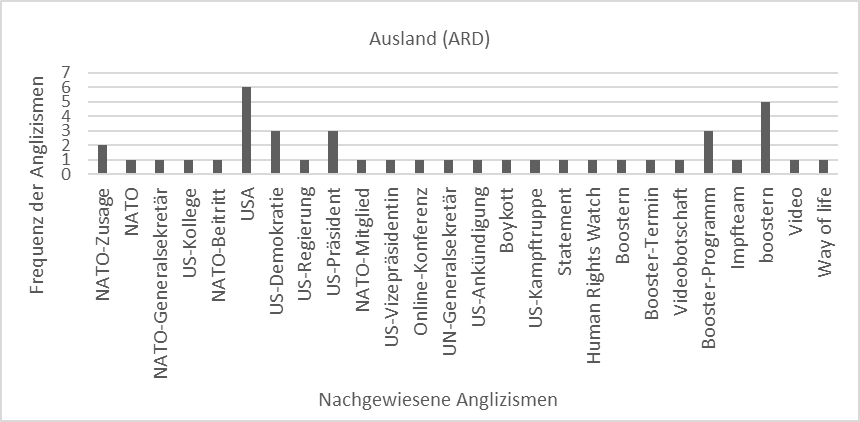
Graphische Darstellung 2. Anglizismen im Bereich Ausland in der Online-Tagesschau (ARD)
Wirtschaft
Das Korpus dieses Themenbereichs umfasst 2993 Wörter. Davon gehören 1667 zu den relevanten Wortgruppen und 77 sind Anglizismen. Die Abkürzungen FBA (Fulfillment by Amazon) und CMA (Competition and Markets Authority) wurden in keinem der beiden Nachschlagewerke nachgewiesen, wie auch einige Mischkomposita (Clip-Plattform, US-Riese…). Bezüglich der relevanten Wortgruppen beträgt der Prozentsatz der Anglizismen 4,62%. Hier kann man wiederum erkennen, dass der Anteil der Anglizismen ebenfalls höher ist als im Vergleich zu den Kategorien Innenpolitik und Ausland.
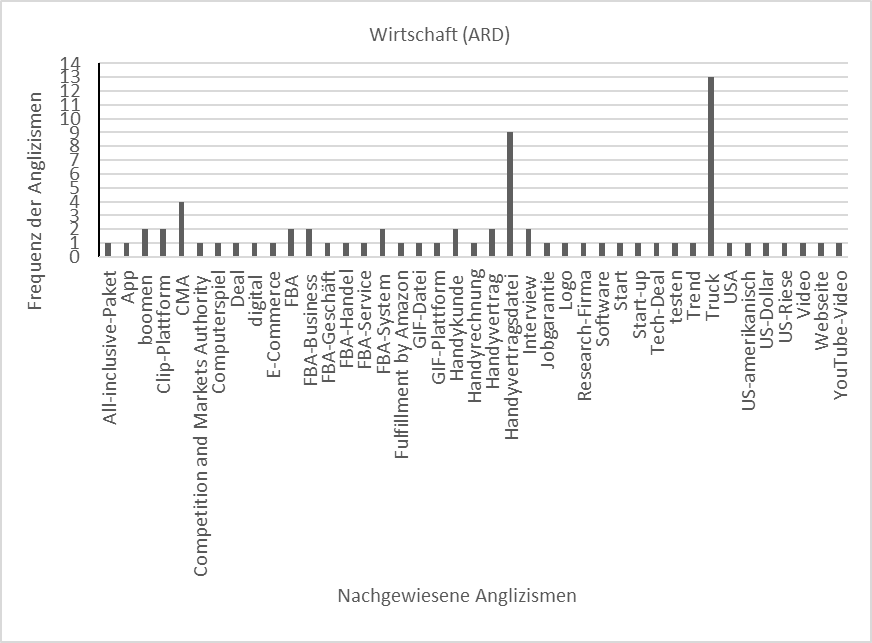
Graphische Darstellung 3. Anglizismen im Bereich Wirtschaft in der Online-Tagesschau (ARD)
Technologie
Das Korpus dieser Kategorie beinhaltet 3368 Wörter, davon gehören 1793 zu den relevanten Wortgruppen und 93 zu den Anglizismen. Einige Begriffe wie Biohub, Multiroom-Lautsprecher und Security Gateway werden dabei in keinem der beiden Nachschlagewerke gefunden. Der Anteil der Anglizismen in Hinsicht auf die relevanten Wortgruppen beträgt 5,19%.
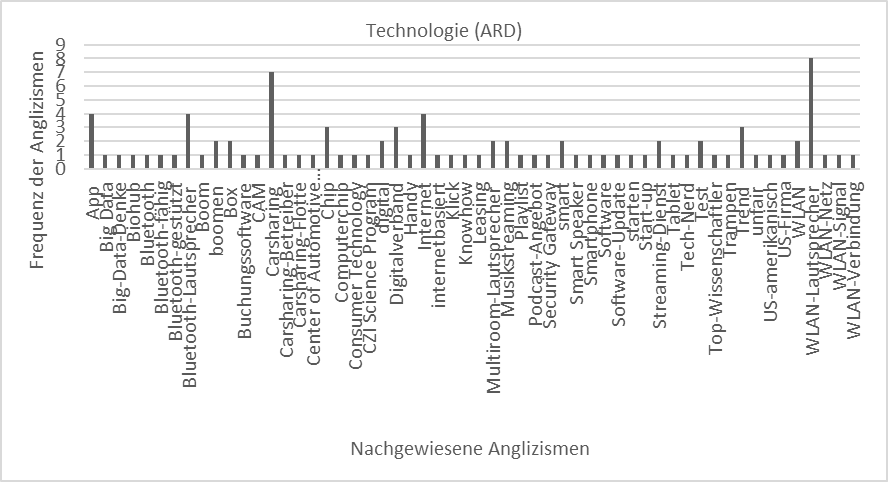
Graphische Darstellung 4. Anglizismen im Bereich Technologie in der Online-Tagesschau (ARD)
Sport
Dieses Korpus beinhaltet insgesamt 2237 Wörter und davon gehören 1234 zu den relevanten Wortgruppen. In diesem Themenbereich wurden 82 Anglizismen nachgewiesen, davon wurden einige Begriffe wie General Manager, Racing-Modus und Runningback sowie die anglistischen Abkürzungen NBA und NHL weder im Anglizismen-Index noch im Online-Wörterbuch des Dudens gefunden.
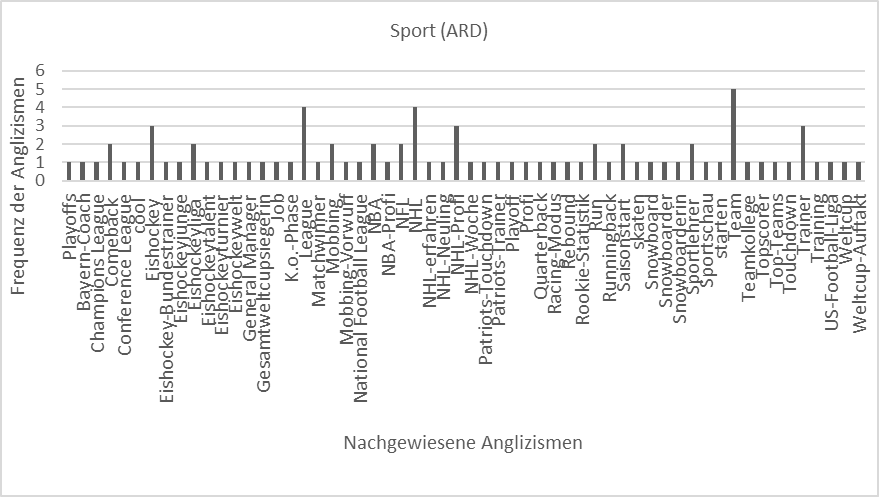
Graphische Darstellung 5. Anglizismen im Bereich Sport in der Online-Tagesschau (ARD)
Bezüglich der relevanten Wortgruppen beträgt der Prozentsatz der Anglizismen 6,65% in diesem Themenbereich. Die Kategorie Sport beinhaltet in dieser Stichprobe die meisten Anglizismen.
Anzahl der Anglizismen in den deutschen Online-RTL-Nachrichten des privaten Fernsehsenders RTL
Innenpolitik
Das Korpus der Innenpolitik beinhaltet insgesamt 1120 Wörter und davon gehören 606 Wörter den Wortkategorien Substantiv, Verb und Adjektiv an. In diesem Themenbereich wurden insgesamt 8 Anglizismen nachgewiesen, davon wurde nur das Wort Superspreader-Event weder im Anglizismen-Index noch im Onlinewörterbuch des Dudens gefunden. Hinsichtlich der relevanten Wortgruppen beträgt der Prozentsatz der Anglizismen in diesem Bereich 1,32%.
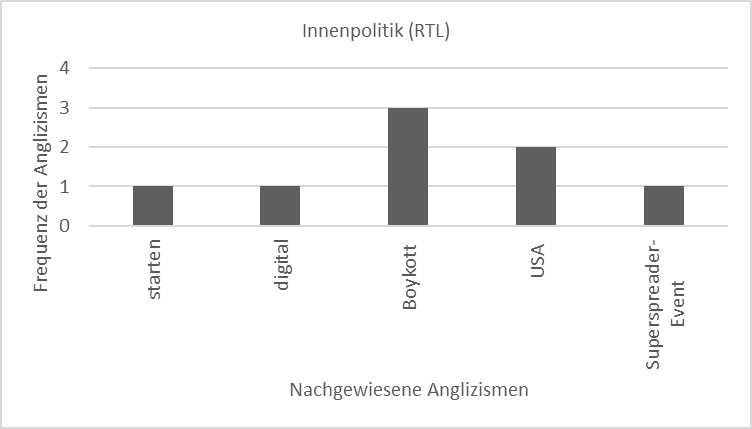
Graphische Darstellung 6. Anglizismen im Bereich Innenpolitik in den Online- RTL-Nachrichten
Ausland
Dieses Korpus umfasst insgesamt 2094 Wörter, davon gehören 1204 zu den relevanten Wortgruppen und in diesem Bereich wurden 63 Anglizismen nachgewiesen. Wörter wie Swift-System und US-Sanktion sowie die englischen Abkürzungen ARTF und IRC wurden in keinem der beiden Nachschlagewerke gefunden. In Hinsicht auf die relevanten Wortgruppen beträgt der prozentuale Anteil der Anglizismen in diesem Themenbereich 5,23%.
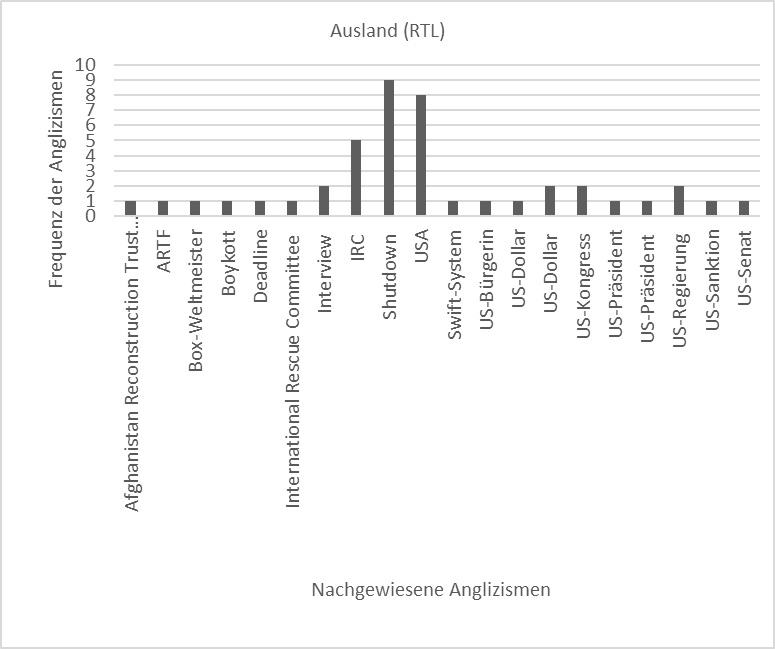
Graphische Darstellung 7. Anglizismen im Bereich Ausland in den Online-RTL-Nachrichten
Wirtschaft
Im Themenbereich Wirtschaft enthält das Korpus 1737 Wörter. 940 dieser Wörter gehören zu den relevanten Wortgruppen und davon sind 18 Anglizismen. Mischkomposita wie Rekordhoch und Rekordwert wurden in keinem der beiden Nachschlagewerke gefunden.
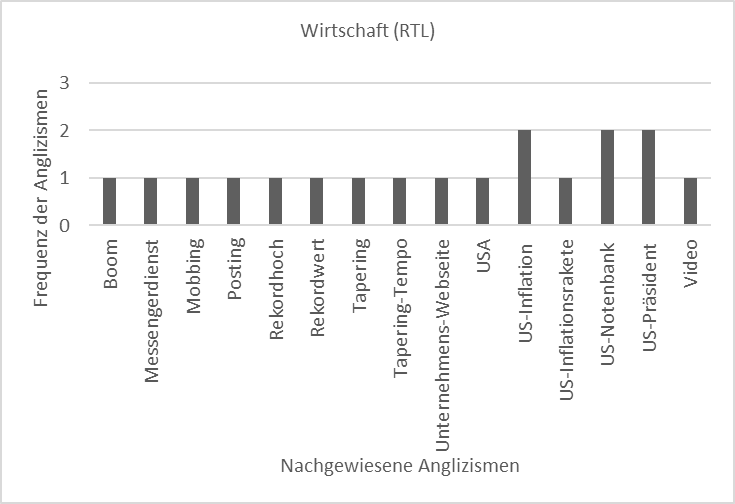
Graphische Darstellung 8. Anglizismen im Bereich Wirtschaft in den Online-RTL-Nachrichten
Hinsichtlich der relevanten Wortgruppen beträgt der Prozentsatz der Anglizismen im Themenbereich Wirtschaft 1,92%. Dementsprechend weist dieser Themenbereich in den Online-RTL-Nachrichten am zweitwenigsten Anglizismen auf.
Technologie
Das Korpus dieser Kategorie beinhaltet 1136 Wörter, von denen 637 zu den relevanten Wortgruppen gehören und davon wurden 40 Anglizismen nachgewiesen. Mischkomposita wie Computersabotage und Cyber-Straftat wurden in keinem der beiden Nachschlagewerke nachgewiesen. Der Anteil der Anglizismen hinsichtlich der relevanten Wortgruppen beträgt 6,28% in diesem Bereich.
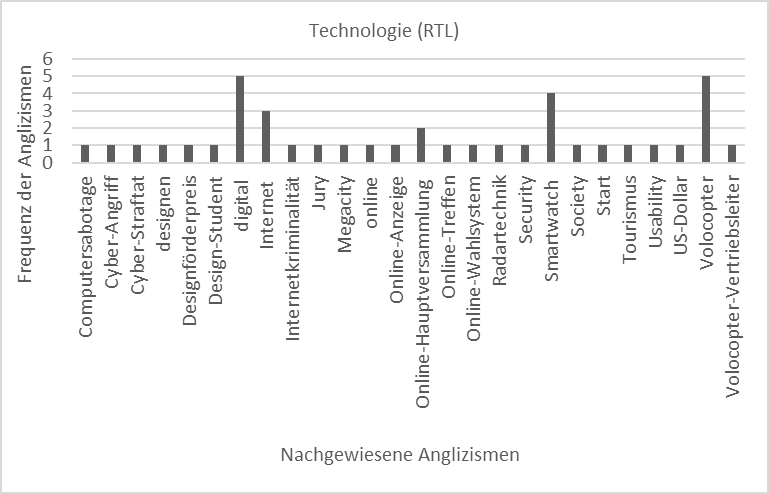
Graphische Darstellung 9. Anglizismen im Bereich Technologie in den Online-RTL-Nachrichten
Sport
Das Korpus der Kategorie Sport beinhaltet insgesamt 1160 Wörter, davon gehören 624 zu den relevanten Wortgruppen und dieser Themenbereich zählt gesamt 52 Anglizismen. Die Begriffe Fullback, Mixed-Event und Snowboardcrosser wurden weder im Anglizismen-Index noch im Onlinewörterbuch des Dudens gefunden. Der prozentuale Anteil der Anglizismen beträgt in diesem Bereich 8,33%. Die Kategorie Sport beinhaltet daher in dieser Stichprobe am meisten Anglizismen.

Graphische Darstellung 10. Anglizismen im Bereich Sport in den Online-RTL-Nachrichten
Anzahl der Anglizismen in den ORF Onlinenachrichten, des österreichischen öffentlich-rechtlichen Fernsehsenders ORF
Innenpolitik
Das Korpus der Innenpolitik beinhaltet insgesamt 1782 Wörter und davon gehören 919 Wörter den Wortkategorien Substantiv, Verb und Adjektiv an, die relevant für den Vergleich sind. In diesem Themenbereich wurden insgesamt 15 Anglizismen nachgewiesen, die Mischkomposita FFP2-Maskenpflicht und Testinfrastruktur wurden in keinem der beiden Nachschlagewerke nachgewiesen. Der Prozentanteil der Anglizismen in Bezug auf die relevanten Wortgruppen beträgt 1,63%.
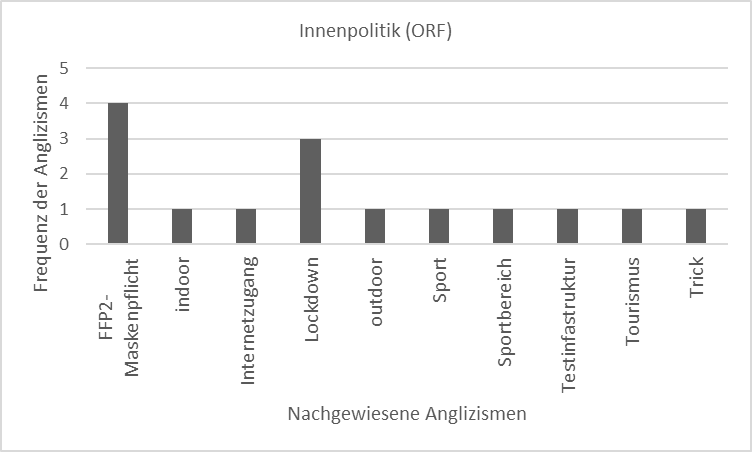
Graphische Darstellung 11. Anglizismen im Bereich Innenpolitik in den Online-ORF-Nachrichten
Ausland
Im Themenbereich Ausland enthält das Korpus 1301 Wörter. 763 dieser Wörter gehören zu den relevanten Wortgruppen, davon sind 9 Anglizismen und nur das Mischkompositum Kulturmanagerin wurde in keinem der beiden Nachschlagewerke nachgewiesen.
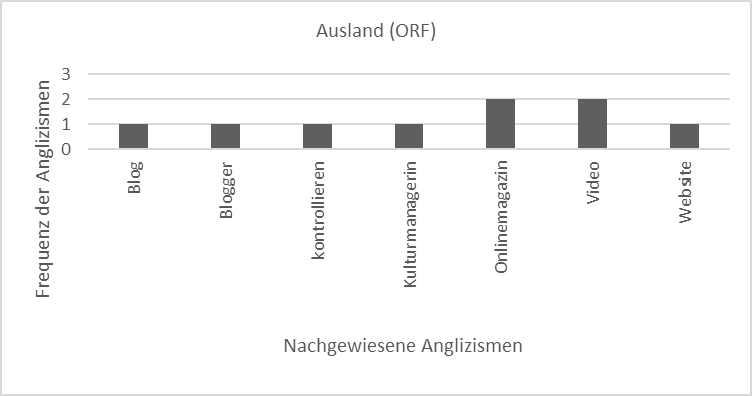
Graphische Darstellung 12. Anglizismen im Bereich Ausland in den Online-ORF-Nachrichten
Bezüglich der relevanten Wortgruppen beträgt der Prozentsatz der Anglizismen 1,18%. Damit enthält der Bereich Ausland im Vergleich zu den anderen Kategorien am wenigsten Anglizismen.
Wirtschaft
Das Korpus dieser Kategorie beinhaltet 1242 Wörter, von denen 657 zu den relevanten Wortgruppen gehören und davon sind 33 Anglizismen. Die Wörter E-Control, Smart Meter und Year-ahead-Preis werden dabei in keinem der beiden Nachschlagewerke gefunden. Der Anteil der Anglizismen in Hinsicht auf die relevanten Wortgruppen beträgt 5,02% in diesem Bereich.
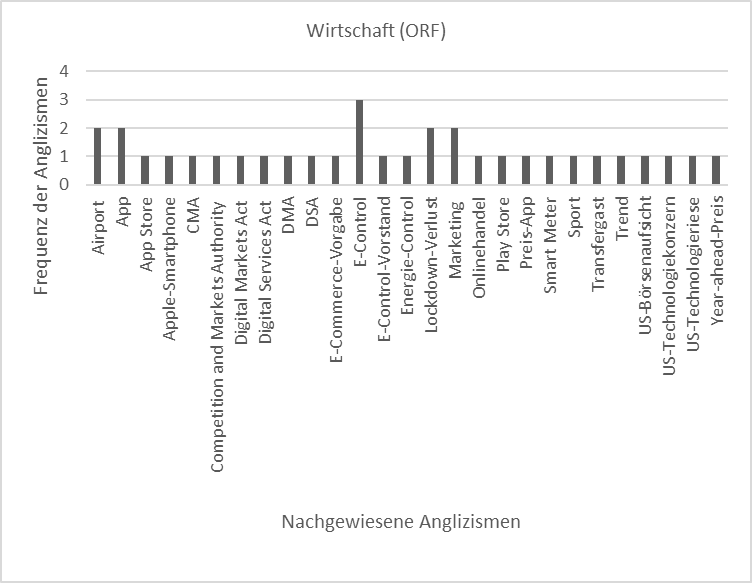
Graphische Darstellung 13. Anglizismen im Bereich Wirtschaft in den Online-ORF-Nachrichten
Technologie
Dieses Korpus beinhaltet insgesamt 2422 Wörter und davon gehören 1358 zu den relevanten Wortgruppen. Es wurden 41 Anglizismen nachgewiesen, hierbei wurden die Wörter Digitalcomputer, High Performance-Computing und Trust Barometer in keinem der beiden Nachschlagewerke gefunden. In Bezug auf die relevanten Wortgruppen beträgt der prozentuale Anteil der Anglizismen 3,02% in diesem Themenbereich.

Graphische Darstellung 14. Anglizismen im Bereich Technologie in den Online-ORF-Nachrichten
Sport
Das Korpus beinhaltet insgesamt 615 Wörter, davon sind 344 relevant für den Vergleich. In diesem Themenbereich wurden insgesamt 35 Anglizismen nachgewiesen, davon wurden die Wörter Interception, Topclub und Touchdownwurf in keinem der beiden Nachschlagewerke nachgewiesen.
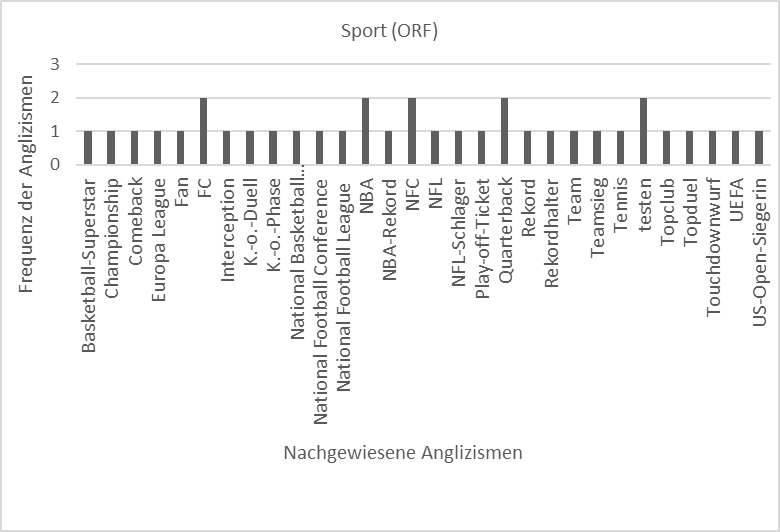
Graphische Darstellung 15. Anglizismen im Bereich Sport in den Online-ORF-Nachrichten
Hinsichtlich der relevanten Wortgruppen beträgt der Prozentsatz der Anglizismen in diesem Bereich 10,17%, was im Vergleich zu den anderen Themenbereichen am meisten ist.
##### **Anzahl der Anglizismen in den Puls 24-Nachrichten, des privaten Fernsehsenders Puls 24**
Innenpolitik
Das Korpus der Innenpolitik beinhaltet insgesamt 2022 Wörter und davon gehören 1097 Wörter den relevanten Wortgruppen an. Es wurden insgesamt 56 Anglizismen gefunden, davon wurden die Begriffe Contact Tracing und Cyberzentrum in keinem der beiden Nachschlagewerke gefunden. Der Prozentsatz der Anglizismen macht in diesem Bereich 5,11% aus.
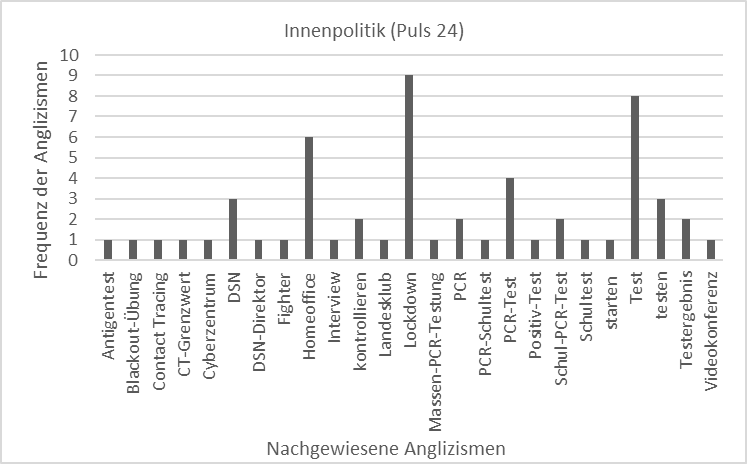
Graphische Darstellung 16. Anglizismen im Bereich Innenpolitik in den Online-Puls 24-Nachrichten
Ausland
Das Korpus umfasst insgesamt 1272 Wörter, davon gehören 708 zu den relevanten Wortarten. Es wurden 26 Anglizismen nachgewiesen, davon wurden Begriffe wie Festival of Remembrance und Software-Unternehmen in keinem der beiden Nachschlagewerke nachgewiesen. Der prozentuale Anteil der Anglizismen ergibt in diesem Themenbereich 3,67%.
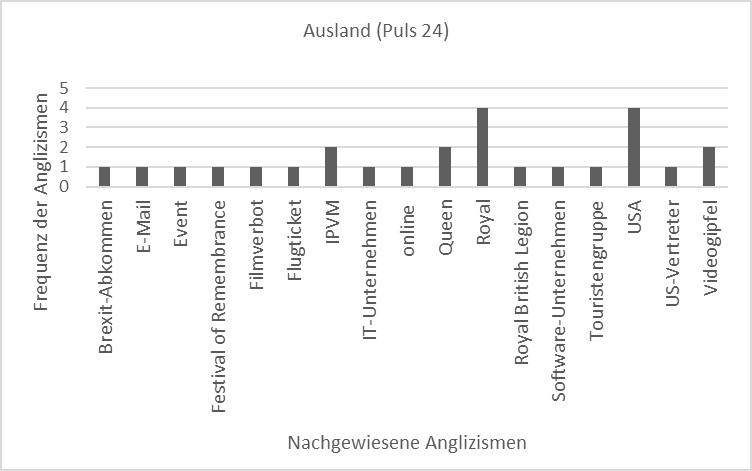
Graphische Darstellung 17. Anglizismen im Bereich Ausland in den Online-Puls 24-Nachrichten
Wirtschaft
Das Korpus dieses Themenbereichs zählt insgesamt 1672 Wörter. 912 davon gehören zu den relevanten Wortgruppen. Es wurden 37 Anglizismen nachgewiesen, wobei die Begriffe Tapering und LBBW-Analyst in keinem der beiden Nachschlagewerke aufgelistet sind. Der Anteil der Anglizismen beträgt 4,06% in diesem Bereich.

Graphische Darstellung 18. Anglizismen im Bereich Wirtschaft in den Online-Puls 24-Nachrichten
Technologie
Das Korpus dieser Kategorie beinhaltet 1909 Wörter, von denen 990 zu den relevanten Wortgruppen gehören. 80 Anglizismen wurden nachgewiesen, doch Begriffe wie Cybermobber, Distance Learning und Non-Fungible Token wurden in keinem der beiden Nachschlagewerke nachgewiesen. Hinsichtlich auf die relevanten Wortgruppen beträgt der prozentuale Anteil der Anglizismen 8,08% in diesem Themenbereich.
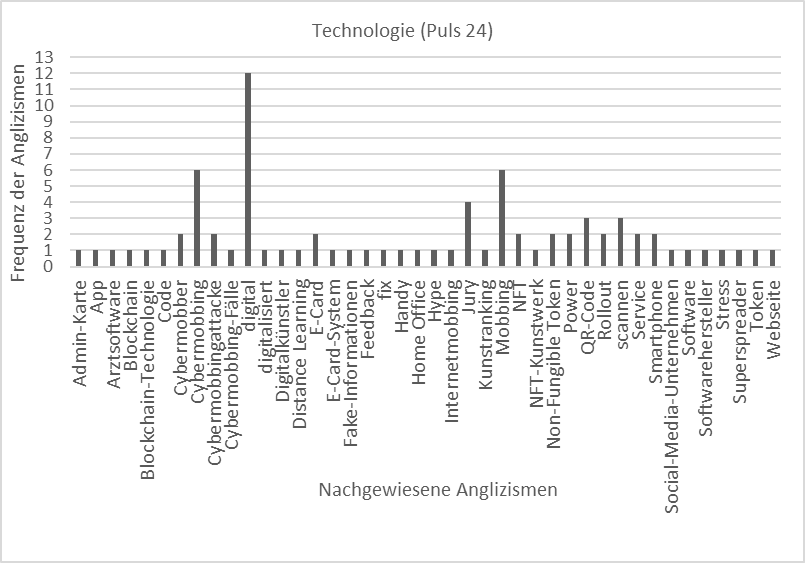
Graphische Darstellung 19. Anglizismen im Bereich Technologie in den Online-Puls 24-Nachrichten
Sport
Die Kategorie Sport beinhaltet insgesamt 1724 Wörter. Von den 928 relevanten Wörtern sind 95 Anglizismen. In Bezug auf die relevanten Wortgruppen beträgt der Prozentanteil der Anglizismen 10,24%. In der Kategorie Sport wurden daher am meisten Anglizismen nachgewiesen.
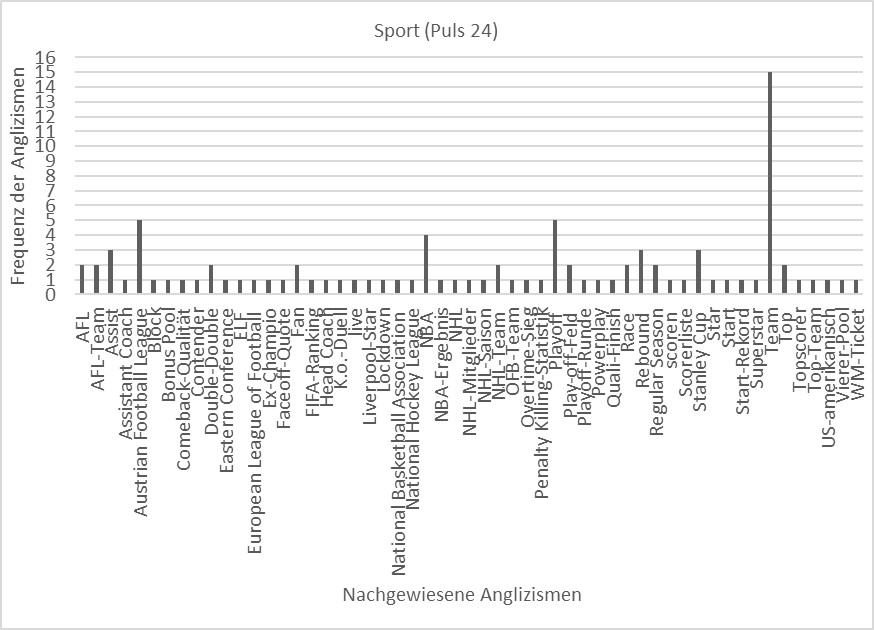
Graphische Darstellung 20. Anglizismen im Bereich Sport in den Online-Puls 24-Nachrichten
Vergleich - Anglizismen in deutschen und österreichischen Onlinenachrichten
In dieser Arbeit wurden Anglizismen nach der Häufigkeit ihrer Verwendung in Onlinenachrichten öffentlich-rechtlicher und privater Fernsehsender untersucht. Gesondert wurde die Verwendungshäufigkeit der Anglizismen in deutschen Onlinenachrichten des öffentlich-rechtlichen Fernsehsenders ARD und des privaten Fernsehsenders RTL verglichen und die Gebrauchshäufigkeit der Anglizismen in österreichischen Onlinenachrichten des öffentlich-rechtlichen Fernsehsenders ORF und des privaten Fernsehsenders Puls 24. Ebenfalls wurde untersucht, ob Anglizismen häufiger in deutschen oder österreichischen Onlinenachrichten öffentlich-rechtlicher und privater Fernsehsender verwendet werden.
Ergebnisse der Untersuchung bezüglich des Vergleichs der Anglizismen in den deutschen öffentlich-rechtlichen und privaten Fernsehsender (ARD und RTL)
Die erste Hypothese, von der man in dieser Arbeit ausging, war, dass in Bezug auf die deutschen Onlinenachrichten, der private Fernsehsender RTL insgesamt mehr Anglizismen beinhalten wird als die Onlinenachrichten des öffentlich-rechtlichen Fernsehsenders ARD. Diese Annahme wurde durch die Resultate der Untersuchung bestätigt.
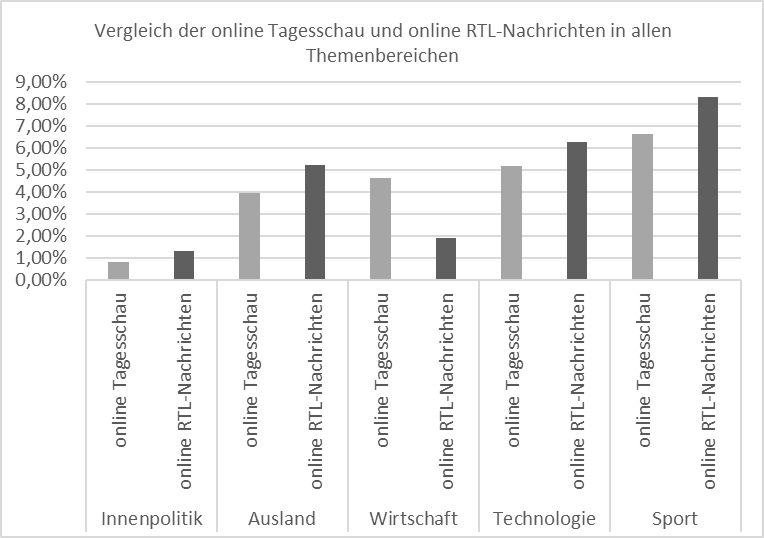
Graphische Darstellung 21. Die Anglizismen und deren Prozentzahl in allen Bereichen im Vergleich der Online-Tagesschau und Online RTL-Nachrichten
Wie man aus der graphischen Darstellung erkennen kann, wurden in den Online-RTL-Nachrichten mehr Anglizismen nachgewiesen, und zwar in fast allen Themenbereichen, außer in der Kategorie Wirtschaft.
Der Prozentanteil aller Anglizismen (305 Wörter) im Vergleich zu den relevanten Wortarten (7001 Wörter) ergibt bei der Online-Tagesschau 4,36%. Bei den Online-RTL-Nachrichten ist dagegen der Prozentanteil aller Anglizismen (181Wörter) im Vergleich zu den relevanten Wortarten (4011 Wörter) 4,51%.
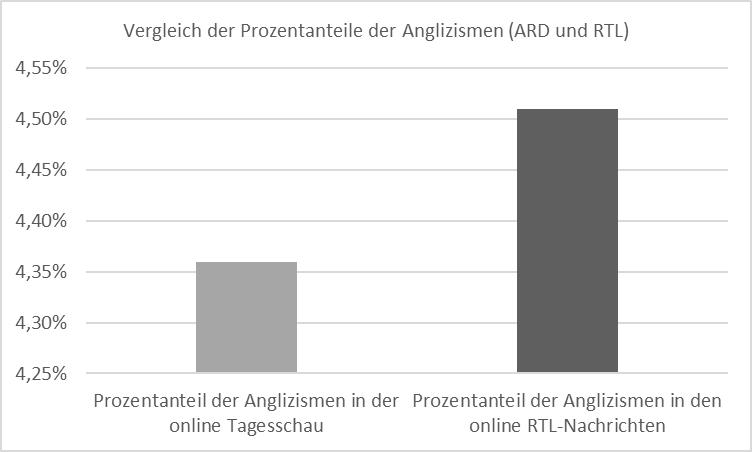
Graphische Darstellung 22. Vergleich der Prozentanteile der Anglizismen zwischen der Online-Tagesschau und den Online-RTL-Nachrichten
##### **Ergebnisse der Untersuchung bezüglich des Vergleichs der Anglizismen in den österreichischen öffentlich-rechtlichen und privaten Fernsehsender (ORF und Puls 24)**
Die zweite Hypothese war, dass in Bezug auf die österreichischen Onlinenachrichten, der private Fernsehsender Puls 24 insgesamt mehr Anglizismen beinhalten wird als die Onlinenachrichten des öffentlich-rechtlichen Fernsehsenders ORF. Diese Annahme wurde durch die Resultate der Untersuchung ebenfalls bestätigt.
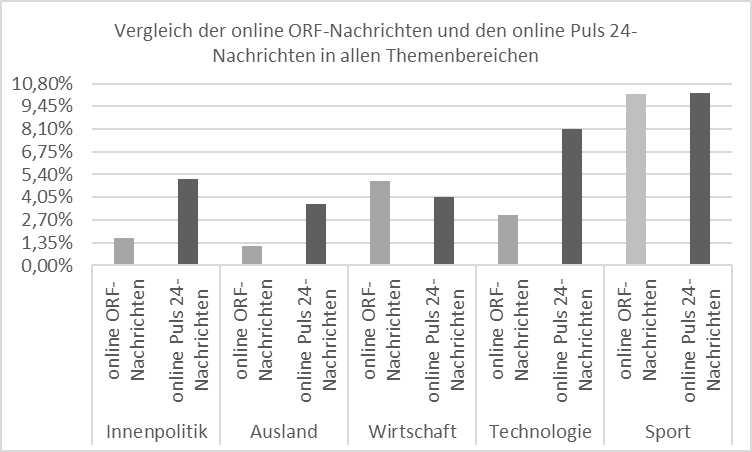
Graphische Darstellung 23. Die Anglizismen und deren Prozentzahl in allen Bereichen im Vergleich der Online-ORF-Nachrichten und den Online-Puls 24-Nachrichten
Aus der graphischen Darstellung ist zu erkennen, dass in den privaten Onlinenachrichten des Fernsehsenders Puls 24 mehr Anglizismen nachgewiesen wurden, und zwar ebenfalls in allen Themenbereichen, außer in der Kategorie Wirtschaft.
Der Prozentsatz der gesamten Anglizismen (133 Wörter) im Vergleich zu den relevanten Wortarten (4041 Wörter) ergibt bei den Online-ORF-Nachrichten 3,29%. Bei den Online-Puls 24-Nachrichten ist dagegen der Prozentanteil aller Anglizismen (294 Wörter) im Vergleich zu den relevanten Wortarten (4635 Wörter) 6,34%.
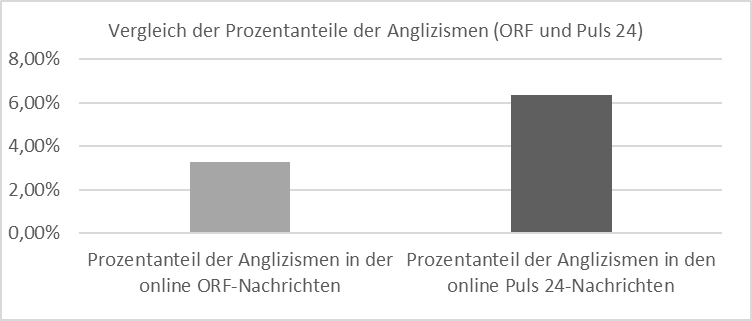
Graphische Darstellung 24. Vergleich der Prozentanteile der Anglizismen zwischen der ORF-Nachrichten und den Online-Puls 24 - Nachrichten
##### **Ergebnisse der Untersuchung bezüglich des Vergleichs der Anglizismen in den deutschen Onlinenachrichten (ARD und RTL) und den österreichischen Onlinenachrichten (ORF und Puls 24)**
Die dritte Hypothese dieser Arbeit war, dass im Vergleich in den deutschen Onlinenachrichten der privaten sowie öffentlich-rechtlichen Fernsehsender (RTL und ARD) mehr Anglizismen benutzt werden als in den österreichischen Onlinenachrichten der privaten und öffentlich-rechtlichen Fernsehsender (ORF und Puls 24). Diese Annahme wurde durch die Resultate der Untersuchung nicht bestätigt.
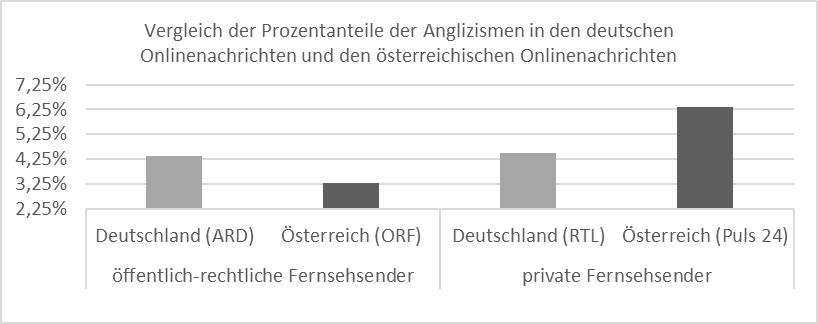
Graphische Darstellung 25. Vergleich der Prozentanteile der Anglizismen in den deutschen Onlinenachrichten (ARD und RTL) und den österreichischen Onlinenachrichten (ORF und Puls 24)
Aus der graphischen Darstellung kann man schließen, dass die deutschen öffentlich-rechtlichen Onlinenachrichten des Fernsehsenders ARD mehr Anglizismen aufweisen als die österreichischen Onlinenachrichten des öffentlich-rechtlichen Senders ORF. Bei den privaten Fernsehsendern ist es umgekehrt: in den österreichischen Onlinenachrichten des privaten Senders Puls 24 wurden mehr Anglizismen nachgewiesen als in den Onlinenachrichten des privaten Fernsehsenders ORF.
Doch der Prozentanteil aller Anglizismen in den deutschen Onlinenachrichten (486 Anglizismen) im Vergleich zu den relevanten Wortarten (11012 Wörter) ergibt 4,41%. Bei den österreichischen Onlinenachrichten ist dagegen der Prozentanteil aller Anglizismen (427 Anglizismen) im Vergleich zu den relevanten Wortarten (8676) 4,92%.
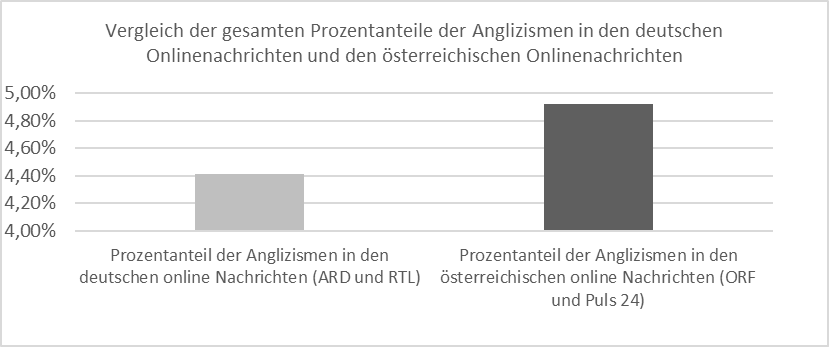
Graphische Darstellung 26. Vergleich der gesamten Prozentanteile der Anglizismen in den deutschen Onlinenachrichten (ARD und RTL) und den österreichischen Onlinenachrichten (ORF und Puls 24)
##### **Diskussion der Ergebnisse**
Die Ergebnisse der Untersuchung haben gezeigt, dass sowohl in den deutschen wie auch in den österreichischen Onlinenachrichten, die privaten Fernsehsender (RTL und Puls 24) mehr Anglizismen benutzt haben als die öffentlich-rechtlichen Fernsehsender (ARD und ORF). Weiter wurde durch die Untersuchung festgestellt, dass die österreichischen Onlinenachrichten der öffentlich-rechtlichen und privaten Fernsehsender mit 4,92% etwas mehr Anglizismen benutzen als die deutschen Onlinenachrichten der öffentlich-rechtlichen und privaten Fernsehsender (4,41%). Allerdings handelt es sich hierbei um stichprobenartig ausgewählte Texte, die zwar aus den gleichen Kategorien stammen, jedoch oft nicht den gleichen thematischen Inhalten entsprachen. Da weitere Arbeiten unbekannt sind, die die Verwendungshäufigkeit der Anglizismen in deutschen sowie österreichischen öffentlich-rechtlichen und privaten Fernsehsendern untersucht haben, kann man die Resultate dieser Arbeit mit anderen nicht vergleichen.
##### **Schlussfolgerung**
Das Thema dieser Arbeit wurde ausgewählt aufgrund der zunehmenden Verbreitung des Englischen in allen Bereichen der deutschen Sprache, insbesondere in der Onlinewelt, womit auch die Onlinenachrichten mitbeeinflusst sind. Die Untersuchung hat gezeigt, dass im Sprachgebrauch der deutschen und österreichischen Onlinenachrichten die Anglizismen einen festen Platz eingenommen haben. Der Anteil der Anglizismen ist zwar mit 4,41% in den deutschen und 4,92% in den österreichischen Onlinenachrichten der öffentlich-rechtlichen und privaten Fernsehsender gering, jedoch haben die Onlinenachrichten damit einen direkten Einfluss auf die Verbreitung der Anglizismen und dadurch wiederum auf den Sprachwandel im Allgemeinen. Der Sprachwandel ist ein natürlicher Prozess und jede Sprache ist in gewissem Maße davon betroffen, aber insbesondere Informationsmedien sollten versuchen, die deutsche Standardsprache so weit wie möglich beizubehalten. Der Anglizismen-Index von Elfers (2021) bietet konkret viele Alternativen an um Anglizismen mit deutschen Wörtern zu ersetzen und um dadurch das Denglisch so gut wie möglich zu vermeiden. Da für die Untersuchung dieser Arbeit nur stichprobenartig Texte aus verschiedenen Themenbereichen ausgewählt wurden, sollten weitere Untersuchungen durchgeführt werden, um genauere Ergebnisse zu gewinnen.
##### **Literatur**
Adler, M. (2004). Form und Häufigkeit der Verwendung von Anglizismen in deutschen und schwedischen Massenmedien. Verfügbar unter https://www.db-thueringen.de/receive/dbt\_mods\_00002162 \[3.3.2022.\]
Altleitner, M. (2007). Der Wellness-Effekt: Die Bedeutung von Anglizismen aus der Perspektive der kognitiven Linguistik. Frankfurt am Main: P. Lang.
Bohmann, S. (1996). Englische Elemente im Gegenwartsdeutsch der Werbebranche. Marburg: Tectum Verlag.
Burmasova, S. (2010). Empirische Untersuchung der Anglizismen im Deutschen am Material der Zeitung Die Welt (Jahrgänge 1994 und 2004). Bamberg: University of Bamberg Press. Verfügbar unter http://www.opus-bayern.de/uni-bamberg/ \[22.2.2022.\]
Carstensen, B. (1980). Semantische Scheinentlehnungen des Deutschen aus dem Englischen. In Viereck, Wolfgang (Hg.), Studien zum Einfluss der englischen Sprache auf das Deutsche (S. 77–100). Tübingen.
Carstensen, B., Busse, U. (1994). Anglizismen-Wörterbuch: Der Einfluß des Englischen auf den deutschen Wortschatz nach 1945. Berlin: de Gruyter
Duckworth, D. (1979). Der Einfluß des Englischen auf den deutschen Wortschatz seit 1945. In P. Braun (Hg.): Fremdwort-Diskussion (S. 212–245). München.
Elfers, A. (2021). Der Anglizismen-Index 2021: Deutsch statt Denglisch. Zürich: Sammelverlag.
Glahn, R. (2002). Der Einfluß des Englischen auf gesprochene deutsche Gegenwartssprache. Eine Analyse öffentlich gesprochener Sprache am Beispiel von „Fernsehdeutsch“. (2. Auflage). Frankfurt am Main, Wien: P. Lang.
Kupper, S. (2011). Anglizismen in deutschen und französischen Werbeanzeigen: Zum Umgang von Deutschen und Franzosen mit Anglizismen. Tübigen: Tectum Verlag.
Mayer, L., Putnik, M. (2011). Von Powerfrauen bis Junk-Food-Essern: Anglizismen in der Sprache deutscher Frauenzeitschriften. Zbornik za jezike i književnosti Filozofskog fakulteta u Novom Sadu (S. 131–145). Novi Sad: Faculty of Philosophy, University of Novi Sad.
Yang, W. (1990). Anglizismen im Deutschen am Beispiel des Nachrichtenmagazins Der Spiegel. Tübigen: Max Niemeyer Verlag.
Zimmer, D. E. (1997). Deutsch und anders: Die Sprache im Modernisierungsfieber. Reinbek bei Hamburg: Rowohlt.
Zindler, H. (1959). *Anglizismen in der deutschen Presse nach 1945.* (Doktorarbeit). Kiel: University of Kiel.
|
[](https://hub.ufzg.hr/uploads/images/gallery/2022-10/stoo2.png)
| *2. međunarodna znanstvena i umjetnička konferencija Učiteljskoga fakulteta Sveučilišta u Zagrebu Suvremene teme u odgoju i obrazovanju – STOO2 - in memoriam prof. emer. dr. sc. Milanu Matijeviću, Zagreb, Hrvatska*
|
| ##### **Anglizmi u njemačkim i austrijskim online vijestima privatnih i javnih televizijskih kanala**
|
| ##### **Sažetak**
|
| Cilj ovog rada je utvrditi učestalost anglizama u njemačkim i austrijskim online vijestima javnih i privatnih televizijskih kanala. Korpus istraživanja čine nasumice odabrani tekstovi iz domena unutarnje politike, vanjske politike, ekonomije, tehnologije i sporta. Postoje različite definicije pojma *anglizam*, ali se u ovom radu kreće od definicije anglizma kao nadređenog pojma za formalne jezične posudbe iz engleskog govornog područja. Za njemačke online vijesti za analizu su odabrani tekstovi s online vijesti *Tagesschau* i *RTL*, a za austrijske online vijesti *ORF* i *Puls24*. U jednomjesečnom intervalu odabrano je pet tekstova iz svakog od gore navedenih područja. Rezultati su pokazali da u Njemačkoj postoje, iako neznatne, razlike između učestalosti uporabe anglizama između online vijesti javnih i privatnih televizijskih kanala. Razlika u učestalost uporabe anglizama u Austriji između online vijesti javnih i privatnih televizijskih kanala bila je izraženija nego u Njemačkoj. Uspoređujući pak njemačke i austrijske online vijesti, u online vijestima privatne televizije *Puls24* u Austriji korišteno je više anglizama nego u online vijestima njemačkog *RTL-a*. Što se tiče javnih televizijskih kanala, online vijesti *Tagesschau* koristile su više anglizama u odnosu na austrijske online *ORF* vijesti. Međutim, ukupno gledajući, udio anglizama je relativno nizak kako u njemačkim, tako u austrijskim online vijestima televizijskih kanala, no prisutni su bili u svim područjima. To je dovelo do zaključka da anglizmi imaju stalno mjesto u njemačkim i austrijskim vijestima te zbog velike gledanosti imaju izravan utjecaj na širenje anglizama, što pak utječe na jezične promjene u njemačkom jeziku.
|
| ***Ključne riječi***
|
| *jezično posuđivanje; anglizmi; online vijesti; televizija*
|
# Augmented reality in the educational setting: content and language integrated learning of English and Science
| ##### **Kristina Cergol, Valentina Gučec**
*University of Zagreb, Faculty of Teacher Education*
|
| **Foreign languages education and research**
| Number of the paper: 74 | **Original scientific paper**
|
| ##### **Abstract**
|
| Augmented reality (AR) is a type of immersive technology by means of which digital items are added to a live view of the physical world to yield improved user experience. AR has found its place in education as various virtual elements can be generated by means of ready-made and custom-programmed applications for widely used devices (e.g. android mobile phones). Virtual elements are then integrated with the real-world environment creating a close-to-authentic learning situation that is in line with the situated learning framework. One precondition for this is access to visual images that encompass a number of attributes required for AR presentation. In this paper we focus on the five most prominent visual attributes: *richness in detail, good contrast, absence of repetitive patterns, inclusion of letters, no gloss paper*. Concentrating on these five attributes we use the content analysis methodology to investigate the possibility of using AR with the existing visual images in the English and Science textbooks in Croatian primary schools, grades 1-4 and find that the existing visuals already possess a high level of integration of the necessary attributes. Further, we propose a list of content and language integrated learning (CLIL) topics, integrating English and Science in the teaching and learning process in grades 1-4, and analyse the selected CLIL topics in terms of the presentability of the related existing textbook images by means of AR. Suggestions for the improvement of textbook images so that they may be presented using AR are given. Finally, some guidelines for the creation of the CLIL AR textbooks are provided as a suggestion for further endeavours in the field.
|
| ***Key words***
|
| *AR attributes; CLIL topics; CLIL AR textbooks; primary school; situated learning framework*
|
##### **Introduction**
This study tackles the possibilities of using cutting-edge technologies on the basis of the existing teaching materials. The theoretical basis used as the framework for this paper is twofold. We first draw on the postulates of the situated learning theory as the overarching theoretical framework. Moreover, we look at the possibilities of the usage of augmented reality (AR), as the now widely accessible technology, combined with the textbook as the primary English as a foreign language (EFL) teaching material. For the mentioned purposes we analyse the pictures contained in the selected textbooks to establish if they meet the criteria necessary for presentation by means of the AR technology. Even though the textbook is not necessarily the teaching material that has been designed for situated learning, we believe that the path we have chosen presents the first step towards a more inclusive usage of AR as a cognitively more easily accessible means of presenting the teaching material. In line with this, AR presentations can be used to envisage and create situations eligible for situated learning, taking into consideration the benefits of the physical or virtual context and based on the task-based approach to foreign language learning. Finally, to create a setting for our study, we investigate the augmented reality technology usage for EFL in the context of the recommended content and language integrated learning (CLIL) approach, merging the topics from the English language and Science subjects and focusing on early English language learning (grades 1-4; ages 6-10).
##### **Situated learning**
The theory of situated learning focuses on the “situated character of human understanding and communication” (Lave & Wenger, 1991, p. 14), stressing that the best form of learning and instruction is realized in the situational context (or, we add, a simulation thereof) in which the learned materials and skills are to be further utilized, as well as the sociocultural context as a milieu particularly relevant for foreign language learning. We stress simulation as a link that can be realized by means of modern technologies, such as the augmented reality technologies, to recreate the desired real-life context in the situation of formal instruction. In this paper we focus on English language learning integrated with Science in primary education. Within the situated learning theory, the physical context presents itself as the decisive factor in learning English as a foreign language in the institutional setting as research has shown that the presence of physical context induces foreign language learning (Cergol, 2007). One approach that is in line with the situated learning theory in foreign language learning is the task-based approach. Tasks are defined as “classroom activities in which learners use language ‘pragmatically’, that is, ‘to do things’ with the overriding aim of learning language” (Bygate, 2015, p. 1). Along those lines task-based language teaching is defined as the approach to second language acquisition and learning in which tasks are viewed as critical activities yielding language acquisition and learning (Ellis, 2003). It is believed that this approach induces incidental language acquisition as the students focus on the task they are required to perform while they use the target language as a tool rather than the target itself (Ellis, Skehan, Shaofeng, Natsuko, & Lambert, 2020). Task-based activities realized by means of AR technology in which virtual elements are superposed onto the real-life context may be the future of technologically enhanced classroom learning.
##### **Augmented reality in education**
At this day and age situated learning can be enhanced by means of augmented reality technology. Augmented reality (AR) is a type of immersive technology by means of which digital items are added to a live view of the physical world and can be attached to real locations and objects. Immersive are such technologies that intertwine the elements of digitally simulated and physical worlds to yield improved user experience. Virtual reality (VR) is an immersive technology that refers to a digitally-generated setting into which a user is fully immersed in such a way that they feel no connection to the real world. Together with mixed reality, which is a combination of AR and VR, these technologies fall under the umbrella concept of extended reality (ER). Milgram, Takemura, Utsumi & Kishino (1994) propose a reality-virtuality continuum to provide a framework for the mixed reality concept. Mixed reality, being a mixture of augmented and virtual realities can fall onto any one point on the mentioned continuum, depending on whether they belong more to the virtual environment thus being classified as virtual reality, or to the real environment, a feature that classifies it as augmented reality. Augmented reality technologies are naturally connected to situated learning as they allow for the positioning of virtual objects in real space. Moreover, they provide learners with the possibility of 3D visualisation by means of user-friendly technology supported by widely accessible devices (e.g. the students’ mobile phones). In fact, it is now becoming more common for schools to allow for the “bring your own device” days when students can bring a personal device, such as a smart phone, to use in class, for the purpose of classroom activities (e.g. Annetta, Peters Burton, Frazier, Cheng, & Chmiel, 2012).
Multiple benefits of AR for educational purposes have been reported. Parmaxi and Demetriou (2020) provide a systematic overview of studies on augmented reality and language learning in the period between 2014 and 2019 and conclude that the usage of AR in education can improve learning in terms of educational outcomes, have an effect on the affective and collaborative elements of the learning process and improved focus, and be used to support students with special needs (for an overview see Parmaxi and Demetriou, 2020, p. 1). In terms of the learning process, students can get a 3D view of the object from different angles. An example is the view of an object (e.g. a bird) denoted by a linguistic sign in foreign language vocabulary acquisition activities. Virtual simulations can be carried out using AR methodology. Finally, AR methodology allows for the superposition of an additional layer of information on top of the information presented in traditional textbooks (Casteleiro-Pitrez, 2021). In terms of the benefits AR books offer, Gopalan et al (2016) stress the potential benefits of AR books for enhancing students’ interest in learning about science by means of attractive material presentation, especially in their understanding of the complex scientific processes and phenomena that are difficult to visualize and present in the classroom. In terms of early EFL Mahadzir and Phung (2013) find that pop-up AR books provide users with a feeling of satisfaction and enhance their attention and confidence. This is why AR should be considered as an improvement of a traditional textbook.
##### **EFL lexis presented by means of AR in textbooks: material requirements**
Clearly, EFL textbooks enriched with AR presentations can be viewed as a welcome and fresh means of presenting linguistic material in the study process. An obvious usage is the presentation of new lexis. In De Saussure’s terms, the AR presentation allows for the creation of connections between the signifier in a foreign language and the signified as a concept as well as the virtually presented real-world referent, due to its 3D nature of presentation. This presents an enrichment in the students’ experience that is normally achieved by means of 2D visual images in the textbook. In a nutshell, a user has a device that supports AR presentations, e.g. a smart phone. The camera is directed towards a visual item in the textbook (e.g. a picture of a bird). The 3D image of a bird then “rises out of” the textbook picture in its 3D form.
In order for the AR technology to be utilized the visual material needs to be adequately prepared. This involves creating applications for (mobile) devices targeted at the relevant lexis. There are various tools that can be used to develop AR applications for mobile devices, such as Vuforia, Wikitude, ARKit, ARCore, ARTolKit to mention just a few commonly used ones. The Vuforia Software Development Kit is a free tool that is commonly used for the development of AR applications. Moreover, Vuforia provides a useful list of attributes that need to be met to allow for the AR presentation of the chosen visual image (VuforiaTM Developer Library1). Vuforia has already been used by Croatian programmers for the purposes of designing an English language learning AR application (Balja, 2019). Drawing on Balja’s propositions and experience, we focus on the attributes of visual images deemed necessary by Vuforia for the successful design of AR applications for EFL.
They are related to the visual attributes of the image targets that need to be met, at least to a certain degree. The first one is richness in detail. Examples provided by Vuforia Developer LibraryTM are a street scene, a picture of a group of people, collages and mixtures of items. The second visual attribute is good contrast, which is exemplified by images that have bright and dark regions. Also, Vuforia recommends well-lit regions. Third is the absence of repetitive patterns which refers to avoidance of symmetry, repeated patterns and featureless areas (VuforiaTM Developer Library1). Additionally, experts recommend inclusion of letters into the image (Lea Skorin-Kapov, personal communication, February 10, 2022) which is the fourth attribute we shall use in this paper, and the possibility of the inclusion of QR codes (ibid.) that we shall not focus on. Matte surface but no gloss paper should be used (VuforiaTM Developer Library2) and this is the fifth attribute we shall look into in the present paper. We shall investigate whether the visual images contained in the textbooks for English and Science comprise the mentioned five attributes to establish if they can be used for representation by means of AR technology. We have chosen English and Science as we find that they encompass many overlapping topics available for use within the content and language integrated educational approach. This approach is known to be beneficial for pupils’ development of the English language skills as well as their knowledge of other subject areas.
##### **Content and language integrated learning**
As an educational approach, content and language integrated learning (CLIL) has a twofold and equally represented focus as it is directed to achieving both specific subject (e.g. Science) and foreign language (e.g. English) learning outcomes. As an umbrella term CLIL was first adopted by the European Network of Administrators, Researchers and Practitioners in the mid-1990s (Coyle, 2007). CLIL is carried out through thirty core features that can be summarized into six areas; namely multiple focus of pupils on various themes, providing safe and enriching learning environment, providing authenticity in terms of the learning materials and learning experience, enabling active learning where pupils are in the focus of the learning process, scaffolding where various skills and learning styles are being used and developed in search for knowledge and co-operation between the partakers in the process of education, such as teachers, parents, local authorities, etc. (Mehisto et al., 2008, pp. 29-30). The authors move on to point out that CLIL practice is based in the following four principles: cognition, community, content and communication (ibid.: 31). The authors of this paper feel that a combination of subjects taught via the CLIL principles and presented by means of AR applied to the existing visuals in the current textbooks may yield enhanced learning experience.
##### **Aim and research questions**
The aim of the study was to investigate the possibility of using AR applications with the existing visuals used in the textbooks for English and Science approved for use in Croatian primary schools, grades 1-4 and that are eligible for CLIL approach. To achieve this aim, we focused on the following research questions:
RQ1: Which common English and Science topics are to be recommended for content and language integrated learning (CLIL) topics?
RQ2: Are the visuals integrated into the textbooks covering English Language and Science, as well as the common CLIL topics in line with the recommended visual attributes of the AR friendly image targets (specifically richness in detail, good contrast, absence of repetitive patterns, inclusion of letters, no gloss paper)?
RQ3: Are there differences between the English and Science textbooks vs. the chosen CLIL topics in terms of the AR attributes?
##### **Methodology**
Textbook content analysis was used focusing on the visual images comprised in all of the textbooks for English and Science approved for use in Croatian primary schools, grades 1-4 (MZO, 2021). The analysed corpus thus encompassed 28 textbooks approved and currently in use for English and 24 textbooks approved for Science. There are 6 publishers that are represented. A total of 5404 visual images were analysed; 3333 for English and 2071 for Science. The details of the corpus are represented in table 1. Additionally, the overlapping topics between English and Science were highlighted for their CLIL potential. The attributes of the visual images covering the selected CLIL topics were then analysed.
Only textbooks were analysed as not all the additional materials are available in colour, thus making it difficult to provide a uniform analysis of the visual images comprised in all the teaching materials. Scores were assigned for each visual image on a scale from 1 to 5 where 1 signifies the absence of a certain attribute (0% of the attribute), score 2 marks 25% of the attribute, score 3 50% of the attribute, score 4 75% and 5 absolute provision of the investigated attribute (100% of the attribute) that makes the image readily available for presentation by means of AR technology.
Table 1: The details of the analysed corpus (English and Science textbooks): numbers of analysed visual images and textbooks per publisher and grade (G 1-4).
| Publisher 1
Nr. of images / Nr. of textbooks
| Publisher 2
Nr. of images / Nr. of textbooks
| Publisher 3
Nr. of images / Nr. of textbooks
| Publisher 4
Nr. of images / Nr. of textbooks
| Publisher 5
Nr. of images / Nr. of textbooks
| Publisher 6
Nr. of images / Nr. of textbooks
|
| G1
| 257/2
| 492/4
| 124/1
| 169/1
| 208/3
| 121/1
|
| G2
| 302/2
| 532/4
| 120/1
| 147/1
| 272/3
| 116/1
|
| G3
| 188/2
| 461/4
| 111/1
| 163/1
| 248/3
| 95/1
|
| G4
| 159/2
| 527/5
| 85/1
| 294/3
| 209/3
| 73/1
|
| Total
| 906/8
| 2012/17
| 440/4
| 773/7
| 937/12
| 405/4
|
##### **Results and discussion**
CLIL topics
The overlapping topics between the English language and Science were chosen for the possibilities of content and language integrated learning. The selection of CLIL topics was created on the bases of the national curricula for the given subjects (MZO, 2019a, 2019b, 2021a, 2021b, 2021c). The list of the selected CLIL topics is given below.
Grade 1: Family/Friends, Holidays, School, Health/Body, Food, Animals
Grade 2: Family, Holidays, School, Health/Body, Food, Animals, Weather
Grade 3: Family, Animals
Grade 4: Living beings, Health/Body
English and Science textbooks differ in the manner they introduce the topics they cover. In English topics are introduced in such a way that they cover a narrower scope of the required lexis, such as vocabulary for family members. The same semantic category is widened in further grades to encompass vocabulary for friends and other people pupils are in contact with. Thus, the same topics are repeated over the years and the previously acquired knowledge is built upon. As the nature of the learning outcomes is different, Science textbooks take a sort of a bootstrapping approach, covering topics that change from the more basic ones such as crossing the road to get to school to the more complex ones dealing with the geographical features of the country’s terrain. Correspondingly topics that are covered in science are later dropped, while English builds upon the ones introduced early on. Thus, the number topics that are interrelated between the two subjects drops as the grades get higher.
Already in the third grade and intensively in the fourth grade one notices that the topics in Science and English branch into subtopics related to geography, history and natural sciences in preparation for the corresponding separated subjects pupils are to take in the fifth grade. This reduces the number of potential CLIL topics as it becomes more difficult to integrate the language-related learning outcomes and subject knowledge, especially such that could be applied to the AR presentation of the textbook visuals. However, additional AR materials can be prepared to be taught as task-based units in which children use AR to solve situational tasks. In fact, this could present welcome additional AR material and such that stimulates situated learning (Wen & Looi, 2019).
Cindrić and Hanžić Deda (in review) show that pre-service teachers studying to become both generalist teachers and teachers of English believe that Science has a good potential to be integrated with English, in fact Science has been estimated as the most susceptible course, alongside Music, to be presented in terms of CLIL. The further the students progress in their studies the more competent they feel to use the propositions of CLIL in the classroom. They further express that the selection of topics that can be taught using CLIL may present a problem, which is why in this paper we try to provide some possible answers to this query.
AR attributes of the analysed visual images: English language, Science and CLIL
The results show that the visuals in the analysed English language and Science textbooks approved for use in Croatian primary schools are moderately appropriated for usage with AR technology. Some attributes such as the absence of repetitive patterns, avoidance of gloss paper and good contrast between the elements comprising the images are more present than others such as richness in detail, while some are almost entirely absent as is inclusion of letters into the images. The representation of the attributes is rather steady across grades making it possible to generalize across the textbook materials.
The best represented attribute was found to be the absence of repetitive patterns one (M=4.81 for English and Science). This is important as repetitive patterns deter the detection of elements in the visual image disabling its augmented reality representation as the application cannot “read” the image in order to enable a projection thereof (VuforiaTM Developer Library3). Avoidance of gloss paper is the second best represented feature (M=4.33). Science textbooks (M=4.59) score somewhat better than the English ones (M=4.07) on the no gloss paper feature, however both subjects use the material that is easy to read and use by means of AR technology. One should add that the flexibility of the printed paper could present a problem as the paper is easily bent. Therefore, one needs to make sure that paper surface is straight. Books are found to be a good AR target in the mentioned terms (VuforiaTM Developer Library2).
The good contrast between the elements in the images is somewhat better for English (M=3.92) than for Science (M=3.34) textbooks, the overall result being (M=3.63). In order to improve the contrast feature of the images, some changes may be suggested for better detection and tracking performance by the AR technology. First, in images with a few layers that may have poorer contrast between them, one of the layers (e.g. background) may be changed to a lighter colour so that the foreground stands more clearly and can even be adjusted by lowering its brightness thus making the contrast with the background more intense. To increase the contrast further, where possible, the background can be changed from lighter hue to white. This can be accompanied by increasing contrast along the edges of the darker details on the image and avoiding the slightest potential blur (VuforiaTM Developer Library3).
The images scored somewhat less on the richness in detail attribute both for English (M=3.11) and Science (M=2.91), the overall score being (M=3.02). Visual targets with rich detail are more susceptible to detection by AR technology. This is a feature that may require some adjustment in the current textbook visuals. Finally, as for the physical properties of the materials, most textbooks do not use gloss paper which is known to hinder target reading by the AR technology.
The inclusion of letters attribute is the least represented one (English M=1.81; Science M=1.46 and CLIL M=1.62). However, this is not to be forced upon the textbook creators as this feature can only be added if it serves the purpose of material presentation enhancement.
Table 2 provides examples of pictures from the analysed corpus that were assigned lowest and highest scores for the investigated attributes on the scale 1-5.
Table 2: The examples of pictures from the analysed corpus that were assigned lowest and highest scores for the investigated attributes.
| LOWEST SCORE EXAMPLE
| HIGHEST SCORE EXAMPLE
|
| richness in detail
| 
0% attribute provision
| 
100% attribute provision
|
| good contrast between the elements in the images
| 
0% attribute provision
| 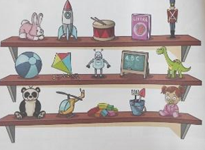
100% attribute provision
|
| absence of repetitive patterns
| 
0% attribute provision
| 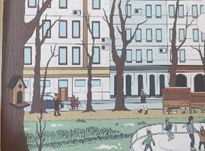
75% attribute provision
|
| inclusion of letters
| 
0% attribute provision
| 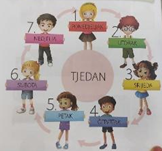
75% attribute provision
|
The analyses of the AR attributes of the visual images comprised in the English language textbooks by grade are represented in figures 1 (for English), 2 (for Science) and 3 (for CLIL). The results of the visuals chosen for the CLIL topics is in line with the trend of the English and Science textbook visuals (absence of repetitive patterns (M=4.90), no gloss paper (M=4.4), good contrast (M=3.60), richness in detail (M=2.85), and the inclusion of letters (M=1.62)).
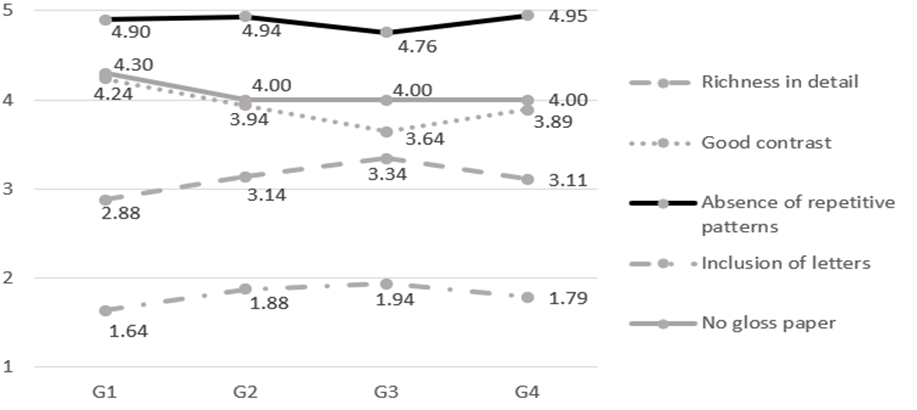
Figure 1: AR attributes of the analysed visual images for English textbooks per grade (G 1-4): richness in detail, good contrast, absence of repetitive patterns, inclusion of letters, no gloss paper, and the overall score averaging the individual attributes’ scores. Scores are provided on a scale from 1 to 5 where 1 signifies absence of a certain attribute and 5 absolute provision of the investigated attribute that makes the image readily available for presentation by means of AR technology
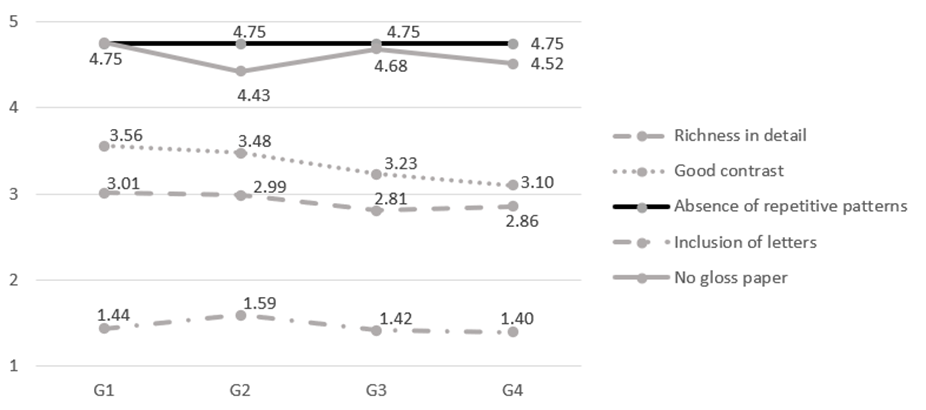Figure 2: AR attributes of the analysed visual images for Science textbooks per grade.
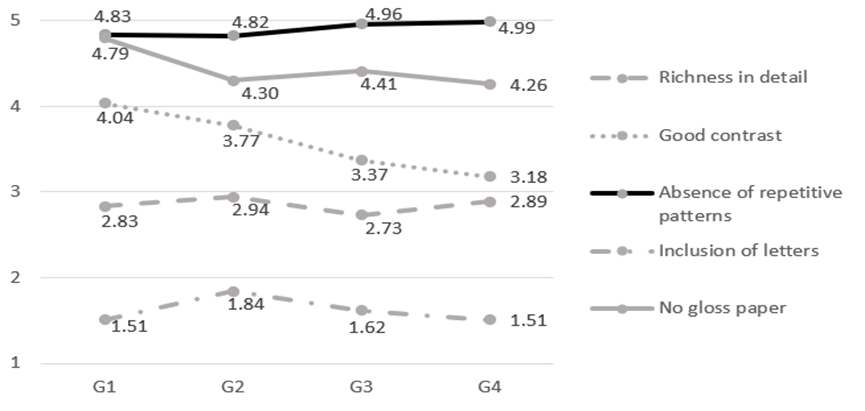Figure 3: AR attributes of the analysed visual images for CLIL in the analysed textbooks per grade.
The number of visual images used in the English language textbooks decreases as the grades become higher (see table 1 for details). The same pattern was observed in the Science textbooks as the topics become more complex. The visuals help pupils learn no matter the age and should be supported by the classroom materials, especially now that the extended reality opportunities offer a new angle of the presentation of the visuals in the teaching content.
##### **CLIL materials and AR technology: textbook creation**
A still rather recent area of interest in the content and language integrated learning approach to teaching is the development of CLIL materials (Mehisto, 2012). In the Croatian context the precondition for the creation of such materials would be the selection of topics between the subject areas that best allow for presentation using the CLIL approach and that are covered by the current curricular documents defined by the Ministry of Science and Education of the Republic of Croatia (MZO). This paper brings a proposal of those topics covered by all of the English and Science textbooks that have been approved for usage in the first four grades of primary education in the Republic of Croatia. Moreover, the analysis of the English and Science textbook visuals have mostly been found to allow for the AR presentation of the taught concepts in these subjects and, by extension, in the proposed CLIL topics. The next obvious step would be to set the bases for the creation of AR CLIL textbooks and additional materials which would implement the possibilities provided by the AR technology in such a way as to present the studied materials in their 3D form (for example see Figure 4 ).
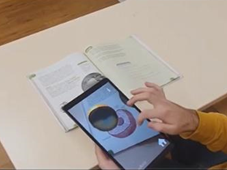
Figure 4: An example of the technical implementation of AR in the AR CLIL textbooks.
We draw on the “tentative checklist for CLIL textbooks” proposed by López-Medina (2016) in which the author lays out a number of criteria that need to be considered in this process. They fall into seven major categories. The first, general, category encompasses the features of structure in terms of the objectives and organization, supplementary materials that are used alongside the textbook and the physical features of material layout that should appeal to the pupils. The other six categories define the specificities of the content, cognition, communication, culture, language, and integration. The aim of this paper was not the analysis of CLIL features in the studied materials; however, it may be noted that most of them are already well covered, with the exception of the CLIL-recommended self-evaluation element (included into the general category) that is not present in all the materials. To López-Medina’s CLIL checklist one may add the checklist of attributes that need to be incorporated into the visual materials used in the teaching and learning process so as to allow for the enrichment of the CLIL materials by means of AR presentation. The suggested attributes of the visual images used with AR technology are: richness in detail, good contrast, absence of repetitive patterns, inclusion of letters, no gloss paper. The given attributes may be introduced into the general physical features in the CLIL checklist. AR technology is very susceptible to usage with the task-based activities within the situated learning framework where augmented reality images are added to the real physical environment to create authentic situations. For this purpose, we add five design principles for learning systems that are meant to be used in the classroom (Cuendet et al, 2015) to the previously noted visual attributes of the AR materials: integration, flexibility, empowerment, awareness, and minimalism. Integration refers to the blending of the AR technology with the existing classroom practices. The second and third principles refer to the flexibility the materials provide the teacher to cope with classes of varying levels and to empower the teacher to best cater for pupils’ needs. Moreover, the materials need to help the teacher stay aware of the progress and dynamics of the groups of pupils. Minimalization refers to the visualization features of the interface and the number of functionalities of the AR materials. We hope that the suggested integration of the CLIL and AR features into the creation of the AR CLIL textbooks eligible for task-based activities in the classroom rounds up the deliberation of the insertion of the modern methodologies into the situated learning framework principles. Situated learning is one of the theories that has received most attention in terms of AR as the virtual items are superposed into the real-life context allowing for the virtual creation of as authentic as possible learning situations and prompting pupils to learn by means of the task-based activities.
##### **Conclusion**
This paper embarks to fill some identified gaps in the literature on AR in education and inform on how readily available the present English and Science textbook materials used in the Croatian context are for usage with AR technology, especially in terms of the CLIL topics they cover. Reviews of literature presenting the usage of AR in education stress that papers often fail to provide pedagogical theories into which AR considerations are embedded. We hope that the present paper helps fill that gap embedding the AR technology supported activities into the situated learning framework. The content analysis of the 5404 visual images found in the English and Science textbooks currently in use in Croatia has shown that the visuals mostly fulfil the conditions of AR presentation as they mostly incorporate the necessary visual attributes. Along those lines, we propose the CLIL AR textbook creation and stress some of the most prominent features that such textbooks should encompass.
##### **References**
Annetta, L., Peters Burton, E., Frazier, W., Cheng, R., & Chmiel, R. (2012). Augmented Reality Games: Using Technology on a Budget. *Science Scope, 36*(3), 54–60.
Ellis, R., Skehan, P., Shaofeng, L., Natsuko, S., & Lambert, C. (2020). Task-Based Language Teaching: Theory and Practice. Cambridge, UK: Cambridge University Press.
Balja, L. (2019). Razvoj prototipne aplikacije za učenje stranih jezika uporabom tehnologije proširene stvarnosti (Bachelor’s thesis), Sveučilište u Zagrebu, Fakultet elektrotehnike i računarstva, Zagreb.
Bygate, M. (2015). Sources, developments and directions of task-based learning. The Language Learning Journal, 44(4), 381–400.
Casteleiro-Pitrez, J. (2021). Augmented Reality Textbook: A Classroom Quasi-Experimental Study. *IEEE revista iberoamericana de technologias del aprendizaje, 16*(3), 258–266.
Cindrić, I., & Hanžić Deda, S. (in review)
Coyle, D., Hood, P., & Marsh, D. (2010). Content and Language Integrated Learning. Cambridge, UK: Cambridge University Press.
Ellis, R. (2003). Task-based Language Learning and Teaching. Oxford, UK: Oxford University Press.
Gopalan, V., Zulkifli, A. N., Faisal Mohamed, N. F., Alwi, A., Che Mat, R., Abu Bakar, J. A., & Saidin, A. Z. (2016). Augmented reality books for science learning— A brief review. Int. J. Interact. *Digit. Media, 4*(1), 6–9.
Lave, J., & Wenger, E. (1991). Foreword by William F. Hanks. In Situated Learning: Legitimate Peripheral Participation. Cambridge, UK: Cambridge University Press.
López-Medina, B. (2016). Developing a CLIL textbook evaluation checklist. *LACLIL, 9*(1), 159–173. doi: 10.5294/la-clil.2016.9.1.7
Mahadzir, N. N. N., & Phung, L. F. (2013). The use of augmented reality pop-up book to increase motivation in English language learning for national primary school. *IOSR Journal of Research & Method in Education 1*(1), 26–38.
Mehisto, P., Marsh, D., & Frigols, M. J. (2008). Uncovering CLIL: Content and Language Integrated Learning in Bilingual and Multilingual Education. Oxford, UK: Macmillan Education.
Mehisto, P. (2012). Criteria for producing CLIL learning material. Encuentro, 21, 15–33.
Milgram, P., Takemura, H., Utsumi, A., & Kishino, F. (1994). Augmented Reality: A class of displays on the reality-virtuality continuum. SPIE Telemanipulator and Telepresence Technologies, 2351, 282–292.
MZO. (2019a). Kurikulum nastavnog predmeta Engleski jezik za osnovne škole i gimnazije. Ministarstvo znanosti i obrazovanja. Retrieved on 21st January 2021 from [https://skolazazivot.hr/wp-content/uploads/2020/07/EJ\_OSiGM\_kurikulum2.pdf](https://skolazazivot.hr/wp-content/uploads/2020/07/EJ_OSiGM_kurikulum2.pdf)
MZO. (2019b). Kurikulum nastavnog predmeta Priroda i društvo za osnovne škole. Ministarstvo znanosti i obrazovanja. /online/ Retrieved on 21st January 2021 from [https://skolazazivot.hr/wp-content/uploads/2020/07/PID\_kurikulum\_1.pdf ](https://skolazazivot.hr/wp-content/uploads/2020/07/PID_kurikulum_1.pdf)
MZO. (2021a). Katalog odobrenih udžbenika za osnovnu školu, gimnazije i srednje strukovne škole za šk. god. 2021./2022. – prilog udžbenici za učenike pripadnike nacionalnih manjina. Retrieved on 5th January 2021 from [https://mzo.gov.hr/vijesti/4553 ](https://mzo.gov.hr/vijesti/4553)
MZO. (2021b). Okvirni godišnji izvedbeni kurikulum Engleski jezik u 1./2./3./4. razredu osnovne škole za školsku godinu 2021./2022. /online/ Retrieved on 21st January 2021 from [https://mzo.gov.hr/vijesti/okvirni-godisnji-izvedbeni-kurikulumi-za-nastavnu-godinu-2021-2022/4522 ](https://mzo.gov.hr/vijesti/okvirni-godisnji-izvedbeni-kurikulumi-za-nastavnu-godinu-2021-2022/4522)
MZO. (2021c). Okvirni godišnji izvedbeni kurikulum za 1./2./3./4. razred osnovne škole za školsku godinu 2021./2022. /online/ Retrieved on 21st January 2021 from https://mzo.gov.hr/vijesti/okvirni-godisnji-izvedbeni-kurikulumi-za-nastavnu-godinu-2021-2022/4522
Parmaxi, A., & Demetriou, A. A. (2020). Augmented reality in language learning A state-of-the-art review of 2014-2019. *Journal of Computer Assisted Learning*, 1–15. doi:10.1111/jcal.12486
VuforiaTM Developer Library1. Best Practices for Designing and Developing Image-Based Targets. PTC Inc. https://library.vuforia.com/objects/best-practices-designing-and-developing-image-based-targets last accessed February 17th, 2022.
VuforiaTM Developer Library2. The Physical Properties of Image-Based Targets. PTC Inc. https://library.vuforia.com/objects/physical-properties-image-based-targets last accessed February 17th, 2022.
VuforiaTM Developer Library3. Best Practices for Designing and Developing Image-Based Targets. PTC Inc. https://library.vuforia.com/objects/best-practices-designing-and-developing-image-based-targets last accessed March 17th, 2022.
Wen, Y., & Looi, C.-K. (2019). Review of Augmented Reality in Education: Situated Learning with Digital and Non-digital Resources. In Díaz, P., Ioannou, A., Bhagat, K.K., & Spector, J. M. (Eds.) Learning in a Digital World: Perspective on Interactive technologies for Formal and Informal Education. Singapore: Springer. doi: 10.1007/978-981-13-8265-9\_9
|
[](https://hub.ufzg.hr/uploads/images/gallery/2022-10/stoo2.png)
| ***2. međunarodna znanstvena i umjetnička konferencija Učiteljskoga fakulteta Sveučilišta u Zagrebu** Suvremene teme u odgoju i obrazovanju – STOO2 - in memoriam prof. emer. dr. sc. Milanu Matijeviću, Zagreb, Hrvatska*
|
| ##### **Pojačana i virtualna stvarnost u obrazovnom okruženju: integrirano sadržajno i jezično učenje i poučavanje engleskoga jezika i prirode i društva**
|
| ##### **Sažetak**
|
| Pojačana stvarnost (AR) vrsta je tehnologije uranjanja pomoću koje se digitalni predmeti dodaju prikazu stvarnog svijeta kako bi se postiglo poboljšano korisničko iskustvo. AR je pronašla svoje mjesto u obrazovanju jer se razni virtualni elementi mogu generirati pomoću gotovih i prilagođenih aplikacija za uređaje u masovnoj upotrebi (npr. Android mobilne telefone). Virtualni elementi se zatim integriraju u okruženje stvarnog svijeta stvarajući situaciju učenja koja je gotovo autentična stvarnoj, a što je u skladu s teorijom situacijskog učenja. Preduvjet za to pristup je vizualnim prikazima koji obuhvaćaju niz atributa potrebnih za prezentaciju AR-a. U ovom radu promatramo pet najistaknutijih AR vizualnih atributa: bogatstvo detalja, dobar kontrast, izostanak ponavljajućih uzoraka, ubrajanje slova, papir bez sjaja. Usredotočujući se na ovih pet atributa, metodologijom analize sadržaja istražujemo mogućnost korištenja AR-a s postojećim vizualnim prikazima u udžbenicima engleskog jezika i prirode i društva u hrvatskim osnovnim školama od 1. do 4. razreda i utvrđujemo da postojeći vizualni prikazi već posjeduju visoku razinu integracije potrebnih atributa. Nadalje, predlažemo popis sadržaja i tema integriranog učenja i poučavanja sadržaja i jezika (CLIL), integrirajući engleski jezik i prirodu i društvo u procesima učenja i poučavanja od 1. do 4 razreda, te analiziramo odabrane CLIL teme u smislu prezentabilnosti postojećih vizualnih prikaza u udžbenicima pomoću AR tehnologije. Daju se prijedlozi poboljšanja vizualnih prikaza kako bi se mogli prikazati pomoću AR tehnologije. Konačno, date su neke smjernice za izradu CLIL AR udžbenika kao prijedlog za daljnja zalaganja u području.
|
| ***Ključne riječi***
|
| *AR atributi; CLIL teme; CLIL AR udžbenici; osnovna škola; teorija situacijskog učenja *
|
# Upotreba izvora na stranom jeziku na stručnom i specijalističkom studiju
| ##### **Maja Mikulec Rogić, Mirjana Cibulka, Davorka Rujevčan**
*Veleučilište u Karlovcu* |
| **Učenje i p(r)oučavanje stranih jezika**
| Broj rada: 75 | **Izvorni znanstveni rad**
|
| ##### **Sažetak**
|
| Nastava stranog jezika struke na stručnom studiju predstavlja proširivanje znanja stranog jezika s naglaskom na znanja o specifičnoj terminologiji iz određenog područja. Strani jezik struke podrazumijeva znanje jezika i stručna znanja, što znači da zahtijeva suradnju nastavnika jezika i nastavnika struke. Engleski jezik je u današnje vrijeme dominantan u svim područjima ljudskog djelovanja, pa tako i u znanosti i obrazovanju. Poticaj na upotrebu stranog jezika (struke) na studiju dolazi iz nastave, same struke te osobnih potreba studenata, a stručna literatura na stranom jeziku podiže kvalitetu njihovih pisanih radova. Cilj je ovog rada ispitati upotrebu stranih izvora na preddiplomskom stručnom i specijalističkom diplomskom stručnom studiju na Veleučilištu u Karlovcu. Analizirana je literatura u 247 završnih radova na stručnom studiju te 96 radova na specijalističkom studiju. Rezultati su pokazali da su u većini radova korišteni strani izvori, većinom na engleskom jeziku, te kojim vrstama izvora se studenti služe. U drugome dijelu istraživanja upitnikom su ispitani stavovi nastavnika o upotrebi stranih izvora u nastavi te u stručnom i znanstvenom radu. Rezultate istraživanja valja promatrati i kao smjernice za podizanje kvalitete nastave, ali i suradnje nastavnika struke i nastavnika stranog jezika struke.
|
| ***Ključne riječi***
|
| *literatura; stavovi; strani jezik struke*
|
##### **Uvod**
U okviru europske obrazovne politike učenje jezika zauzima istaknuto mjesto jer se poznavanje stranih jezika smatra jednom od osnovnih vještina potrebnom za ostvarivanje boljih mogućnosti u obrazovanju i zapošljavanju, a višejezičnost najvećom vrijednošću u smislu kulturne raznolikosti u Europi (Europski parlament, 2014). Stoga EU kroz razne programe potiče mobilnost te učenje i poučavanje stranih jezika, što je dodatno naglašeno ciljem koji je definirala Europska komisija, da do 2025. mladi po završetku srednjoškolskog obrazovanja osim materinskog trebaju dobro poznavati još dva jezika (Europska komisija, 2017).
Poznavanje i učenje stranih jezika u tercijarnom obrazovanju predstavlja važan čimbenik u ostvarivanju mogućnosti koje studentima nudi europski obrazovni prostor (primjerice programi akademske mobilnosti) te u boljem pozicioniranju budućih mladih stručnjaka na nacionalnom i europskom tržištu rada. Učenje stranog jezika na nefilološkim visokoškolskim ustanovama u Hrvatskoj predstavlja nastavak učenja stranog jezika unutar obrazovnog sustava, ali i njegovo usmjeravanje i to kroz učenje stranog jezika struke koji je usmjeren na specifične potrebe studenata i odabranog studijskog programa. Cilj je nastave stranog jezika struke pripremiti studente za komunikaciju i adekvatnu primjenu jezičnih znanja u određenoj struci i profesionalnom okruženju, odnosno zadovoljiti njihove potrebe koje proizlaze iz tržišta rada (Kordić i Papa, 2014).
Razlika između općeg stranog jezika i stranog jezika struke nije samo specifičan vokabular vezan za određenu struku, ali je ovakva površna percepcija česta i među samim studentima (Kabalin Borenić, Marinov i Mencer Salluzzo, 2013). Znanje općeg stranog jezika jest preduvjet za učenje stranog jezika struke koje je najčešće predviđeno za polaznike s višom razinom znanja, ali se može provoditi i na početnim razinama znanja (Dudley-Evans i St. John, 1998). S druge strane, dobro znanje općeg jezika i tečnost u govoru nisu jamstvo uspješnosti u savladavanju stručnih tekstova koji studentima mogu postati prepreka upravo zbog nedostatka znanja o specifičnom vokabularu i sintaksi u stranom jeziku struke (Cigan i Kordić, 2013; Violić-Koprivec i Hrnić, 2014). Stručni tekst po svojim je karakteristikama znatno drugačiji od tekstova u nastavi općeg stranog jezika. Razlike su najizraženije na leksičko-terminološkoj razini, ali se očituju i u karakterističnim retoričkim sredstvima, stilu te određenim gramatičkim i sintaktičkim osobitostima (Borić, 2016).
U nastavi stranog jezika struke sadržaj, metodologija, ciljevi, materijali, poučavanje i način vrednovanja proizlaze iz specifične upotrebe ciljanog jezika na temelju definiranog skupa specifičnih potreba (Trace, Hudson i Brown, 2015). U definiranju engleskog jezika struke Dudley-Evans i St. John (1998) navode upotrebu metodologije koja se razlikuje od one u poučavanju općeg jezika, a odnosi se na interakciju učenika i nastavnika u kojoj nastavnik preuzima ulogu savjetnika za jezik učenicima koji posjeduju znanja iz određene teme. Pritom ističu i sam jezik jer izvršavanje specifičnih aktivnosti u nastavi jezika struke ovisi o poznavanju i upotrebi registra, žanrova i adekvatnog jezičnog sadržaja.
Uzimajući u obzir navedene značajke (nastave) jezika struke, ali i globalizacijske procese te napredak u znanosti i struci, poučavanje stranog jezika struke predstavlja izazov za nastavnike čiji fokus mora biti daleko širi od samog jezičnog sadržaja. Dodatni izazov predstavlja i status stranog jezika struke na visokoškolskim ustanovama gdje se često preispituje njegova uloga. Međutim, jezik struke otvoren je i dinamičan sustav i zahtijeva integralni i interdisciplinarni pristup jer razvoj i napredak u svim područjima ljudskog djelovanja nameće potrebu za novom terminologijom, a ona nije samo predmet zanimanja jezikoslovaca, već zahtijeva njihovu suradnju sa stručnjacima iz različitih područja (Bukovčan, 2009).
Razvijanje višejezičnosti otežava status engleskog jezika kao lingua franca te s time povezan trend monolingvizma prisutan u raznim područjima i djelatnostima pa tako i u znanosti i obrazovanju. Ovo je, uz nedefiniran položaj stranog jezika unutar kurikula u visokom školstvu, još jedna otežavajuća okolnost za učenje i opstanak ostalih stranih jezika u obrazovnom sustavu koji su ovakvom situacijom stavljeni u neravnopravan položaj. Primjerice, za praćenje napretka u medicini poznavanje engleskoga jezika od presudne je važnosti jer je gotovo cjelokupna medicinska literatura napisana na engleskom jeziku, a engleski je i službeni jezik većine konferencija iz područja medicine (Koren i Rogulj, 2017). No, tržište rada diktira drugačije uvjete pa je za zapošljavanje medicinskih djelatnika potrebno znanje jezika određene zemlje. Višejezičnost u visokom obrazovanju je važna, ističe Borowski (2019) navodeći primjer problema u komunikaciji pacijenta s liječnicom koja nije izvorni govornik.
Danas je u znanosti postalo uobičajeno objavljivati na engleskom jeziku kako bi se postigla međunarodna vidljivost i reputacija. Međutim, kritičari ovog monolingvizma upozoravaju da znanstvena inovativnost i kreativnost počivaju na kulturnoj raznolikosti te da svako jezično ograničavanje osiromašuje znanstvenu misao i dovodi do uniformnosti mišljenja (Gehrmann i Turković, 2019). Thielmann (2019) smatra da se dominacija engleskog jezika u europskoj znanosti negativno odražava na znanstvenike koji nisu izvorni govornici engleskog jezika jer nisu u mogućnosti adekvatno prezentirati svoj rad i ne mogu održati istu razinu kvalitete kao engleski govornici.
Gačić (2017) ističe da je svaki ozbiljan stručni i znanstveni rad danas nezamisliv bez poznavanja stranih jezika te da je za razumijevanje stručnih sadržaja važno poznavanje i jezika i struke. Jedan od zadataka s kojim se studenti susreću tijekom studija su i pisani radovi – seminarski radovi, stručni ili znanstveni radovi u koautorstvu s profesorom te završni ili diplomski rad. Cilj završnog rada je primijeniti znanstvene metode, teorijska i praktična znanja stečena tijekom studija i samostalno se služiti odgovarajućom domaćom i stranom literaturom. Budući da je završni rad prilika da studenti pokažu sva svoja znanja i vještine stečena na završetku određenog stupnja obrazovanja, analiza izvora može pomoći ispitati koliko je u tome prisutan strani jezik kao dio obrazovnih sadržaja koje je student usvojio.
##### **Metodologija**
Cilj istraživanja je ispitati upotrebu stranih izvora u završnim radovima studenata na Veleučilištu u Karlovcu, ali i stavove nastavnika o upotrebi stranih izvora u nastavi te znanstvenom i stručnom radu.
Istraživanje, koje se sastojalo od dva dijela, dalo je odgovore na sljedeća istraživačka pitanja:
1\. Koriste li se studenti pri pisanju završnih radova stranim izvorima?
2\. Jesu li strani izvori pretežno na engleskom jeziku?
3\. Upotrebljavaju li nastavnici strane izvore za pripremu nastave?
4\. Koji je stav nastavnika o upotrebi stranih izvora pri izradi seminarskih i završnih radova?
Prikupljanje i obrada podataka
Prvi dio istraživanja odnosi se na izvore u završnim radovima. Analizirani su izvori u ukupno 343 završna rada, od toga 247 na stručnom studiju te 96 na specijalističkom studiju zbog usporedbe upotrebe stranih izvora na obje razine studija. Radovi su pregledani u Digitalnim akademskim arhivima i repozitorijima na mrežnoj stranici https://dabar.srce.hr/, a odabrani su metodom slučajnog odabira. Sa svakog pojedinog studija pregledano je po 20 % radova, i to iz razdoblja od 2015. do 2021. godine. Pregledani su završni radovi sa stručnih studija Lovstvo i zaštita prirode, Prehrambena tehnologija, Sigurnost i zaštita, Strojarstvo i Ugostiteljstvo te sa specijalističkih diplomskih stručnih studija Poslovno upravljanje, Sigurnost i zaštita i Strojarstvo. Na stručnom studiju Strojarstvo dva su usmjerenja (Strojarstvo i Mehatronika), ali budući da završni radovi na studiju Mehatronika u Repozitoriju pripadaju Odjelu strojarstva, Mehatronika u ovom dijelu istraživanja nije zasebno navedena.
Analizom je utvrđeno u kojoj mjeri se upotrebljavaju strani izvori, o kojim stranim jezicima je riječ te o kojoj vrsti izvora se radi. Ograničenje u određivanju vrsta izvora predstavljali su mrežni izvori koji više nisu aktivni, odnosno ne može im se pristupiti i provjeriti o kakvoj se vrsti izvora radi pa je prema tome moguće dati samo opću procjenu. Također, u izvorima na engleskom jeziku prisutni su i tiskani izvori, odnosno knjige te stručni i znanstveni radovi. I ovdje je bilo teško odrediti radi li se o tiskanom ili mrežnom izvoru jer neki časopisi imaju i svoja mrežna izdanja, stoga smo se u analizi vodili načelom da se kao mrežna izdanja računaju samo ona kod kojih je to bilo navedeno. S pojedinih mrežnih izvora preuzete su slike, karte ili dijagrami, za što nije potrebno dobro poznavanje jezika. Međutim, nije moguće utvrditi kako je student pretraživao mrežne stranice, odnosno je li se pritom koristio stranim jezikom ili je pronalaženje slika i dijagrama rezultat slučajnosti, pa su i ove mrežne stranice uključene u strane izvore.
Drugi dio istraživanja odnosi se na stavove nastavnika. Ispitani su pomoću upitnika osmišljenog za potrebe istraživanja kojem su pristupali putem poveznice, a obuhvaćao je sljedeće: spol, dob, zvanje, znanstveno područje iz kojeg se izvodi nastava, studij na kojem nastavnici predaju, 16 tvrdnji o upotrebi stranih izvora te podatke o poznavanju stranih jezika i samoprocjenu nastavnika prema Zajedničkom europskom referentnom okviru za jezike (ZEROJ). Uz 16 tvrdnji o upotrebi izvora na stranom jeziku u okviru nastave, za potrebe znanstvenog i/ili stručnog rada te za osobne potrebe ispitanici su, ovisno o stupnju slaganja, trebali označiti broj na Likertovoj ljestvici (1 – uopće se ne slažem, 2 – ne slažem se, 3 – niti se slažem niti se ne slažem, 4 – slažem se, 5 – u potpunosti se slažem). Koristeći program IBM SPSS 28 napravljena je deskriptivna analiza, te t-test i analiza varijance (ANOVA).
##### **Ispitanici**
U istraživanju je sudjelovalo 30 od 61 nastavnika (49 % stalno zaposlenih nastavnika), od toga 11 muških (37 %) i 19 ženskih (63 %). Prema dobnoj strukturi 13 ispitanika je u dobi od 41 do 50 godina (43 %), 10 ispitanika od 31 do 40 (33 %), 5 ima 51 do 60 godina (17 %), 1 je mlađi od 30 godina (3 %) i 1 stariji od 60 godina (3 %). Prema zvanju je 12 viših predavača (40 %), 10 profesora visoke škole (33 %), 4 predavača (13 %), 2 asistenta (7 %) i 2 profesora visoke škole u trajnom zvanju (7 %). Nastavu iz područja tehničkih znanosti izvodi 10 ispitanika (33 %), iz područja društvenih znanosti također 10 (33 %), iz područja biotehničkih znanosti 5 ispitanika (17 %), iz prirodnih znanosti 4 ispitanika (13 %), te 1 ispitanik (3 %) iz područja humanističkih znanosti. Na više studija predaje 17 ispitanika (57 %) dok 13 ispitanika (43 %) predaje samo na jednom studiju ili se radi o kombinaciji stručnog ili specijalističkog studija, primjerice stručni studij Strojarstvo i specijalistički studij Strojarstvo. Također, 19 ispitanika (63 %) predaje i na stručnom i na specijalističkom studiju, a 11 ispitanika (37 %) samo na stručnom studiju. Ispitanici predaju na svim studijima obuhvaćenim prvim dijelom istraživanja. Zastupljenost ispitanika po studijima prikazana je u Grafikonu 1.
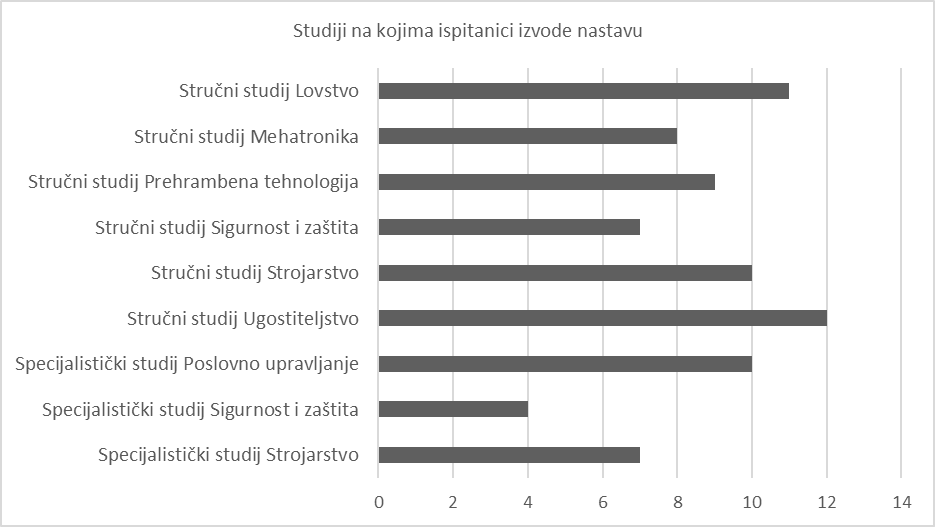
Grafikon 1. Studiji na kojima ispitanici izvode nastavu
##### **Rezultati**
Analiza izvora u završnim radovima na stručnom i specijalističkom studiju pokazala je da većina radova sadrži strane izvore. U rezultatima se najviše ističu završni radovi na stručnom studiju Prehrambena tehnologija. Od 16 pregledanih radova svi sadrže izvore na stranom jeziku. Slijedi stručni studij Strojarstvo sa 45 od ukupno 53 rada, te stručni studij Lovstvo i zaštita prirode gdje od 20 radova 16 sadrži strane izvore. Najmanji udio radova sa stranim izvorima zabilježen je na stručnom studiju Sigurnost i zaštita, nešto više od polovice pregledanih radova (48 od 92), dok je na specijalističkom studiju Sigurnost i zaštita taj udio nešto veći (28 od 48). Broj radova sa stranim izvorima na stručnom studiju Ugostiteljstvo je 40 od 66, na specijalističkom studiju Poslovno upravljanje 16 od 24, a na specijalističkom studiju Strojarstvo 17 od 24 rada. Postotak radova koji sadrže strane izvore po studijima prikazan je u Grafikonu 2.
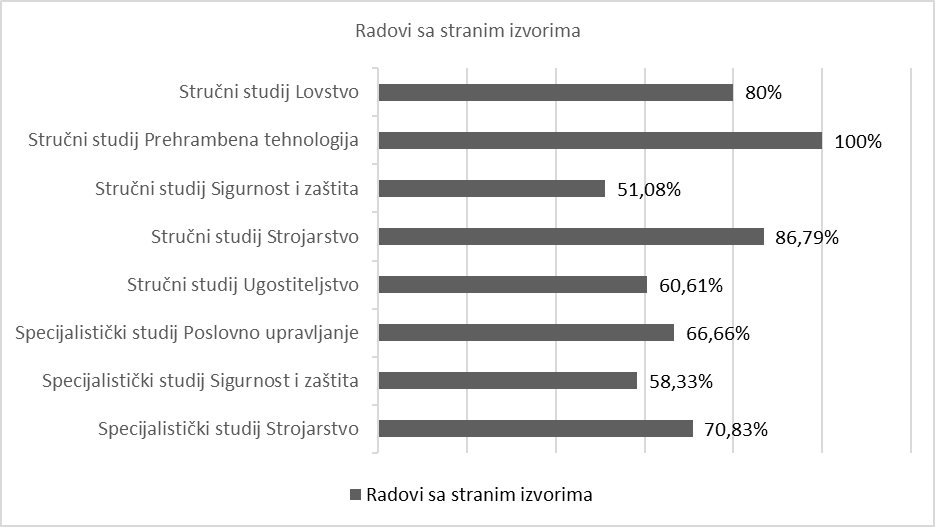
Grafikon 2. Radovi sa stranim izvorima
U stranim izvorima očekivano je najzastupljeniji engleski jezik. Kao što je vidljivo u Grafikonu 3, prisutnost ostalih stranih jezika u završnim radovima na stručnim studijima je neznatna. Uz engleski naveden je i njemački jezik kao drugi po broju izvora (29 od ukupno 1432), a istaknut je i jer se radi o jeziku koji studenti imaju priliku učiti na stručnom studiju. Kategorija „ostalo“ (5 %) odnosi se na jezike s manjim udjelom od njemačkog, a to su bošnjački, srpski, slovenski i crnogorski, francuski, ukrajinski, ruski, španjolski, poljski i češki. U Tablici 1 prikazan je broj izvora po pojedinom stručnom studiju i jezicima.
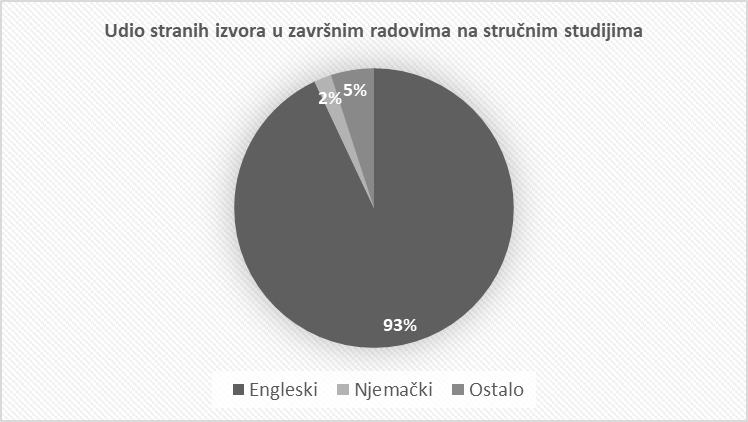
Grafikon 3. Udio stranih izvora u završnim radovima na stručnim studijima
Tablica 1.
| Stručni studij
| Jezici
| Broj izvora na pojedinom stranom jeziku
| Izvori na stranom jeziku - ukupno
|
| Lovstvo i zaštita prirode
| engleski
španjolski
slovenski
njemački
francuski
srpski
| 117
3
3
3
2
2
| 130
|
| Prehrambena tehnologija
| engleski
poljski
ruski
francuski
| 306
3
3
2
| 314
|
| Sigurnost i zaštita
| engleski
njemački
srpski
bošnjački
slovenski
francuski
češki
ukrajinski
crnogorski
| 193
12
11
8
6
1
1
1
1
| 234
|
| Strojarstvo
| engleski
bošnjački
njemački
srpski
francuski
slovenski
češki
| 515
12
9
5
1
1
1
| 544
|
| Ugostiteljstvo
| engleski
njemački
ukrajinski
bošnjački
crnogorski
srpski
| 197
5
4
2
1
1
| 210
|
U Tablici 1 ističe se broj stranih izvora na studiju Prehrambena tehnologija iako je ukupan broj pregledanih radova 16. Razlog tome je jedan završni rad koji brojem referenci (106) znatno odstupa od ostalih radova s istog i drugih stručnih studija.
Udio izvora po jezicima u završnim radovima na specijalističkim studijima gotovo je jednak onom na stručnim studijima (Grafikon 4). Prevladavaju izvori na engleskom jeziku (433 od ukupno 473 izvora), a na drugom mjestu je opet njemački jezik s iznimno niskim udjelom od 2 %, (11 izvora). Od ostalih jezika zabilježeni su srpski, crnogorski, bošnjački, slovenski i španjolski jezik. Broj izvora po pojedinom specijalističkom studiju i jezicima prikazan je u Tablici 2.
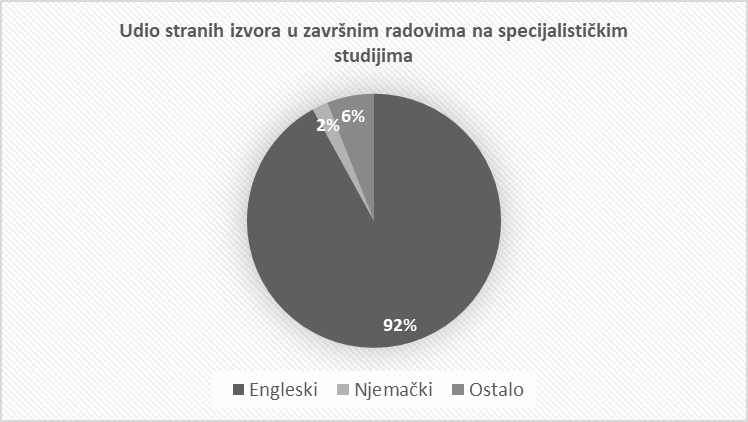
Grafikon 4. Udio stranih izvora u završnim radovima na specijalističkim studijima
Tablica 2. Broj izvora po pojedinom specijalističkom studiju i jezicima
| Specijalistički studij
| Jezici
| Broj izvora na pojedinom stranom jeziku
| Izvori na stranom jeziku - ukupno
|
| Poslovno upravljanje
| engleski
crnogorski
srpski
bošnjački
| 52
7
3
3
| 65
|
| Sigurnost i zaštita
| engleski
slovenski
njemački
španjolski
bošnjački
srpski
| 223
4
3
3
2
1
| 236
|
| Strojarstvo
| engleski
njemački
srpski
bošnjački
| 158
8
5
1
| 172
|
Kada je riječ o vrstama izvora, studenti se u velikoj mjeri koriste mrežnim izvorima među kojima su knjige, stručni i znanstveni radovi, zakoni, ali i značajan udio slikovnih prikaza, mrežnih stranica ustanova, tvrtki, proizvođača ili mrežnih portala. Zbog spomenutih ograničenja u ovom dijelu istraživanja nije moguće dati točan broj pojedinih vrsta izvora, već samo opću ocjenu da je tiskanih izvora manje od mrežnih koji su u nekim radovima i jedini izvori. Dok među izvorima na engleskom jeziku nalazimo i knjige te stručne i znanstvene radove, isto ne možemo reći i za izvore na ostalim stranim jezicima koji se uglavnom odnose na mrežne portale i slikovne prikaze koji mogu biti rezultat pretraživanja mrežnih stanica, a ne poznavanja stranog jezika.
Deskriptivna analiza tvrdnji o upotrebi stranih izvora pokazuje visok stupanj slaganja ispitanika s većinom tvrdnji (Tablica 3).
Tablica 3. Tvrdnje o upotrebi stranih izvora
| Tvrdnja
| N
| M
| SD
|
| 1\. Za pripremu nastave koristim se izvorima na stranom jeziku.
| 30
| 4,53
| ,681
|
| 2\. U nastavi potičem studente na korištenje izvora na stranom jeziku.
| 30
| 4,20
| ,961
|
| 3\. Za kolegije na kojima predajem postoji dovoljno izvora na hrvatskom jeziku.
| 30
| 2,93
| 1,258
|
| 4\. Za određene kolegije na kojima predajem potrebno je korištenje izvora na stranom jeziku.
| 30
| 4,07
| 1,202
|
| 5\. Kolegiji na kojima predajem ne zahtijevaju upotrebu izvora na stranom jeziku.
| 30
| 3,87
| 1,332
|
| 6\. Pri pisanju seminarskih radova upućujem studente na upotrebu izvora na stranom jeziku.
| 30
| 4,30
| ,837
|
| 7\. Za potrebe pisanja stručnih i/ili znanstvenih radova upotrebljavam izvore na stranome jeziku.
| 30
| 4,93
| ,254
|
| 8\. Koristim se stranim jezikom za osobne potrebe.
| 30
| 4,73
| ,521
|
| 9\. Znanje stranog jezika važno je za studije na kojima predajem.
| 30
| 4,30
| ,988
|
| 10\. Pri pisanju seminarskih radova studenti trebaju upotrebljavati izvore na stranom jeziku.
| 30
| 3,83
| 1,053
|
| 11\. Pri pisanju završnih radova studenti trebaju upotrebljavati izvore na stranom jeziku.
| 30
| 4,23
| ,858
|
| 12\. Pri pisanju diplomskih radova studenti trebaju upotrebljavati izvore na stranom jeziku.
| 30
| 4,37
| ,765
|
| 13\. Znanje stranih jezika važno je za studente na preddiplomskom studiju.
| 30
| 4,67
| ,547
|
| 14\. Znanje stranih jezika važno je za studente na specijalističkom diplomskom stručnom studiju.
| 30
| 4,70
| ,535
|
| 15\. Znanje općeg stranog jezika studentima je dovoljno za potrebe studija.
| 30
| 3,27
| 1,015
|
| 16\. Znanje stranog jezika struke studentima je važno za potrebe studija.
| 30
| 4,20
| ,805
|
N = broj ispitanika, M = srednja vrijednost, SD = standardna devijacija
Ispitanici su visokim stupnjem slaganja (4,53) dali odgovor na pitanje o upotrebi stranih izvora u nastavi, a nešto niži stupanj slaganja s 2. tvrdnjom (4,20) pokazuje da potiču studente na njihovu upotrebu. Odgovori ispitanika pokazuju i visok stupanj slaganja s tvrdnjama koje se odnose na upotrebu izvora na stranom jeziku u znanstvenom i stručnom radu te za osobne potrebe, kao i na upotrebu izvora na stranom jeziku u pisanju završnih radova. Treba istaknuti i visok stupanj slaganja (4,67 i 4,70) s tvrdnjama o važnosti stranih jezika na obje razine studija. Tvrdnje 3 i 5 pokazuju niži stupanj slaganja što dokazuje da su nastavnicima potrebni izvori na stranom jeziku za pripremu nastave. Obzirom na razliku u stupnju slaganja između 10. te 11. i 12. tvrdnje koje se odnose na upotrebu stranih izvora u seminarima i završnim radovima, zaključujemo da nastavnici strane izvore smatraju potrebnijima u pisanju završnih radova nego u pisanju seminara. S druge strane, stupanj slaganja s 10. tvrdnjom niži je, iako ne znatno, od stupnja slaganja sa 6. tvrdnjom, odnosno možemo zaključiti da nastavnici u većoj mjeri upućuju studente na upotrebu stranih izvora pri pisanju seminarskih radova, nego što to smatraju potrebnim. Manja razlika u stupnju slaganja između 15. i 16. tvrdnje može ukazivati na razumijevanje razlike između općeg stranog jezika i stranog jezika struke. Također, srednja vrijednost 3,27 uz 15. tvrdnju pokazuje da ta razlika kod dijela nastavnika ipak nije značajna.
Korištenjem t-testa željelo se vidjeti postoje li razlike u stavovima muških i ženskih ispitanika. Pri tome se pokazala statistički značajna razlika samo kod dviju tvrdnji što je prikazano u Tablici 4.
Tablica 4. Razlike u stavovima muških i ženskih ispitanika
| Tvrdnja
| N
| M
| SD
| p
|
| 7\. Za potrebe pisanja stručnih i/ili znanstvenih radova upotrebljavam izvore na stranome jeziku.
| m = 12
| 4,83
| ,389
| 0,001
|
| ž = 18
| 5,0
| ,000
|
| 9\. Znanje stranog jezika važno je za studije na kojima predajem.
| m = 12
| 4,75
| ,452
| 0,001
|
| ž = 18
| 4,00
| 1,138
|
N = broj ispitanika, m = muški ispitanici, ž = ženski ispitanici, M = srednja vrijednost, SD = standardna devijacija, p = statistički značajna razlika
Možemo zaključiti da se muški i ženski ispitanici razlikuju u stavovima o upotrebi izvora na stranom jeziku za potrebe pisanja stručnih i/ili znanstvenih radova u smjeru da ispitanice imaju pozitivniji stav, odnosno da smatraju da su im takvi izvori potrebniji. Ispitanici pak pokazuju pozitivniji stav o važnosti poznavanja stranih jezika za studije na kojima predaju. Kod ostalih tvrdnji nije uočena statistički značajna razlika u stavovima s obzirom na spol ispitanika.
Također, željelo se ispitati postoje li razlike u stavovima s obzirom na godine ispitanika, znanstvena područja iz kojih izvode nastavu te s obzirom na nastavno zvanje za koje imaju trenutno važeći izbor. Napravljena su analize varijance s obzirom na navedene kategorije, no niti kod jedne tvrdnje nisu se pokazale statistički značajne razlike. Stoga se može zaključiti da su ispitanici ujednačeni u stavovima gledaju li se razlike u navedenim kategorijama.
Ispitanici su u upitniku trebali navesti i kojim stranim jezikom/stranim jezicima se služe. Samoprocjena ispitanika prema ZEROJ-u pokazala je da se svi služe engleskim jezikom i to kao samostalni i napredni korisnici. Drugi po zastupljenosti je njemački jezik kojim se služi 22 ispitanika, ali najviše kao početnici, dok je mali broj samostalnih i naprednih korisnika. Talijanskim se jezikom, većinom kao početnici služi 7 ispitanika. Ispitanici su još naveli da se služe španjolskim, francuskim i ruskim jezikom. Pregled samoprocjene znanja stranih jezika prikazan je Grafikonu 5.

Grafikon 5. Samoprocjena ispitanika prema ZEROJ-u
Većina ispitanika, njih 18, navodi da zna dva strana jezika, 6 ispitanika govori tri jezika, 1 ispitanik 4 jezika i jedan svih šest navedenih jezika i to engleski na razini B2, njemački na razini A2 te ostale jezike na razini A1. Najčešću kombinaciju jezika, kod ispitanika koji govore dva jezika, čine engleski i njemački jezik. Ispitanici nisu navodili druge strane jezike.
##### **Rasprava**
Ranije spomenuta dominacija engleskog jezika vidljiva je i u rezultatima analize stranih izvora u završnim radovima na Veleučilištu u Karlovcu. Nisku zastupljenost izvora na njemačkom jeziku možemo dodati i ostalim pokazateljima smanjenog interesa za njemački jezik u obrazovnom sustavu. Već niz godina broj studenata koji na studiju uče engleski znatno premašuje broj onih koji uče njemački jezik (Kordić, 2019; Mikulec Rogić, Cibulka, Rujevčan, 2020).
Izvori na južnoslavenskim jezicima (slovenski, srpski, bošnjački i crnogorski) pojavljuju se u završnim radovima u većem broju nego izvori na ostalim stranim jezicima (španjolski, francuski, poljski, češki, ukrajinski), a čiji je udio u ukupnoj literaturi gotovo zanemariv. Uzimajući u obzir činjenicu da je razumijevanje jezika južnoslavenske skupine moguće i bez formalnog učenja, možemo zaključiti da literatura u završnim radovima nije na tragu višejezičnosti kakvu zagovara obrazovna i jezična politika EU, a slijedom toga i nacionalna obrazovna politika.
Iako se ZEROJ (2005) bazira na načelima očuvanja baštine zajedničkih europskih jezika i kultura, razvijanja bolje komunikacije i razumijevanja kroz poznavanje europskih jezika kako bi se zadovoljila potreba za komunikacijom, snalaženjem u svakodnevnim situacijama i razmjenjivanjem informacija, vidljivo je da u visokom obrazovanju u Republici Hrvatskoj ne postoje politike koje potiču učenje više stranih jezika na nefilološkim studijima. Kao najčešći problemi u provođenju nastave stranih jezika ističu se status nastavnika stranog jezika, mjesto stranog jezika u kurikulu, velike grupe studenata te suradnja nastavnika jezika i nastavnika struke (Borić, 2005; Nemec, 2009; Bukovčan 2013).
ZEROJ razlikuje višejezičnost od mnogojezičnosti. Mnogojezičnost opisuje poznavanje „nekoliko jezika ili supostojanje različitih jezika u određenom društvu“ (ZEROJ, 2005, str. 4), a postiže se većim izborom stranih jezika u obrazovnim sustavima ili smanjivanjem dominantne uloge engleskog jezika u okvirima međunarodne komunikacije. Višejezičnost se pak odnosi na komunikacijsku kompetenciju koju pojedinac ima u svim jezicima kojima se koristi u bilo kojem kontekstu. Cilj višejezičnosti nije doseći razinu idealnog govornika pojedinog jezika, već razviti jezični repertoar u kojemu sve jezične sposobnosti dolaze do izražaja, stoga obrazovne ustanove moraju nuditi mogućnost učenja više stranih jezika s ciljem razvijanja višejezične kompetencije.
U tercijarnom obrazovanju studentima se nudi mogućnost uključivanja u programe akademske mobilnosti. Važnost znanja stranih jezika u ostvarivanju ove mogućnosti ističe se u istraživanju stavova studenata Visokog gospodarskog učilišta u Križevcima, u kojem 82 od 132 studenata navodi da njihovo znanje stranih jezika nije dovoljno dobro da bi sudjelovali u Erasmus programu mobilnosti, a čak 103 studenata smatra da je nepoznavanje stranog jezika razlog slabog interesa za ove programe (Cafuk, Papić Bogadi, Ivanek-Martinčić i Husinec, 2015). S druge strane, rezultati istraživanja koje su proveli Dragun i Relja (2015) pokazuju da je studentima Ekonomskog fakulteta u Splitu učenje stranih jezika najvažniji cilj uključenja u programe akademske mobilnosti, za koji, ujedno, najviše očekuju da bi ga postigli uključenjem. Kic-Drgas (2016) navodi kako su ekonomski napredak i suradnja Poljske s Njemačkom, u vidu programa razmjene studenata, stipendiranja te zajedničkih projekata, pozitivno utjecali na motivaciju za učenje njemačkog jezika i osigurali mu važno mjesto u kurikulima poljskih sveučilišta.
U ovom istraživanju ističe se pozitivan stav nastavnika o upotrebi stranih izvora, a valja istaknuti i njihov odaziv (49 %) koji možemo ocijeniti dobrim. Također smatramo veoma pozitivnom činjenicu da se svi ispitanici služe barem jednim, a većina i s više stranih jezika u svome radu, što je zasigurno dobar preduvjet za razvijanje suradnje među jezičnim i nejezičnim kolegijima.
Ciglar (1989) smatra da je upravo izrada seminarskih i diplomskih radova prilika za suradnju nastavnika stranih jezika i nastavnika struke na nefilološkim fakultetima. U istraživanju provedenom 1989. na Fakultetu organizacije i informatike u Varaždinu i Pedagoškoj akademiji u Čakovcu autor je analizirao literaturu u diplomskim radovima u godinama 1982., 1983., 1984. i 1989. U 731 diplomskom radu autor pronalazi 77 slučajeva citiranja strane literature, odnosno 10,5 %. Pritom na Pedagoškoj akademiji ne nalazi niti jedan slučaj citiranja strane literature. Od stranih jezika zastupljeni su engleski (7,3 %), njemački (4,2 %), ruski (3,9 %) te francuski (0,2 %). Zanimljivo je da je broj studenata koji su učili njemački (257) znatno veći od broja studenata koji su učili engleski jezik (82), ali ni to nije utjecalo na veći broj citata na njemačkom jeziku. Ove rezultate autor tumači i kao neuspješnu suradnju nastavnika jezika i struke, a ističe i problem nedostupnosti literature. Danas su studentima dostupni različiti strani izvori, potiče se višejezičnost, ali prevladava upotreba engleskog jezika, a u suradnji među nastavnicima i katedrama i dalje postoje poteškoće.
U istraživanju Kordić i Pape (2014) na Pravnom fakultetu u Osijeku 35 % ispitanih nastavnika koristi se izvorima na engleskom jeziku u obveznoj literaturi za svoje kolegije, 59 % ispitanika ne upotrebljava strane izvore kao obveznu literaturu, a izvorima na njemačkom jeziku koristi se dvoje ispitanika. U dopunskoj literaturi 82 % ispitanika nudi naslove na engleskom jeziku, a 35 % na njemačkom. Autorice su svoje istraživanje usporedile s onim na Pravnom fakultetu u Zagrebu (Javornik Čubrić i Matijašević, 2013) kojem se odazvalo svega 38 od 140 nastavnika (28 %), od čega 18,42 % navodi obveznu literaturu na engleskom jeziku, a 63,16 % dopunsku literaturu na engleskom jeziku.
Iako su u dijelu istraživanja o vrstama izvora postojala ograničenja, u smislu nemogućnosti pristupa navedenim mrežnim stranicama, analiza je pokazala da se izvori na engleskom jeziku odnose i na mrežna izdanja knjiga te na stručne i znanstvene članke, a ne samo na mrežne portale, što valja istaknuti kao pozitivan primjer upotrebe izvora na stranom jeziku.
Unatoč tome što se većina nastavnika izjasnila o potrebi korištenja stranih izvora za pripremu nastave te su naglasili da potiču studente na uporabu takvih izvora pri pisanju seminarskih radova, ipak je vidljiva niža razina slaganja s tvrdnjom o potrebi korištenja izvora na stranom jeziku za pisanje seminarskih radova usporedno sa završnim radovima. To je moguće povezati s činjenicom da pri pisanju završnih radova studenti moraju pokazati širinu znanja stečenoga tijekom studiranja pa se i očekuje korištenje različitih izvora, uključujući i strane.
##### **Zaključak**
Analiza izvora u završnim radovima na preddiplomskim stručnim i diplomskim specijalističkim studijima pokazuje da su u većini radova korišteni izvori na stranom jeziku, najviše na engleskom. To je u skladu s trenutnim statusom engleskog kao lingua franca, no nije u skladu sa smjernicama o višejezičnosti i multijezičnosti koju predlaže ZEROJ. Najviše se ističe stručni studij Prehrambena tehnologija na kojem svi analizirani radovi sadrže strane izvore, dok na stručnom i specijalističkom studiju Sigurnost i zaštita nalazimo najmanji udio radova sa stranim izvorima (51,08 %, 58,33 %). U završnim radovima na specijalističkom studiju strani izvori ne upotrebljavaju se više nego u radovima na stručnom studiju. Iako u središtu ovog istraživanja nije bila analiza različitih vrsta izvora korištenih pri pisanju završnih radova, samo istraživanje daje poticaj za pobliže bavljenje tematikom kritičkog odabira vrsta izvora.
Nastavnici, bez obzira na znanstveno područje iz kojeg izvode nastavu, ističu potrebu za stranim jezikom, i za osobne i za poslovne svrhe, te smatraju da je znanje stranoga jezika struke potrebno studentima i na preddiplomskom stručnom i na diplomskom specijalističkom studiju. Pozitivno razmišljanje nastavnika struke o korištenju stranih jezika struke u sklopu njihovih kolegija otvara mogućnost suradnje i unaprjeđivanja i jezičnih i stručnih kolegija. Svi ispitanici služe se engleskim jezikom i to kao samostalni i napredni korisnici, dok se njemačkim služe na nižoj razini, što je znakovit podatak u kontekstu upotrebe izvora na njemačkom jeziku.
Rezultati istraživanja mogu biti poticaj za daljnja istraživanja upotrebe stranih izvora na drugim visokoškolskim ustanovama, i to prema području, odnosno struci, kao i za istraživanja o potrebama nastavnika struke te o potrebama studenata u kontekstu sudjelovanja u programima akademske mobilnosti.
##### **Literatura**
Borić, N. (2005). Strani jezik na nefilološkim fakultetima u kontekstu reforme sveučilišta u Hrvatskoj. Strani jezici, 34(2), 109–124. Dostupno na https://stranijezici.ffzg.unizg.hr/wp-content/uploads/2020/06/SJ\_34\_2\_2.pdf \[5.1.2022.\]
Borić, N. (2016). Uloga i važnost stručnih i znanstvenih tekstova u nastavi stranih jezika strukā. Strani jezici, 45(2), 88–101.
Borowski, D. (2019). Relevanz sprachlicher Kompetenzen im Anästhesistenberuf in Deutschland. Zagreber germanistische Beiträge, 28(1), 177–207. doi: 10.17234/ZGB.28.9
Bukovčan, D. (2009). Od teorije do prakse u jeziku struke. Zagreb: Školska knjiga.
Bukovčan, D. (2013). Stručno-znanstveni skup održan 23. veljače 2013. g. u Zagrebu u organizaciji Udruge nastavnika jezika struke na visokoškolskim ustanovama na temu "Jezik struke - kamo idemo?". Policija i sigurnost, 22(2), 311–314. Dostupno na https://hrcak.srce.hr/116544 \[6.11.2021.\]
Cafuk, I., Papić Bogadi, V., Ivanek-Martinčić, M. i Husinec, R. (2015). Važnost poznavanja stranog jezika struke za mobilnost i zapošljivost diplomanata Visokog gospodarskog učilišta u Križevcima. Podravina, 14(27), 160–174. Dostupno na https://hrcak.srce.hr/148965 \[6.11.2021.\]
Cigan, V., i Kordić, V. (2013). The Role of ESP Courses in General English Proficiency, Linguistica, 53(2). 153–173.
Ciglar, V. (1989). Istraživanje međupredmetne suradnje kao pretpostavke za stvaranje motivacije u izučavanju stranih jezika na nefilološkim fakultetima. Journal of Information and Organizational Sciences, 13, 29–39. Dostupno na https://hrcak.srce.hr/80127 \[6.11.2021.\]
Dudley-Evans, T. i St. John M.J. (1998). Developments in English for Specific Purposes: A multidisciplinary approach. Cambridge: Cambridge University Press.
Europska komisija (2017). Obrazovanjem i kulturom jačati europski identitet Doprinos Europske unije sastanku na vrhu u Göteborgu 17. studenoga 2017. Dostupno na https://eur-lex.europa.eu/legal-content/HR/TXT/?uri=COM%3A2017%3A673%3AFIN \[30.1.2022.\]
Europski parlament (2014). Kratki vodič o Europskoj uniji : izdanje 2014, Ured za publikacije. doi: 10.2861/2485
Gačić, M. (2017). Pisanje u znanosti i struci. Zagreb: Narodne novine.
Javornik Čubrić, M. i Matijašević, M. (2013). Interdepartmental Co-operation in ELP Curriculum Development. U P. Vičić i V.M. Ipavec (ur.), Proceedings of the 6th International Language Conference on the Importance of Learning Professional Foreign Languages for Communication Between Cultures, (str. 175–179). Celje: University of Maribor, Faculty of Logistics.
Kabalin Borenić, V., Marinov, S. i Mencer Salluzzo, M. (2013). Specijalistički i bez greške? Jezični mitovi u turizmu. Acta turistica, 25(2), 165–189.
Kic-Drgas, J. (2016). Studienbegleitender Deutschunterricht in Polen – Eine Bedarfsanalyse unter Studierenden der Technischen Universität Koszalin. Zeitschrift für Interkulturellen Fremdsprachenunterricht, 21(1), 125–136. Dostupno na http://tujournals.ulb.tu-darmstadt.de/index.php/zif/ \[6.11.2021.\]
Kordić, Lj. (2019). Njemački kao strani jezik u visokome školstvu Republike Hrvatske: je li njemački jezik u opasnosti? U D. Omrčen i A.-M. Krakić (ur.), Zbornik radova III. međunarodne konferencije Od teorije do prakse u jeziku struke, (str. 96–109). Zagreb: Udruga nastavnika jezika struke na visokoškolskim ustanovama.
Kordić, Lj. i Papa, D. (2014). Suradnja među katedrama u svrhu podizanja kvalitete nastave stranih jezika struke – komparativni pristup. Pravni vjesnik, 30(1), 73–88. Dostupno na https://hrcak.srce.hr/123226 \[6.11.2021.\]
Koren, S. i Rogulj, J. (2017). Kolokacijska kompetencija neizvornih korisnika engleskog jezika medicinske struke. Zbornik radova Veleučilišta u Šibeniku, 3-4, 19–31. Dostupno na https://hrcak.srce.hr/184253 \[6.11.2021.\]
Mikulec Rogić, M., Cibulka, M. i Rujevčan, D. (2020). #njemački#biram engleski: stavovi studenta prema učenju njemačkoga jezika. U V. Cigan, A. M. Krakić i D. Omrčen (ur.), Zbornik IV. međunarodne konferencije od Teorije do prakse u jeziku struke, (str. 174–187). Zagreb: Udruga nastavnika jezika struke na visokoškolskim ustanovama.
Ana Nemec (2009): Problemi u nastavi stranoga jezika za grafičke dizajnere i inženjere grafičke tehnologije (iskustva, ideje i prijedlozi). Strani jezici, 38(2), 221–228.
Trace, J., Hudson, T., i Brown, J.D. (2015). An overview of language for specific purposes. U J. Trace, T. Hudson, i J.D. Brown (ur.), Developing Courses in Languages for Specific Purposes, (str. 1–23). Honolulu: University of Hawai‘i. Dostupno na http://hdl.handle.net/10125/14573 \[6.11.2021.\]
Thielmann, W. (2019). Warum die europäische Wissenschaft mehrsprachig sein muss. Zagreber germanistische Beiträge, 28(1), 21–37. doi: 10.17234/ZGB.28.2
Turković, S. i Gehrmann, S. (2019). Perspektiven einer mehrsprachigen europäischen Wissenschaft im Zustand ihrer Anglophonisierung. Einleitung zum Themenschwerpunkt. Zagreber germanistische Beiträge, 28(1), 5–20. doi: 10.17234/ZGB.28.1
Vijeće Europe (2005). Zajednički europski referentni okvir za jezike: učenje, poučavanje, vrednovanje. Zagreb: Školska knjiga.
|
[](https://hub.ufzg.hr/uploads/images/gallery/2022-10/stoo2.png)
| *2. međunarodna znanstvena i umjetnička konferencija Učiteljskoga fakulteta Sveučilišta u Zagrebu Suvremene teme u odgoju i obrazovanju – STOO2 - in memoriam prof. emer. dr. sc. Milanu Matijeviću, Zagreb, Hrvatska*
|
| ##### **Use of foreign language sources at professional and specialist studies**
|
| ##### **Abstract**
|
| Teaching languages for specific purposes at professional studies represents enhancing the knowledge of a foreign language, in particular specific terminology of a given area. Language for specific purposes includes both the knowledge of a language as well as professional knowledge, which requires cooperation between language teachers and teachers of professional courses. Today, the English language dominates all areas of human activities, including science and education. The motivation for using foreign languages (for specific purposes) during studies derives from the teaching process, that is, the profession itself and the students’ personal needs. Furthermore, the use of professional literature in a foreign language raises the quality of the students’ written work. The aim of this paper was to investigate the use of foreign language sources at undergraduate professional studies and specialist graduate professional studies of the University of Applied Sciences in Karlovac. The authors analysed the sources of 247 undergraduate and 96 specialist graduate theses. The results showed that most theses cited the sources in foreign languages, mainly in English, and which types of sources the students used. The second part of this paper presents the results of a survey which was conducted for the purpose of examining teacher attitudes regarding the use of foreign language sources in teaching as well as in their professional and scientific work. The results should be read as guidelines for raising the quality of teaching and cooperation between foreign language teachers and teachers of professional courses.
|
| ***Key words***
|
| *attitudes; language for specific purposes; references*
|
# Differentiation in English language teaching to young learners
| ##### **Nina Klemen Blatnik**
*Primary School Mengeš, Mengeš*
|
| **Foreign languages education and research**
| Number of the paper: 76 | **Original scientific paper**
|
| ##### **Abstract**
|
| Diversity is the cornerstone of the modern English classroom. Therefore, the differentiated instruction (DI), has become increasingly important in English language teaching to young learners. We perceive the differences in their preknowledge, understanding, skills, interests, learning profiles and other factors, which teachers must consider when planning DI.
The principal aim of this article is to gain an insight into the basis on which teachers´ planning DI in Slovenia is based. The article investigates if and how these differences are seen by the authors of the curricula and the learning materials and how they are reflected in the lesson plans written by the publishing companies.
In the empirical part, the descriptive method was used to present the research based on the material resources: English curricula, textbooks, workbooks, and exercise collections for English language teaching from the 1st to the 5th grade.
The results reveal that the authors of the English curricula are aware of the individual differences among students. They have demonstrated them by writing down the standards, the minimum standards and a didactic recommendation in which the individualization and differentiation are mentioned. By analysing the learning materials, we found out that teachers, based on students' readiness and learning profile, almost equally often differentiate learning content and process. They do not differentiate the products. Most of the material is differentiated by difficulty, more than half by meaningfulness, some by flexibility and diversity, and rarely by thoroughness.
|
| ***Key words***
|
| *curriculum; EFL; lesson plan; primary school; learning materials*
|
##### **Introduction**
There are differences in preknowledge, understanding, skills, interests and learning profiles among students in a classroom (Tomlinson, 2014; Baker & Fleming, 2005), therefore it should be compulsory for all teachers to implement DI (Fautley & Savage, 2013). While many teachers understand that students learn in different ways and their needs are wide raging, not many teachers take that into consideration during everyday teaching practices (O`Rourke, 2015). Planning, executing, and implementing DI is a complex task where teachers perceive problems (Gaitas & Alves Martins, 2017; Gheyssens, E., Consuerga, E., Engels, N., & Struyven, K., 2020). It is difficult to plan teaching in a way that adapts to the needs of each individual and maximize their learning opportunity (Baker & Fleming, 2005; Cowley, 2018; George, 2005; Tomlinson, 2014).
Studies have shown that “one size fits all” teaching is still often used in a classroom (Dijkstra, E. M., Walraven, A., Mooij, T., & Kirschner, A. P., 2017; Magablehg & Abdullah, 2020), causing boredom for some students (Kalin, 2006), falling behind for others (Doubet & Hockett, 2017), and also experiencing frustration and failure (Fox & Hoffman, 2011). The same problems seem to appear in teaching English as foreign language to young learners (aged 6 – 10), which led us to research how differentiation is defined in the curricula for English as a foreign language; furthermore, we wanted to know how authors of learning materials and lesson plans by publishing companies consider differentiation. The results of this study will help us implement DI for teaching English as a foreign language to young learners.
##### ***Planning process of differentiated instructions***
To avoid situations where differences among students wouldn’t be considered while planning teaching, which can lead to low achivement rate and decreased level of motivation (Cardwell, 2012; Kotob & Jbaili, 2020; Meyad N. R., Roslan, S., Abdullah, M. C. & Hajimaming, P. 2014), detailed planning of teaching practise should be considered. It should be based on applicable regulations and high-quality curricula, which is the base for DI (Tomlinson, 2014), also it should push students above their zone of proximal development (Tomlinson, 2017).
Differentiation is defined in the Elementary education act (1996), in foreign language curriculum for 1st grade (2013a), foreign language curriculum for 2nd and 3rd grades (2013b) and curriculum for English as a foreign language (2016). The Elementary education act (1996) in its Article 2 defines providing conditions for personal growth of students according to their skills and interests as one of its main objectives, which coincides with principles of DI that aims to reach maximum student growth and individual success (Cowley, 2018; Heacox, 2009; Lupsa, 2018; Tomlinson, 2017). Article 40 determines DI to be followed not only in a classroom but also with other forms of organized teaching according to students’ skills for the whole duration of elementary school education. Teaching foreign language in small groups is permited in 4th and 5th grade, but not for more than one quarter of teaching hours, starting in 4th grade from the month of April.
Planning lessons is a complex and demanding process (Baker & Fleming, 2005; Magajna & Umek, 2019), and implementing differentiation makes that process even harder (Khan & Jahan, 2017). Through the use of DI strategies teachers change and adapt curricula to meet the needs of all students (Heacox, 2009) and try to achieve optimal development of every student in a classroom (Cowley, 2018; Heacox, 2009; Fautley & Savage, 2013). Knowledge of legislation is as crucial as knowing the student (Heacox, 2009; Levine, 2003; Tomlinson, 2014; van Geel, M., Keuning., T., Frèrejean, J., Dolmans, D., van Merriënboer, J., & Visscher, A. J., 2019), knowing objectives determined in curricula and standards of knowledge that should be the means to achieve broad, related, in-depth and permanent knowledge (Gregory & Chapman, 2013; Tomlinson, 2014). Based on the above, teachers determine the important elements for students to learn, understand and be able to do: CONTENT (what we teach), PROCESS (how we teach) and PRODUCT (learning outcomes) (Gregory & Chapman, 2013; Heacox, 2009; Levy, 2008; Tomlinson & Imbeau, 2010; Tomlinson, 2003). It is important to monitor student’s progress and analyse it. This enables constant adjustment and upgrade of learning methods according to student’s success, progress and needs (Gaitas & Alves Martins, 2017; van Geel et al., 2019) together with student’s self-evaluation that helps them recognize their achivements and their objectives and also boosts their motivation and self-image (Shen & Zhang, 2020). Based on these theoretical points about differentiation and planning process we developed a model of planning process of DI presented below (Figure 1).
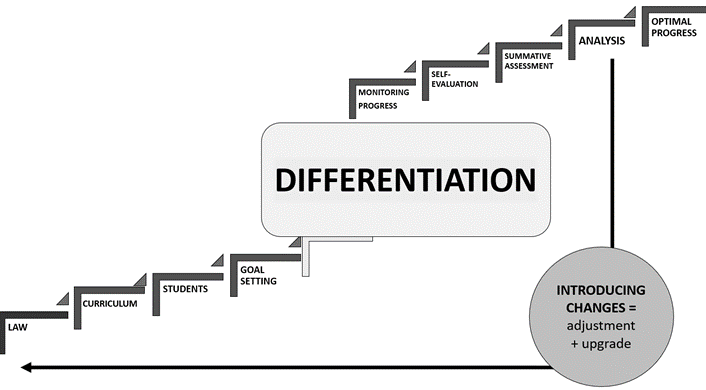
*Figure 1. *Model of planning process of DI.
##### ***What to differentiate, on what basis and how?***
Most authors think that the answer to a question “What kind of adjustments should be made to accommodate differences among students?” (Baker and Fleming, 2005; Gaitas and Alves Martines, 2017; Heacox, 2009; Levy, 2008) are three out of four elements of differentiation model by Tomlinson (2003). These three elements are content, process and product. Other authors state even more elements that are less structured and fragmented but also included in Tomlinson model (Fox & Hoffman, 2011; van Geel et al., 2019).
While planning the content, teachers consider knowledge and skills students should aquire, topics included in the curriculum, resources and materials used, and concepts they would discuss with students. Special attention should be given to the fact that content is synchronized with set goals, that it is suitable, interesting, understandable, related to preknowledge, transferable into practise, useful, diverse, convincing and authentic. That can be provided with varied texts and extra resources on different levels of difficulty (normal, in-depth, advanced) with different online and audiovisual resources, interesting concepts, short lessons, extra explanations for low achievers, skipping learning content for high achievers, making sure students have the possibility of in-depth study ...
While planning the process, teachers often wonder how to teach certain content so that students would understand the information, ideas and skills presented, while keeping learning styles close to students’ needs and interests. Assignments and activities should be focused on setting goals and be related to the content, planned on different levels of difficulty (according to Bloom's taxonomy), especially targeted, diversed, of good quality, meaningful and given in the appropriate order. Teachers can achieve that with different support strategies, agreements, learning contracts, flexible learning groups, encouraging students to be more creative, competitive, but also cooperative and critical in their thinking. It’s important to include students in all activities in as many ways as possible to enable them to practice and achieve results in different ways (Dudley & Osváth, 2016; Gregory & Chapman, 2013; Heacox, 2009; Tomlinson, 2014).
During planning of products, teachers often ponder in what way students will show what they’ve learned, what they know and what they can do, also how they understand things. It is necessary to think that way so teachers can be clear on what they can expect of all students and what of certain individuals (Heacox, 2009; Tomlinson, 2014), because it would be unfair to expect the same results from everyone in the group (Gregory & Chapman, 2013; Wormeli, 2006). The summative assessment is based on clear learning objectives closely related to content through which students can demonstrate what they learned in an authentic way (presented through dialog, oral presentation, role playing or posters), either doing it alone, in pairs or in a group and through that expressing in areas where they are the strongest (according to Gardner's theory of multiple intelligences) in an innovative and unique way (Tomlinson, 2014). Teachers can prepare a set of exercises listed by different levels of complexity so students choose the ones through which they could best show their skills and knowledge (Dudley & Osváth, 2016). Teachers should plan assignments based on high expectations (Bleck & Boakes, 2010) and also pay attention to establishing safe and encouraging learning environment, which according to Gaitas & Alves Martins (2017) can be easier task than adjusting other criteria, but nevertheless it has an important influence on students’ self-image and consequently on better learning results (Dudley & Osváth, 2016). Teachers can adjust elements described above according to standards and curricula with strong consideration of students’ readiness (level of preknowledge, understanding and skill), interests (topics that excite students), learning profile (learning style, learning pace, type of intelligence, gender, cultural background) (Baker & Fleming, 2005; Doubett & Hockett, 2017; Gregory & Chapman, 2013; Levy, 2008; Tomlinson, 2004; Tomlinson, 2014; Tomlinson & Imbeau, 2010), personality (self-confidence, effort) and motivation (Bosker, 2005 in van Geel, 2019; Heacox, 2009). Content, process and product are differentiated based on students’ readiness, interest and learning profile while adjusting difficulty, meaningfulness, thoroughness, flexibility and diversity (Heacox, 2009). According to the theories of Tomlinson (2014) and Heacox (2009) we developed a model of DI that shows us what to differentiate, on what basis and how.
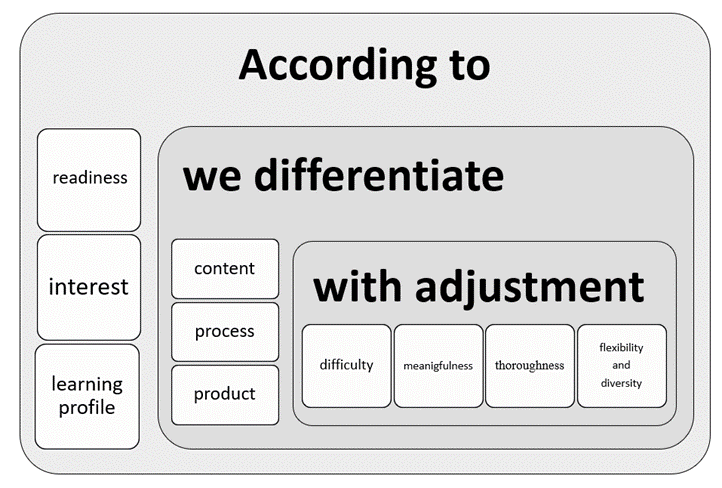
*Figure 2.* Model of DI (according to the theories of Tomlinson, 2014 and Heacox, 2009).
##### **Definition of this study’s problem, its objectives and purpose**
Differentiation enables students to learn according to their needs; better time management; appropriate level of difficulty and challenge; more learning opportunities; increases their motivation and inclusion; enables them to achieve higher level of progress and have more personalized learning experience (Cowley, 2018; Fox & Hoffman, 2011; Gregory & Chapman, 2013; Heacox, 2009; Tomlinson, 2014; van Geel et al., 2019). On the other hand, it is a complex skill that teachers claim to include into their teaching practises, but according to studies realization is far lower than expected or claimed (Baker & Fleming, 2005) and most teachers don’t know how to actually use this skill (Kalin, 2006; van Geel et al., 2019).
The requirement for the use of differentiation is stated in all three valid curricula for teaching English as a foreign language (2013a, 2013b, 2016). Our goal is to see how and to what extent the diversity of students is taken into account in curricula for English as a foreign language and how it is represented in learning materials and lesson plans offered by publishing companies. Based on acquired data we will be able to determine what the critical points are in planning of DI and where more attention should be focused in the future when new strategies and their implementation are planned.
##### **Research questions**
The implementation of DI in teaching English language to young students was determined indirectly with the analysis of different written resources (curricula, textbooks, workbooks, collection of exercises and tasks, lesson plans). Based on literature review we pose these research questions:
RQ1: In what way diversity of students is included in curricula?
RQ2: How and to what extent diversity of students is taken into account and represented in learning materials for teaching English to young students?
RQ3: How diversity of students is taken into account in lesson plans offered by publishing companies?
##### **Methods**
***Research methods***
A descriptive method of empirical research was used.
***Material resources***
To answer the first research question, we used written resources: foreign language curriculum for 1st grade (2013), foreign language curriculum for 2nd and 3rd grade (2013) and curriculum for English as a foreign language (2016).
To answer the second research question, we analised 41 textbooks, workbooks, and collection of worksheets intended for students from 1st to 5th grade.
To answer the third research question, we analised 180 lesson plans that publishing companies offer teachers who use their textbooks and workbooks (online or in a book).
***Data collection process***
All three curricula for foreign language teaching were analised to determine whether differences between students were being considered and how exactly that has been done. We searched for parts of text related to the idea of differentiation and specific mentions of differentiation within curricula.
Analysis of written resources (textbooks, workbooks, collections of worksheets and lesson plans) was done based on our own evaluation instrument that is based on complexity of differentiaton factors based on a theory by Tomlinson (2014), elements of adjustment by Heacox (2009) according to curriculum guidelines for English as foreign language (2013a, 2013b, 2016). We wanted to examine if specified standards were differentiated (standards, minimal standards), if exercises were marked according to their level of complexity, what (content, process, product) and based on what (readiness, interest, learning profile) and in what way (difficulty, meaningfulness, in-depth, flexibility, diversity, support) teachings are being differentiated, also what ways of knowledge assessment are suggested (diagnostic, formative, summative). We believe these indicators of differentiation are suitable for forming indirect conclusions (analysis of curricula, materials, lesson plans). The analysis was done by one person. The evaluation instrument was examined by a professor of English at the Faculty of Education, University of Primorska.
##### **Results and interpretation**
***Differentiation in curricula***
Teachers’ planning is based on curricula; therefore, their in-depth knowledge is crucial. For successful planning of DI, we had to review all three valid curricula for teaching English as a foreign language (2013a, 2013b, 2016). We were searching for instructions in what way teachers should consider all of students’ differences; we also searched for any text that is directly or indirectly related to the subject of differentitation. All three curricula have the same structure, and they upgrade each other. The word differentiation is indirectly mentioned in the definition of the subject, where it is written that teaching and learning of a foreign language should be based on personalization and individualization (2013a; 2013b), taking into regard the growing diversity of students based on language or cultural differences (2016). Differentiation and individualization are highlighted in all three curricula among didactic recommendations. Curricula recognize the problem of heterogeneity (regarding knowledge, skills and understanding). Heterogeneity is defined by internal factors (ability, skill, cognitive style, motivation, learning interests, general knowledge, preknowledge, attitude towards native speakers and their culture) and by external factors (implementation of optional subject in the 1st grade, implementation of enriched curriculum in the preschool period, familiarity with a foreign language, opportunities to learn and use a foreign language in practice). Recommendations suggest testing students for preknowledge and skills. Differentiation (customized content, approaches, and methods to every student’s individual level) in the 1st and 2nd grade should be concentrated on the process of planning, implementing, and testing of progress; from 3rd grade on it should also be included in the assessment of knowledge. Special attention should be paid to specific groups of students (gifted students, students with learning difficulties, students with deficit in knowledge in certain areas, immigrants) to avoid danger of undifferentiated teaching that can lead to loss of motivation for learning, slower progress and bigger chance of becoming a distraction in class. Differentiation is clearly stated in all three curricula under a chapter dedicated to standards of knowledge.
In a chapter about standards of knowledge minimal standards (that all students should achieve) are specified for some skills, also basic standards (an everage student should achieve), whereas higher standards are not specified. In a foreign language curriculum for the 1st grade (2013a) and curriculum for a foreign language for 2nd and 3rd grade (2013b) minimal standards are bolded, whereas in curriculum for English as a foreign language (2016) minimal standards and basic standards are stated separately. Standards of knowledge are the same in all curricula for foreign language for the 1st, 2nd and 3rd grade regarding listening and listening comprehension, speaking and communication with the exception of a standard called – Student detects text in a foreign language. In the 1st grade this standard is categorized as minimal standard, whereas in 2nd and 3rd grade is categorized as basic standard. In 2nd and 3rd grade standards of knowledge are upgraded with standards for reading and reading comprehension.
The curriculum for English as a foreign language contains standards of knowledge for different skills that are divided in 2 groups: for students from 4th to 6th grade and for student from 7th to 9th grade. They are upgraded with standards for writing and presenting (mediation). It is important to keep in mind that not all students’ progress is the same, depending on individual’s linguistic skills (2016).
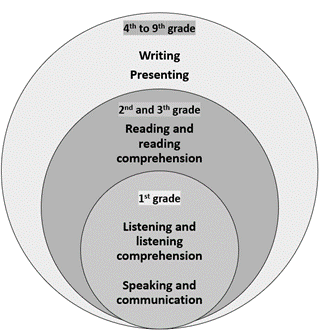
*Figure 3.* Model of upgrading standards of knowledge by skills.
Indirectly differentiation is mentioned among the benefits of learning a foreign language at an early age (2013b), as well as among general goals, operational goals, contents (2016) and in didactic recommendations (2013a, 2013b, 2016). Among the benefits of learning a foreign language at an early age encouraging and safe learning environment, encouraging and effective feedback and authentic didactic materials that meet students’ interests and their cognitive abilities as well learning style, are highlighted (2013 b). General goals emphasize the importance of knowing different cultures and accepting difference and tolerance for diverse opinions; comparing languages and developing analytical thinking skills is also important, as is awareness of responsibilities for learning and knowledge, also making sense of learning material and implementing it into everyday life. Students should learn to use information and communication technology to obtain information, develop organizational skills, they should be able to solve problems and be innovative. Use of support that should be slowly withdrawn is mentioned in operational goals, as are diversity of texts (according to theme and level of difficulty) and diversity of responses (2016). Content is not specifically defined. Topics can be selected by teachers and students. Returning to different topics is advisable as is in-depth and abstract review with more demanding cognitive activities (2016). Didactic recommendations emphasize the importance of inclusion of different forms of learning, team work among teachers, diverse language experience, maintenance of inner motivation, encouragement for research, expression of their experience and insight, encouragement of students to be more mentally active, development of intercultural competence (2013a; 2013b), acceptance of students as equal conversationalists, expension of their vocabulary, and differentiation of homework (2016). Regarding testing and knowledge assessment the meaning of principles of formative assessment is emphasized. Inclusion of student’s interests is also important, as is encouragement of curiosity and creativity, knowing one’s learning goals, cooperation in setting and achieving goals, defining, and applying evalution criteria, self-evaluation of students, analysis of test results and planning of follow-up activities depending on results (2013a; 2013b; 2016).
##### ***Differentiation in learning materials***
**Teaching materials for 1st to 3rd grade**
Table 1. *Number of collected points according to what learning materials for 1st to 3rd grade most often differentiate*
|
| YES
| NO
| SUM
|
| f
| f %
| F
| f %
| f
| f%
|
| content
| 60
| 42.0%
| 83
| 58.0%
| 143
| 100.0%
|
| process
| 63
| 40.4%
| 93
| 59.6%
| 156
| 100.0%
|
| product
| 0
| 0%
| 39
| 100.0%
| 39
| 100.0%
|
Results show that learning materials for 1st to 3rd grade equally differentiate content (f% = 42.0%) and process (f% = 40.4%), on the other hand, product is never differentiated.
Table 2. *Number of collected points based on what learning materials for 1st to 3rd grade most often differentiate *
|
| YES
| NO
| SUM
|
| F
| f %
| f
| f %
| f
| f%
|
| readiness
| 75
| 48.1%
| 81
| 51.9%
| 156
| 100.0%
|
| interest
| 9
| 8.7%
| 95
| 91.3%
| 104
| 100.0%
|
| learning profile
| 40
| 51.3%
| 38
| 48.7%
| 78
| 100.0%
|
Most often differentiation is based on learning profile (f% = 51.3%), a less often differentiation is based on readiness (f% = 48.1%), but it is rarely based on interest (f% = 8.7%).
Table 3. *Number of collected points according to what learning materials for 1st to 3rd grade are most often adjusted*
|
| YES
| NO
| SUM
|
| f
| f %
| f
| f %
| f
| f%
|
| difficulty
| 45
| 86.5%
| 7
| 13.5%
| 52
| 100.0%
|
| meaningfulness
| 30
| 57.7%
| 22
| 42.3%
| 52
| 100.0%
|
| thoroughness
| 2
| 3.8%
| 50
| 96.2%
| 52
| 100.0%
|
| flexibility and diversity
| 42
| 26.9%
| 114
| 73.1%
| 156
| 100.0%
|
Most adjustments are based on level of difficulty (f% = 86.5 %), followed by adjustments according to meaningfulness (f% = 57.7%), flexibility and diversity (f% = 26.9%), whereas thoroughness is rarely adjusted (f% = 3.8%).
**Teaching material for 4th to 5th grade**
Table 4 . *Number of collected points according to what learning materials for 4th and 5th grade most often differentiate*
|
| YES
| NO
| SUM
|
| F
| f %
| f
| f %
| f
| f%
|
| content
| 67
| 50.8%
| 65
| 49.2%
| 132
| 100.0%
|
| process
| 71
| 49.3%
| 73
| 50.7%
| 144
| 100.0%
|
| product
| 0
| 0%
| 36
| 100.0%
| 36
| 100.0%
|
Results show that learning materials for 4th and 5th grade equally differentiate content (f% = 50.8%) and process (f% = 49.3%), on the other hand, product is never differentiated.
Table 5. *Number of collected points based on what learning materials for 4th and 5th grade most often differentiate *
|
| YES
| NO
| SUM
|
| f
| f %
| f
| f %
| f
| f%
|
| readiness
| 88
| 61.1%
| 56
| 38.9%
| 144
| 100.0%
|
| interest
| 13
| 13.5%
| 83
| 86.5%
| 96
| 100.0%
|
| learning profile
| 36
| 50.0%
| 36
| 50.0%
| 72
| 100.0%
|
Most often differentiation is based on readiness (f% = 61.1%), less often differentiation is based on learning profile (f% = 48.1%), but it is rarely based on interest (f% = 13.5%).
Table 6. *Number of collected points according to what learning materials for 4th and 5th grade are most often adjusted*
|
| YES
| NO
| SUM
|
| f
| f %
| F
| f %
| f
| f%
|
| difficulty
| 45
| 93.8%
| 3
| 6.2%
| 48
| 100.0%
|
| meaningfulness
| 31
| 64.6%
| 17
| 35.4%
| 48
| 100.0%
|
| thoroughness
| 12
| 25.0%
| 36
| 75.0%
| 48
| 100.0%
|
| flexibility and diversity
| 37
| 25.7%
| 107
| 74.3%
| 144
| 100.0%
|
Most adjustments are based on level of difficulty (f% = 93.8 %), followed by adjustments according to meaningfulness (f% = 64.6%), flexibility and diversity (f% = 25.7%) and thoroughness (f% = 25.0%).
##### ***Diferentiation in lesson plans offered by publishing companies***
We analysed 180 different lesson plans that publishing companies offer teachers who use their textbooks and workbooks; online or in manuals. The evaluation instrument was the same as for the research question 2.
The analysis showed that lesson plans don’t implement DI, exept for one learning material, otherwise they are poorly written, their main focus is completion of exercises in textbooks and workbooks, some exercises are sometimes added, but mostly they consist of numerous exercises that are not differentiated. Only lesson plans written by one publishing company upgrade learning material according readiness, interest and learning profile. They differentiate exercises in three levels of difficulty and based on different learning styles. Lesson plans in manuals have more quality but even there the lack of differentiation is significant. Lesson plans materials from foreign publishing companies include numerous extensions, review exercises, additional material and teaching tips that were missed in manuals and lesson plans material from Slovene publishing companies. We were also expecting inclusion of more differentiated and interesting exercises, bigger differentiation of products, also more frequent encouragement of students to think and actively participate and cooperate. While analysing lesson plans we detected more examples of diagnostic assessments in a form of brainstorming than in textbooks. There were word lists with known vocabulary, and also more of comprehension test with pictures. More precise definition of summative assessment of knowledge was not given. Futhermore, we miss more active participation of students in the whole learning process.
##### **Conclusions**
Our study shows that curricula for English as a foreign language detect differences among students, are focused on significance of differentiation and its instructions, with separate definitions of standards and minimal standards, with indirect and direct focus on the elements of differentiation, with consideration of different speed of students’ progress according to their abilities, with openness regarding content and spotlighting the danger of undifferentiated teaching they also offer a quality basis for differentiated content, process and product according to knowledge, interests and learning profiles. Quality curricula are the base for differentiation (Tomlinson, 2017) that is why our study aimed to find out if quality base is enough for quality implementation of differentiation in practice.
Quantitative analysis of learning materials showed consideration of differences among students regarding content and process in approximately half of the analysed learning materials. On the other hand, product is never differentiated. Most often differentiation is based on learning profile, only a little less on readiness and very rarely on interests. Most adjustments are based on difficulty, two-thirds on meaningfulness, one-third on flexibility and diversity, while thoroughness adjustments are rare. Based on our research we can conclude that more emphasis will need to be placed on product differentiation based on student interests. Therefore, we suggest that students should be more included as a central figure of the teaching process, which was previously suggested by Marentič Požarnik (2004). In this way we will get more active and motivated students.
In higher grades, they differentiate more often on the basis of readiness and less often on the basis of learning profile. Adaptation of tasks according to all selected criteria is also increasing, but thoroughness, flexibility and diversity still remain a very rarely used form of differentiation.
Our findings show that only one publishing company’s lesson plans include adjustments according to specific groups, others only suggest following the exercises in learning materials. Manuals are more detailed and include a variety of different ways a lesson could be taught. They even highlight critical points in teaching process, and yet most of them still neglect differentiation strategies. Learning materials can be implemented into teaching process in different ways. Therefore, we expected that more elements of differentiation would be included into lesson plans than in the learning materials.
##### **The contribution of this study and its limitations**
The purpose of this study was to get a general overview of the implementation of differentiation and consideration of students’ differences in teaching English as a foreign language from 1st to 5th grade. The study gave us a general insight into the researched topic and elements of differentiation that teachers don’t pay enough attention to.In the future neglected aspects should be thoroughly researched, their effective implementation into pedagogical practice of learning English at an early age should also be considered. While analysing lesson plan materials provided by publishing companies we realized it would be more appropriate to analyse teachers’ lesson plans to get a more direct insight into what is happening during lessons, but we could not provide enough material.
The analysis of learning materials and lesson plans was done by one person that used their own evaluation instrument. Therefore, we have to acknowledge that the results of the study could be different, if another person would be analysing the same materials using their own evaluation instrument.
##### **Further possibilities of research**
The focus of possible further studies should be directed into researching the reasons for less frequent use of certain elements of differentiation. It would also be useful to make a holistic model of DI according to the newest theories of foreign languages teaching to young learners and make thorough consideration of how this should be implemented into practice. That is also what Baker and Fleming (2005) and Smets and Struyven (2020) highlight as the most challenging part.
##### **References**
Al-Subaiei, M. S. (2017). Challenges in Mixed Ability Classes and Strategies Utilized by ELI Teachers to Copewith Them. English Language Teaching, *10*(6), 182–189.
Baartman, L. K., Bastiaens, T. J., Kirschner, P. A., & Van der Vleuten, C. P. (2006). The wheel of competency assessment: Presenting quality criteria for competency assessment programs. *Studies in educational evaluation*, *32*(2), 153–170.
Baker, P. H., & Fleming, L. C. (2005). Lesson plan design for facilitating differentiated instruction.*MIDWESTERN EDUCATIONAL RESEARCHER*, *18*(4), 35.
Blažič, M., Ivanuš Grmek, M., Kramar, M., & Strmčnik, F. (2003). *Didaktika – visokošolski učbenik*. Novomesto: Visokošolsko središče, Inštitut za raziskovalno in razvojno delo.
Blecker, N. S., & Boakes, N.J. (2010). “Creating a Learning Environment for All Children: Are TeachersAble and Willing?” *International Journal of Inclusive Education,* *14*(5), 435–447.
Bourke, R., Mentis, N., & Todd, L. (2011). “Visibly Learning: Teachers’ Assessment Practices for Students with High and Very High Needs.” *International Journal of Inclusive Education,* *15*(4), 405–419.
Caldwell, D. W. (2012). *Educating gifted students in the regular classroom: Efficacy, attitudes, and differentiation of instruction*. Electronic Theses & Dissertations. Paper 822.
Cowley, S. (2018). *The Ultimate Guide to Differentiation: Achieving Excellence for All. *BloomsburyPublishing.
Dijkstra, E.M., Walraven, A., Mooij, T., & Kirschner, A. P. (2017). Factors affecting intervention fidelity of differentiated instruction in Kindergarten. *Research Papers in Education,* *32*(2), 151–169.
Doubet, K. J., & Hockett, J. A. (2017). *Differentiation in the elementary grades: Strategies to engage andequip All learners. *ASCD.
Dudley, E., & Osváth, E. (2016). *Mixed Ability Teaching-Into the Classroom.* Oxford University Press.
Fautley, M., & Savage, J. (2013). *Lesson planning for effective learning*. McGraw-Hill Education (UK).
Fox, J., & Hoffman, W. (2011). *The differentiated instruction book of lists* (Vol. 6). John Wiley & Sons.
Gaitas, S., & Alves Martins, M. (2017). Teacher perceived difficulty in implementing differentiatedinstructional strategies in primary school. *International Journal of Inclusive Education*, *21*(5), 544–556.
George, P. S. (2005). A rationale for differentiating instruction in the regular classroom. *Theory Into Practice*, *44*(3), 185–193.
Gheyssens, E., Consuegra, E., Engels, N., & Struyven, K. (2020). Good things come to those who wait: the importance of professional development for the implementation of differentiatedinstruction. *Frontiers in Education*, *5*, 96.
Gregory, G. H., & Chapman, C. (2013). *One size doesn't fit all. Differentiated instructional strategies: Onesize doesn't fit all.* Corwin press.
Heacox, D. (2009). *Diferenciacija za uspeh vseh.* Ljubljana: Rokus Klett.
Kalin, J. (2006). Možnosti in meje notranje učne diferenciacije in individualizacije pri zagotavljanju enakihmožnosti. *Sodobna pedagogika*, *57*, 78–93.
Khan, I., & Jahan, A. (2017). Relevance of differentiated instructions in english classrooms: an exploratorystudy in the saudi context. *International research journal of human resource and socialsciences*, *4*.
Kotob, M. M., & Jbaili, F. (2020). Implementing Differentiation in Early Education: The Impact on Student’s Academic Achievement. *Journal of Applied Linguistics and Language Research*, *7*(2), 110–133.
Krashen, S. D. (1973). Lateralization, language learning, and the critical period: Some new evidence.*Language learning*, *23*(1), 63–74.
Kubale, V. (2016). *Priročnik za sodobno oblikovanje ali artikulacijo učnega procesa*. Celje: samozaložba
Levy, H. M. (2008). Meeting the needs of all students through differentiated instruction: Helping everychild reach and exceed standards. The Clearing House: *A Journal of Educational Strategies, Issuesand Ideas,* *81*(4), 161–164.
Luspa, D. (2018). Mixed ability classes in efl learning: problems and Solutions. Esteem: *Journal of EnglishStudy Programme,* *1*(1).
Magajna, Z., & Umek, M. (2019). Učne priprave na nastope bodočih učiteljev. *Journal of ElementaryEducation*, *12*(3), 325–350.
Mahmanazarova, F. (2018). Possible problems in mixed-ability classes. *Вопросы науки и образования*, *8*, 130–132.
Marentič Požarnik, B. (2004). *Konstruktivizem v šoli in izobraževanje učiteljev*. Univerza v Ljubljani, Filozofska fakulteta, Center za izobraževanje učiteljev. Ljubljana.
Magableh, I. S. I., & Abdullah, A. (2020). Effectiveness of differentiated instruction on primary school students’ English reading comprehension Achievement. *International Journal of Learning,Teaching and Educational Research*, *19*(3), 20–35.
Meyad, N. R., Roslan, S., Abdullah, M. C., & HajiMaming, P. (2014). The effect of Differentiated LearningMethod in Teaching Arabic Language on Students' Motivation. *Journal of Social Sciences Research*, *5*(1), 671–678.
O’Rourke, J. (2015). “Inclusive Schooling: If It’s So Good – Why Is It So Hard to Sell?” *International Journal of Inclusive Education,* *19*(5), 530–546.
Parsons, S. A., Vaughn, M., Scales, R. Q., Gallagher, M. A., Parsons, A. W., Davis, S. G., … Allen, M. (2018). Teachers’ instructional adaptations: A research synthesis. *Review of Educational Research*, *88*(2), 205–242.
Skribe Dimec, D. (2013). Diferenciacija pri poučevanju naravoslovja v prvem in drugem vzgojno-izobraževalnem obdobju osnovne šole. *Journal of Elementary Education*, 6.
Smets, W., & Struyven, K. (2020). A teachers’ professional development programme to implement differentiated instruction in secondary education: How far do teachers reach?. *Cogent Education*, *7*(1), 1742273.
Učni načrt. (2013a). Program osnovna šola. Tuji jezik v 1. razredu. Ljubljana: Ministrstvo za izobraževanje, znanost in šport: Zavod Republike Slovenije za šolstvo. Retrieved on 21st January 2021 from [http://osfeng1.splet.arnes.si/files/2019/07/TJ\_prvi\_razred\_izbirni\_neobvezni.pdf](http://osfeng1.splet.arnes.si/files/2019/07/TJ_prvi_razred_izbirni_neobvezni.pdf)
Učni načrt. (2013b). Program osnovna šola. Tuji jezik v 2. in 3. razredu. Ljubljana: Ministrstvo za izobraževanje, znanost in šport: Zavod Republike Slovenije za šolstvo. Retrieved on 21st January 2021 from [https://www.gov.si/assets/ministrstva/MIZS/Dokumenti/Osnovna-sola/Ucninacrti/obvezni/UN\_TJ\_2.\_in\_3.\_razred\_OS.pd](https://www.gov.si/assets/ministrstva/MIZS/Dokumenti/Osnovna-sola/Ucninacrti/obvezni/UN_TJ_2._in_3._razred_OS.pd)
Učni načrt. (2016). Program osnovna šola. Angleščina. Ljubljana: Ministrstvo za izobraževanje, znanost inšport: Zavod Republike Slovenije za šolstvo. Retrieved on 21st January 2021 from [https://www.gov.si/assets/ministrstva/MIZS/Dokumenti/Osnovnasola/Ucninacrti/obvezni/UN\_ anglescina.pdf](https://www.gov.si/assets/ministrstva/MIZS/Dokumenti/Osnovnasola/Ucninacrti/obvezni/UN_%20anglescina.pdf)
van Geel, M., Keuning, T., Frèrejean, J., Dolmans, D., van Merriënboer, J., & Visscher, A. J. (2019). Capturing the complexity of differentiated instruction. *School effectiveness and schoolimprovement*, *30*(1), 51–67.
Retelj, A., & Puljić, B. K. (2016). » Potrebujemo več prakse!« Kako bodoče učiteljice in učitelji nemščine vrednotijo svoje izkušnje z mikropoučevanjem?. *Journal of Elementary Education*, *9*(4), 139–154.
Sherin, M. G., & Drake, C. (2009). Curriculum strategy framework: investigating patterns in teachers’ useof a reform-based elementary mathematics curriculum. *Journal of Curriculum Studies*, *41*(4), 467–500.
Shen, Q., & Zhang, J. (2020, July). A Good Lesson Plan is Half Done. In* 2020 International Conference on Advanced Education, Management and Social Science (AEMSS2020), *(pp. 16–18). Atlantis Press.
Tomlinson, C. A. (2003). Teach them all. *Educational Leadership,* *61*(2), 7–9.
Tomlinson, C. A. (2004). “Point/Counterpoint: Sharing Responsibility for Differentiating Instruction.”*Roeper Review,* *26*(4).
Tomlinson, C. A. (2014). *The Differentiated Classroom: Responding to the Needs of All Learners*. ASCD.
Tomlinson, C. A. (2017). *How to Differentiate Instruction in Academically Diverse Classrooms*. Alexandria: ASCD.
Tomlinson, C. A., & Imbeau, M. B. (2010). *Leading and managing a differentiated classroom*. Alexandria, VA: ASCD.
Vygotsky, L. S. (1978). *Mind in Society: The Development of Higher Psychological Processes*. Cambridge,MA: Harvard University Press.
Whipple, K. A. (2012). *Differentiated instruction: A survey study of teacher understanding and implementation in a southeast Massachusetts school district* (Doctoral dissertation) Northeastern University.
Wormeli, R. (2006). *Fair isn’t Always Equal: Assessing and Grading in the Differentiated Classroom*. Portland, ME: Stenhouse.
Zakon o osnovni šoli. Uradni list RS, št. [81/06](http://www.uradni-list.si/1/objava.jsp?sop=2006-01-3535) uradno prečiščeno besedilo, [102/07](http://www.uradni-list.si/1/objava.jsp?sop=2007-01-5073), [107/10](http://www.uradni-list.si/1/objava.jsp?sop=2010-01-5585), [87/11](http://www.uradni-list.si/1/objava.jsp?sop=2011-01-3727), [40/12](http://www.uradni-list.si/1/objava.jsp?sop=2012-01-1700) –ZUJF, [63/13](http://www.uradni-list.si/1/objava.jsp?sop=2013-01-2519) in [46/16](http://www.uradni-list.si/1/objava.jsp?sop=2016-01-1999) –ZOFVI-L. Retrieved on 25th April 2021 from http://www.pisrs.si/Pis.web/pregledPredpisa?id=ZAKO448
Zakon o osnovni šoli. Uradni list RS, št. 81/06 uradno prečiščeno besedilo, 102/07, 107/10, 87/11, 40/12 –ZUJF, 63/13 in 46/16 –ZOFVI-L. Retrieved on 25th April 2021 from http://www.pisrs.si/Pis.web/pregledPredpisa?id=ZAKO448
# Analiza kurikula od prvoga do četvrtog razreda osnovne škole za nastavni predmet Njemački jezik u Republici Hrvatskoj s gledišta međukulturne kompetencije
| ##### **Martina Kramar**
*Grundschule Leoschule Neuss, Neuss*
|
| **Učenje i p(r)oučavanje stranih jezika**
| Broj rada: 77 | **Prethodno priopćenje**
|
| ##### **Sažetak**
|
| U fokusu ovoga rada analiza je *Kurikuluma za nastavni predmet Njemački jezik za osnovne škole i gimnazije u Republici Hrvatskoj* (u daljnjem tekstu: *Kurikulum za nastavni predmet Njemački jezik*) iz 2019. godine, i to program za prvi strani jezik od prvoga do četvrtog razreda osnovne škole. Temeljni je cilj rada prikazati kvalitativnu analizu sadržaja *Kurikuluma za nastavni predmet Njemački jezik* (2019) vezanu uz implementaciju međukulturne kompetencije u trima kategorijama: *(1) Odgojno-obrazovni ciljevi učenja i poučavanja*, *(2) Odgojno-obrazovni ishodi* te *(3) Vrednovanje*. *Kurikulum za nastavni predmet Njemački jezik* donesen je 2019. godine *Odlukom* Ministarstva znanosti i obrazovanja, a njegov prethodnik *Nastavni program za Njemački jezik* kao integralni dio *Nastavnoga plana i programa za osnovnu školu* datira iz 2006. godine. Uvodni dio rada obuhvaća međunarodne modele međukulturne kompetencije prema Erll i Gymnich (2007) te drugim autoricama i autorima, temeljne definicije kurikula i prikaz europskih dokumenata vezanih uz razvoj kurikula za strane jezike. Rezultati kvalitativne analize sadržaja *Kurikuluma za nastavni predmet Njemački jezik* (2019) u Republici Hrvatskoj pokazuju da je poticanje međukulturnih znanja i vještina zastupljeno i pobliže definirano u kategorijama *(1) Odgojno-obrazovni ciljevi učenja i poučavanja* te *(2) Odgojno-obrazovni ishodi*. U kategoriji *(3) Vrednovanje* moguće je identificirati evaluaciju odgojno-obrazovnih ishoda koji se odnose na znanja o vlastitoj kulturi i drugim kulturama te na vještine međukulturnog ophođenja.
|
| ***Ključne riječi***
|
| *analiza kurikula; međukulturna kompetencija; odgojno-obrazovni ciljevi; strani jezici; vrednovanje*
|
##### **Uvod**
Međukulturna kompetencija dio je hrvatske obrazovne politike i moguće ju je identificirati u više obrazovno-političkih dokumenata. Njezinu uključivanju u odgojno-obrazovne procese ranoga, predškolskoga i primarnog obrazovanja pridaje se sve više pozornosti. Međukulturna kompetencija spominje se već u Nacionalnome programu odgoja i obrazovanja za ljudska prava i demokratsko građanstvo Vlade Republike Hrvatske iz 1999. godine, koja uključuje identitetni i interkulturalni odgoj i obrazovanje. Sadržaji toga Dokumenta obuhvaćeni su u Nastavnome planu i programu za osnovnu školu (2006) Republike Hrvatske, koji ističe osuvremenjivanje pristupa nastavi stranih jezika uz uvođenje poticanja međukulturne kompetencije, kao jednog od novih sadržaja uz strategije učenja. Sljedeći dokument u kojem se naglašava poticanje međukulturne kompetencije jest Nacionalni okvirni kurikulum za predškolski odgoj i obrazovanje te opće obvezno i srednjoškolsko obrazovanje (MZOŠ, 2011). Dokument ističe važnost usmjerenosti odgoja i obrazovanja prema osam temeljnih kompetencija za cjeloživotno obrazovanje utemeljenih Preporukom Europskog parlamenta i savjeta od 18. prosinca 2006. o ključnim kompetencijama za cjeloživotno učenje (Preporuka Europskog parlamenta i savjeta…, 2006). Međukulturna se kompetencija u Nacionalnome okvirnome kurikulumu spominje u tri od osam temeljnih kompetencija: Komunikacija na stranim jezicima, Socijalna i građanska kompetencija te Kulturna svijest i izražavanje (MZOŠ, 2011, str. 17). Razvoj nacionalnoga kurikula usmjeren na razvoj kompetencija, a ne samo na prijenos znanja predstavlja, kako u drugim europskim zemljama tako i u Republici Hrvatskoj, pomak u kurikulskoj politici i programiranju odgoja i obrazovanja. Njegovo daljnje inoviranje i osuvremenjivanje te usklađivanje različitih dokumenata obrazovne politike početni su koraci Cjelovite kurikularne reforme temeljene na Strategiji obrazovanja, znanosti i tehnologije koju je 2014. godine donio Hrvatski sabor.
Prema Strategiji, obrazovanje će biti zasnovano na sljedećim načelima: „\[…\] sve osobe – a napose one izložene marginalizaciji i isključenosti – bit će uključene u sustav obrazovanja koje će biti utemeljeno na znanstvenim spoznajama, poštovat će se ljudska prava i prava djece \[…\], odluke će se donositi na demokratski način uz sudjelovanje svih ključnih čimbenika, škole i nastavnici bit će samostalni u osmišljavanju svojeg rada, poštovat će se interkulturalizam i europska dimenzija obrazovanja“ (Hrvatski sabor, 2014, str. 1) Kao što je razvidno iz citata, u Strategiju se uvodi pojam interkulturalizam kao bitan dio odgojno-obrazovnih vrijednosti, a njime se ističe „razumijevanje i prihvaćanje kulturnih razlika da bi se smanjili neravnopravnost i predrasude prema pripadnicima drugih kultura“ (ibid., str. 18). Međutim, i odgojno-obrazovna vrijednost identitet naglašava da „odgoj i obrazovanje trebaju buditi, poticati i razvijati osobni identitet, a odlika osobnoga identiteta pretpostavlja poštovanje različitosti“ (ibid., str. 16). Kao što je razvidno iz Strategije (2014), razvoj i poticanje dviju spomenutih odgojno-obrazovnih vrijednosti odnose se na sve nastavne predmete, a ne samo na nastavu stranih jezika.
Cjelovita kurikularna reforma prva je mjera Strategije obrazovanja, znanosti i tehnologije (2014), a u skladu s njom nastaje Okvir nacionalnog kurikuluma (MZOS, 2016). ONK predstavlja temelje za izradu nacionalnih kurikula za različite razine te vrste odgoja i obrazovanja, uvažavajući njihove posebnosti i potrebe po uzoru na koje se razvijaju predmetni i međupredmetni kurikuli. Tako se unutar Okvira nacionalnog kurikuluma u vidu generičke kompetencije Osobni i socijalni razvoj naglašava usvajanje znanja, razvoj vještina i spremnosti djece i mladih osoba za aktivno građanstvo, kojim se ističe kako djeca i mlade osobe trebaju „imati razvijenu multikulturalnu i interkulturalnu pismenost koja im omogućuje da uvažavaju različitosti, odgovorno se odnose prema drugima i drugačijima i da surađuju u različitim okruženjima“ (ibid., str. 16). Po uzoru na spomenute obrazovno-političke dokumente razvijeni su predmetni kurikuli za osnovne škole i gimnazije te kurikuli za međupredmetne teme: Građanski odgoj i obrazovanje, Osobni i socijalni razvoj te Uporaba informacijske i komunikacijske tehnologije, objavljeni 2019. godine. Kao jedan od predmetnih kurikula, 2019. godine donesen je i Kurikulum za nastavni predmet Njemački jezik za osnovne škole i gimnazije u Republici Hrvatskoj (u daljnjem tekstu: Kurikulum za nastavni predmet Njemački jezik) Odlukom Ministarstva znanosti i obrazovanja.
Obratimo li pozornost na međukulturnu kompetenciju u praksi, opaža se prisutnost negativnih stavova studentica i studenata te učenica i učenika srednjih, ali i osnovnih škola na području Republike Hrvatske prema pojedincima s obzirom na njihovu kulturološku, jezičnu ili društvenu pripadnost (Velički i Šenjug, 2010; Mrnjaus, 2013; Ivandić i Löw, 2017; Šenjug Krleža, 2019 ). U nastavku na taj istraživački problem, ovaj rad posvećen je kvalitativnoj analizi sadržaja kurikula i ispituje sustavnu uključenost međukulturne kompetencije u Kurikulum za nastavni predmet Njemački jezik (2019), kako bismo dobili detaljniji uvid njezine integracije u temeljne obrazovno-didaktičke aspekte nastave Njemačkoga kao prvoga stranog jezika. U fokusu kvalitativne analize sadržaja Kurikuluma za nastavni predmet Njemački jezik (2019) prva su četiri razreda osnovne škole. Naime, više je pozornosti potrebno usmjeriti na važnost poticanja međukulturne otvorenosti i tolerancije, i to već od prvog razreda osnovne škole. Unatoč tome što je međukulturna kompetencija postala dio i drugih nastavnih predmeta osnovne škole u Republici Hrvatskoj, predmet analize ovog rada predstavlja upravo nastavni predmet Njemački kao prvi strani jezik zahvaljujući dugogodišnjim istraživanjima iz područja didaktike stranih jezika u kontekstu međunarodnog razvoja i poticanja međukulturne kompetencije (usp. Byram, 1997, 2009; Sercu, 2005; Caspari i Schinschke, 2007; 2009).
Uvodna poglavlja prikazuju temeljne definicije kurikula, modele međukulturne kompetencije te prikaz dokumenata vezanih uz razvoj kurikula za strane jezike. U dijelu rada posvećenom kvalitativnoj analizi sadržaja kurikula prvo se opisuje metodologija i donosi prikaz relevantnih istraživanja te se potom prezentiraju rezultati analize Kurikuluma za nastavni predmet Njemački jezik (2019).
**Kurikuli stranih jezika i međunarodni dokumenti**
Termin curriculum potječe iz latinskoga jezika te je u srednjem vijeku označavao tijek, slijed i put do rezultata ili cilja (Previšić, 2007). Prema Marsh i Stafford (1988) kurikul jest skup međusobno koreliranih planova i iskustava koje učenik posjeduje pod školskim vodstvom. Strugar (2012, str. 77) ističe kako je kurikul filozofija odgoja i obrazovanja, planiranje, programiranje i ostvarivanje ciljeva te temelj djelovanja, mijenjanja i unaprjeđivanja nacionalnoga i školskog života. Previšić (2007, str. 22) pak definira kurikul kao „\[…\] optimalni, racionalni i interdisciplinarni konsenzus koji prihvaća višeslojnost čovjekova bića. Ali on jest pedagoški usmjeren opći cilj odgoja, kao svojevrsnog ideala, što se realizira kroz posebne zadatke u formi nastavnog plana i različitih programa, kataloga znanja, obrazovnih standarda, taksonomije postignuća i slično.“
Međunarodni dokumenti koji doprinose kvaliteti izrade kurikula stranih jezika u okviru definiranja jezične komunikacijske i međukulturne kompetencije, ali i postavljanja odgojno-obrazovnih ciljeva te ishoda učenja između ostaloga jesu: Vodič za razvoj i implementaciju kurikula za plurilingvalno i međukulturno obrazovanje (Beacco i sur., 2016), Zajednički europski referentni okvir za jezike ‒ ZEROJ (Vijeće Europe, 2005) te Višejezični kurikul (Krumm i Reich, 2011). Temeljni cilj ZEROJ-a (2005) jest osigurati kvalitetno i integrativno obrazovanje kao temeljno građansko pravo svakoga pojedinca. Njime se proširuje pogled na jezično obrazovanje, primjerice percipirajući korisnike jezika kao učenike koji participiraju u društvu te interakcijom zajedno konstruiraju značenje. To se posebno ističe u koncepciji medijacije te plurilingvalnih, odnosno plurikulturnih kompetencija uz upotrebu deskriptora za pojedine razine i kompetencije u Dopunskome svesku ZEROJ-u (Council of Europe, 2018). Nadalje, prema Vodiču za razvoj i implementaciju kurikula za plurilingvalno i međukulturno obrazovanje (Beacco i sur., 2016, str. 9f) planiranje kurikula treba pokriti različite aspekte školovanja, kako bi se osigurala njegova ukupna koherentnost: „općenite ciljeve, specifične ciljeve i kompetencije, nastavne sadržaje, pristupe i aktivnosti, materijale i resurse, prostorno-vremenske dimenzije, ulogu nastavnika te suradnju s drugim školama i vrednovanje”.
Višejezični kurikul prema Krumm i Reich (2011) posebno se ističe poticanjem integracije jezičnog obrazovanja te doprinosi orijentaciji učenika i učenica u današnjem svijetu jezične raznolikosti te samoodređenom i svrhovitom stjecanju novih jezičnih kvalifikacija, kao i kompetentnome „snalaženju” u višejezičnim situacijama. Dokument sadrži ciljeve, didaktičke principe i obrazovne sadržaje za pojedina područja na svim obrazovnim razinama austrijskih škola. On nadilazi predmetnu dvojnost „materinskog jezika” i „stranog jezika” imajući u vidu stvarnu višejezičnost koja realno opisuje jezične situacije u mnogim mjestima i školama diljem svijeta (ibid.; prev. M. K.).
**Međukulturna kompetencija**
Razvoj međukulturne kompetencije kao konstrukt koji se sastoji od tri i više dimenzija prikazuje se u mnogim međunarodno priznatim modelima iz perspektive didaktike stranih jezika, ali i međukulturne pedagogije (usp. Bennett, 1993; Byram 1997; Erll i Gymnich, 2007; Göbel i Buchwald, 2017; Allemann-Ghionda, 2014). U okviru nastave stranih jezika međukulturna kompetencija često se povezuje s komunikacijskom jezičnom kompetencijom. Tako Zajednički europski referentni okvir za jezike (2005) međukulturnu kompetenciju prikazuje u sklopu komunikacijskih aktivnosti, a najzastupljenija je u području općih kompetencija. Primjerice, prema Byramovu Modelu međukulturne komunikacijske kompetencije (1997) međukulturna komunikacijska kompetencija sastoji se od međukulturne, lingvističke, sociolingvističke i diskursne kompetencije koje se međusobno isprepliću. Allemann-Ghionda (2013, str. 64) definira međukulturnu kompetenciju iz perspektive međukulturne pedagogije raznolikosti (njem. Interkulturelle Pädagogik der Diversität) kao „skup znanja te analitičkih, afektivnih i komunikacijskih vještina koje pojedincu, između ostalog, omogućuju spoznaju ljudskih obrazaca ponašanja koji bi mogli biti sociokulturno specifični i percipirani kao 'različitosti' te razumijevanje da se radi o rezultatima određene povijesti, socijalizacije, biografije, odnosno o društvenim konstrukcijama“ (prev. M. K.).
Erll i Gymnich (2007) dijele međukulturnu kompetenciju na tri takozvane „podkompetencije” iz kognitivne, afektivne i pragmatičko-komunikacijske domene. Kognitivna „podkompetencija” obuhvaća znanje relevantno za međukulturne susrete koje se odnosi na znanje o kulturama i ciljnim zemljama. Naglasak je na teorijskoj razini s ciljem usvajanja funkcionalnoga znanja o ciljnoj kulturi, međukulturnim razlikama te njihovim implikacijama u svakodnevnoj interakciji. Refleksija vlastitoga ponašanja te samopoimanje također predstavljaju relevantan dio navedene dimenzije (usp. ibid.). Fokus afektivne „podkompetencije” usmjeren je na vlastite stavove o pripadnicima i pripadnicama drugih kultura. Erll i Gymnich (2007) ističu važnost interesa i pozitivnoga stava o drugim kulturama kao neophodan preduvjet za uspješnu međukulturnu komunikaciju. Od velike važnosti su empatija, razumijevanje drugih i drugačijih te sposobnost primjećivanja suptilnih komunikacijskih signala. Pragmatičko-komunikacijska „podkompetencija” sadrži strategije rješavanja sukoba i niz komunikacijskih strategija koje se pozitivno odražavaju na uspješnu i produktivnu interakciju s pripadnicama i pripadnicima drugih kultura (usp. ibid.). Erll i Gymnich (2007) zagovaraju širu definiciju međukulturne kompetencije i ističu da se međukulturni kontakti ne odnose samo na komunikaciju s osobama iz drugih zemalja, već je riječ o svakom kontaktu koji podrazumijeva interakciju između pripadnika različitih kulturnih ili društvenih skupina, a susrećemo ih i u vlastitoj zajednici.
U nastavku teksta prikazuju se metode kvalitativne analize kurikula s obzirom na međukulturnu kompetenciju te rezultati istraživanja.
**Metode**
Rad je posvećen kvalitativnoj analizi sadržaja Kurikuluma za nastavni predmet Njemački jezik (2019) od prvoga do četvrtog razreda osnovnih škola. Temeljni cilj rada jest istražiti u kojoj je mjeri međukulturna kompetencija uključena u aktualni Kurikulum za nastavni predmet Njemački jezik (prvi strani jezik) iz 2019. godine u trima kategorijama sadržaja: (1) Odgojno-obrazovni ciljevi učenja i poučavanja, (2) Odgojno-obrazovni ishodi i (3) Vrednovanje. Kategorije sadržaja definirane su uz pomoć deduktivnog postupka po uzoru na Göbel i Hesse (2004). Autori istražuju međukulturnu kompetenciju u kurikulima za nastavni predmet Engleski jezik za devete razrede u šesnaest saveznih zemalja Savezne Republike Njemačke (ibid.). Kategorije sadržaja u njihovu istraživanju definirane su prema Bennettovom (1993) Razvojnomu modelu interkulturalne osjetljivosti (DMIS). Na području Republike Hrvatske također su zabilježeni brojni izvorni znanstveni radovi koji prikazuju domaće i međunarodne analize te usporedbe temeljnih obrazovnih dokumenata za različite nastavne predmete (usp. Petravić, 2010; Mandarić Vukušić, 2014; Bežen, 2013; Prpić, 2009).
Centralni model za kvalitativnu analizu sadržaja Kurikuluma za nastavni predmet Njemački jezik (2019) u Republici Hrvatskoj predstavlja Model međukulturne kompetencije prema Erll i Gymnich (2007) koji obuhvaća širu definiciju međukulturne kompetencije i sastoji se od triju komponenata (kognitivne, afektivne i pragmatičko-komunikacijske „podkompetencije“) koje su usporedne prikazu međukulturne kompetencije u analiziranom kurikulskom dokumentu u obliku znanja, vještina i stavova (MZO, 2019, str. 6). Kategorije sadržaja ovog istraživanja prilagođene su strukturi Kurikuluma za nastavni predmet Njemački jezik (2019) u Republici Hrvatskoj koji se sastoji od sedam poglavlja: Svrha i opis predmeta, Odgojno-obrazovni ciljevi učenja i poučavanja predmeta, Struktura – Domene predmetnoga kurikuluma, Odgojno-obrazovni ishodi, sadržaji i razine usvojenosti po razredima i domenama, Povezanost s drugim predmetima i međupredmetnim temama, Učenje i poučavanje predmeta te Vrednovanje usvojenosti odgojno-obrazovnih ishoda.
Prezentacija rezultata kvalitativne analize sadržaja Kurikuluma za nastavni predmet Njemački jezik (2019) u Republici Hrvatskoj u trima kategorijama slijedi u nastavku.
**Rezultati**
Kategorija (1) Odgojno-obrazovni ciljevi učenja i poučavanja
Prikaz rezultata kvalitativne analize sadržaja Kurikuluma za nastavni predmet Njemački jezik (2019) u Republici Hrvatskoj s aspekta međukulturne kompetencije započeti ćemo sadržajnom kategorijom Odgojno-obrazovni ciljevi učenja i poučavanja. Kurikulumom (2019) se potiče „razvoj mišljenja koje karakterizira otvorenost i zainteresiranost za jezike i međukulturnu komunikaciju te poštovanje kulturne raznolikosti” (MZO, 2019, str. 2). To doprinosi razvoju međusobnoga razumijevanja i poštovanja među pripadnicima različitih kulturnih i socijalnih skupina, ali i razvoju svijesti o vlastitoj kulturi i materinskome jeziku. Republika Hrvatska uvažava smjernice Europske unije i Vijeća Europe te omogućuje učenicima tijekom obveznog obrazovanja uz materinski jezik ovladavanje i dvama stranim jezicima. Njemački se jezik kao prvi strani jezik u osnovnim školama Republike Hrvatske poučava od 1. razreda osnovne škole kao obvezni predmet, a od 4. razreda kao izborni predmet (usp. ibid.).
Poticanje međukulturne kompetencije posebno se ističe u sljedećim odgojno-obrazovnim ciljevima učenja i poučavanja (MZO, 2019, str. 3): „Osposobljavanje učenika i učenica za samostalnu, aktivnu, svrsishodnu i učinkovitu komunikaciju na njemačkome jeziku s izvornim i neizvornim govornicima njemačkoga jezika te za razvoj višejezične kompetencije uzimajući u obzir suvremene okolnosti života u Europi i svijetu i povećanu potrebu za mobilnošću.
Poticanje pozitivnog utjecaja na cjelokupni jezični razvoj učenika i razvoj njegove višejezične kompetencije podižući jezičnu svjesnost i svjesnost o učenju jezika, povezujući učenje i poučavanje njemačkoga jezika s učenjem i poučavanjem materinskoga jezika i drugih stranih jezika te pripremajući učenike za učenje svakoga daljnjeg stranoga jezika i za uporabu jezičnih predznanja u konstelaciji kad njemački uče kao drugi strani jezik.
Omogućavanje upoznavanja kulturnih obilježja njemačkoga govornog područja te poticanje razvoja pozitivnoga stava i uvažavanja posebnosti kultura njemačkoga govornog područja i njihovih pripadnika radi osposobljavanja za snalaženje u multikulturnome društvu, ali i za uvažavanje bogatstva i vrijednosti osobnoga nacionalnog identiteta.”
U preostalim odgojno-obrazovnim ciljevima učenja i poučavanja spominje se važnost cjelovitoga razvoja osobnosti učenika i socijalnih vještina, poticanje kritičkoga mišljenja te pronalaženja kreativnih i inovativnih rješenja problema. Kurikulum (2019) ističe i povezanost Republike Hrvatske sa zemljama njemačkoga govornog područja te relevantnost daljnjega razvijanja pozitivnoga stava prema njegovanju te povezanosti (usp. ibid., str. 3).
Nadalje, Kurikulum za nastavni predmet Njemački jezik u Republici Hrvatskoj obuhvaća tri međusobno povezane domene: Komunikacijska jezična kompetencija, Međukulturna komunikacijska kompetencija i Samostalnost u ovladavanju jezikom (MZO, 2019, str. 4). Primjerice, razvojem komunikacijske jezične sposobnosti, kao procesa izražavanja svojega identiteta i razumijevanja identiteta svojega sugovornika, potiče se i socijalizacija te cjelokupan razvoj osobnosti učenika. Uvažavajući preporuke Vijeća Europe, obrazovni sustav Republike Hrvatske uključuje razvoj međukulturnosti u program učenja i poučavanja nastavnoga predmeta Njemački jezik na svim razinama obrazovanja, kako bi se naglasila važnost razvoja učenikove svjesnosti o sebi kao pojedincu i društvenome biću zainteresiranome za upoznavanje i učenje o različitosti. U navedenome Kurikulumu za nastavni predmet Njemački jezik (2019), domena Međukulturna komunikacijska kompetencija uključuje „razumijevanje i komuniciranje među govornicima njemačkoga jezika različitoga kulturnoga podrijetla” (ibid., str. 4). Sukladno Dokumentu, njezin razvoj pomaže učenicima odbaciti predrasude i osnažuje ih u sprečavanju diskriminacije i nenasilnome rješavanju sukoba te doprinosi razumijevanju, proširivanju i produbljivanju njihovih pogleda na svijet, što im omogućuje uspješno sudjelovanje u užoj i široj zajednici, u stvarnome i digitalnome okružju te povećava mogućnosti za mobilnost i zapošljivost (ibid.).
Kategorija (2) Odgojno-obrazovni ishodi
Sukladno Kurikulumu za nastavni predmet Njemački jezik (2019) u Republici Hrvatskoj, temelj učenja i poučavanja njemačkoga jezika čine odgojno-obrazovni ishodi u domeni Komunikacijska jezična kompetencija koji se sadržajno i metodološki dopunjuju odgojno-obrazovnim ishodima domena Međukulturna komunikacijska kompetencija i Samostalnost u ovladavanju jezikom (MZO, 2019, str. 4). Uz odgojno-obrazovne ishode svake domene navodi se i razrada ishoda u kojoj se ishodi iscrpnije diferenciraju i kumulativno razvijaju po razredima. Primjerice, viši razredi uključuju i ishode formulirane za prethodne razrede. Razrada ishoda temelji se na stupnju složenosti sadržaja i komunikacijskih situacija ‒ postupno od jednostavnih i poznatih do složenih i nepoznatih te na očekivanoj razini postignuća (ibid., str. 6). Napominje se da je aktivnosti povezane s pojedinim razradama ishoda po potrebi moguće provesti na materinskome jeziku, ukoliko trenutačna jezična razina učenika na njemačkome jeziku nije dostatna (ibid.).
Prema promatranome Kurikulumu za nastavni predmet Njemački jezik Republike Hrvatske, ostvarivanjem odgojno-obrazovnih ishoda unutar domene Međukulturna komunikacijska kompetencija učenik postaje međukulturno kompetentan što znači da je (MZO, 2019, str. 4):
„sposoban objektivno sagledati sličnosti i razlike među kulturama
sposoban učinkovito i primjereno kontekstu komunicirati s izvornim i neizvornim govornicima njemačkoga jezika, što dovodi do uvažavanja sugovornika različitih kulturnih identiteta i izgrađivanja skladnih međukulturnih odnosa
empatičan, prilagodljiv i otvoren za razumijevanje, prihvaćanje i uvažavanje govornika njemačkoga jezika i njihove kulture.”
Za svaki odgojno-obrazovni ishod u okviru pojedinih domena određen je pokazatelj razine usvojenosti (ostvarenosti) odgojno-obrazovnih ishoda „dobar” koji služi kao okvir za procjenu ostvarenosti i razumijevanja dubine i širine pojedinoga ishoda na kraju razreda (MZO, 2019, str. 5). Primjerice, domenu Međukulturna komunikacijska kompetencija čine ishodi u trima međusobno povezanim komponentama: „znanje (kulturno specifična i općenita znanja o fenomenu kulture), vještine (interpretacija kulturno uvjetovanih sadržaja i interakcija u međukulturnim kontaktima) i stavovi (znatiželja, otvorenost, spremnost na prevladavanje stereotipa i predrasuda)” (MZO, 2019, str. 6). S fokusom na usvajanje ishoda učenja iz prvih dviju domena, razrada ishoda temelji se na stupnju složenosti sadržaja i komunikacijskih situacija (od jednostavnih, poznatih do složenih, nepoznatih) te na očekivanoj razini postignuća (ibid.). Sljedeća tablica prikazuje komparativni prikaz odgojno-obrazovnih ishoda za 1. i 2. razred, kako bismo dobili uvid u njihovo razvijanje po razredima.
Tablica 1. Usporedni prikaz odgojno-obrazovnih ishoda za 1. i 2. razred (MZ0, 2019, str. 7-10)
| „Međukulturna komunikacijska kompetencija
|
| Odgojno-obrazovni ishodi za 1. razred
| Odgojno-obrazovni ishodi za 2. razred
|
| OŠ (1) NJ B.1.1.
Učenik prepoznaje osnovne elemente
kultura povezanih s njemačkim jezikom.
| OŠ (1) NJ B.2.1.
Učenik navodi osnovne informacije o zemljama njemačkoga govornog područja i prepoznaje sličnosti i razlike između vlastite kulture i kultura povezanih s njemačkim jezikom.
|
| OŠ (1) NJ B.1.2.
Učenik prepoznaje osnovne obrasce uljudnoga ophođenja prema drugima u vlastitoj kulturi i kulturama povezanima s njemačkim jezikom.
| OŠ (1) NJ B. 2.2.
Učenik uočava vrlo jednostavne primjere pozitivnih načina ophođenja prema osobama u vlastitoj kulturi i drugim kulturama.
|
| OŠ (1) NJ B.1.3.
Učenik pokazuje otvorenost i znatiželju za kulture povezane s njemačkim jezikom.
| OŠ (1) NJ B. 2.3.
Učenik pokazuje otvorenost i znatiželju za kulture povezane s njemačkim jezikom te za strane i nerazumljive sadržaje.“
|
Iz prikaza odgojno-obrazovnih ishoda za prvi razred u Tablici 1 vidljivo je da bi učenice i učenici u okviru nastave Njemačkoga jezika za prvi strani jezik na kraju prvoga razreda trebali moći prepoznati osnovne elemente kultura povezanih s njemačkim jezikom, kao i osnovne obrasce uljudnoga ophođenja prema drugima u vlastitoj kulturi i kulturama povezanima s njemačkim jezikom (MZO, 2019). Nadalje, stavlja se naglasak na prepoznavanje osnovnih obrazaca uljudnoga ophođenja i na pokazivanje otvorenosti te znatiželje za kulture povezane s njemačkim jezikom. U drugome razredu naglašava se navođenje osnovnih informacija o zemljama njemačkoga govornog područja i prepoznavanje sličnosti i razlika između vlastite kulture i kultura povezanih s njemačkim jezikom (ibid.). Pokazivanje otvorenosti i znatiželje za kulture povezane s njemačkim jezikom u drugome razredu nadopunjava se i pokazivanjem otvorenosti za strane i nerazumljive sadržaje (ibid.).
Razvoj međukulturnih vještina i kompetencija navedenih u odgojno-obrazovnim ishodima za prvi i drugi razred većim dijelom moguće je identificirati u kognitivnim i afektivnim „podkompetencijama” međukulturne kompetencije prema Erll i Gymnich (2007). Primjerice, „iskazivanje otvorenosti i znatiželje za kulture povezane s njemačkim jezikom te za strane i nerazumljive sadržaje” dio je afektivne „podkompetencije”, dok se „prepoznavanje sličnosti i razlika između vlastite kulture i kultura povezanih s njemačkim jezikom” može primarno svrstati u kognitivnu, ali i afektivnu „podkompetenciju” zbog pratećih procesa koji se odvijaju u pozadini prilikom komparacije dviju kultura.
U nastavku teksta prikazuje se usporedni prikaz odgojno-obrazovnih ishoda navedenih u Kurikulumu za nastavni predmet Njemački jezik (2019) za 3. i 4. razred.
Tablica 2. Usporedni prikaz odgojno-obrazovnih ishoda za 3. i 4. razred (MZ0, 2019, str. 12-15)
| „Međukulturna komunikacijska kompetencija
|
| Odgojno-obrazovni ishodi za 3. razred
| Odgojno-obrazovni ishodi za 4. razred
|
| OŠ (1) NJ B.3.1.
Učenik opisuje osnovne elemente kultura povezanih s njemačkim jezikom u aspektima svakodnevnoga života te prepoznaje sličnosti i razlike između vlastite kulture i kulture drugih kultura.
| OŠ (1) NJ B.4.1.
Učenik opisuje osnovne elemente kultura povezanih s njemačkim jezikom u aspektima svakodnevnoga života te na jednostavnim i konkretnim primjerima opisuje sličnosti i razlike između vlastite kulture i drugih kultura.
|
| OŠ (1) NJ B. 3.2.
Učenik opisuje jednostavne primjere pozitivnih načina ophođenja prema osobama u vlastitoj kulturi i drugim kulturama te primjereno reagira.
| OŠ (1) NJ B. 4.2.
Učenik opisuje jednostavne primjere međukulturnih susreta te razmatra moguće uzroke i rješenja nesporazuma.
|
| OŠ (1) NJ B. 3.3.
Učenik reagira otvoreno i s interesom na strane i nerazumljive sadržaje.
| OŠ (1) NJ B. 4.3.
Učenik reagira otvoreno i s interesom na strane i nerazumljive sadržaje, ponašanja i situacije.“
|
Iz usporednog prikaza odgojno-obrazovnih ishoda u Tablici 2 razvidno je da učenice i učenici na kraju trećeg razreda opisuju osnovne elemente kultura povezanih s njemačkim jezikom u aspektima svakodnevnoga života te prepoznaju sličnosti i razlike između vlastite kulture i drugih kultura (MZO, 2019). U četvrtome razredu taj se ishod učenja proširuje na opisivanje sličnosti i razlika između vlastite kulture i drugih kultura, na temelju jednostavnih i konkretnih primjera (ibid.). U trećem razredu učenice i učenici opisuju jednostavne primjere pozitivnih načina ophođenja prema osobama u vlastitoj kulturi i drugim kulturama te reagiraju primjereno, otvoreno i s interesom na strane i nerazumljive sadržaje (ibid.). Osim toga Kurikulum (2019) ističe kako učenice i učenici u četvrtome razredu opisuju jednostavne primjere međukulturnih susreta i razmatraju moguće uzroke i rješenja nesporazuma te reagiraju otvoreno i s interesom na strane i nerazumljive sadržaje, ponašanja i situacije (ibid.). U trećem i četvrtom razredu naglašava se važnost iskazivanja interesa za strane i nerazumljive sadržaje, ponašanja i situacije te se polazi u smjeru vlastitoga međukulturnog djelovanja i prvih primjena usvojenih vještina i kompetencija u međukulturnim situacijama koje su dio afektivnih, ali i pragmatičko-komunikacijskih „podkompetencija” međukulturne kompetencije prema Erll i Gymnich (2007).
Kategorija (3) Vrednovanje
Analizom treće kategorije sadržaja Vrednovanje utvrđeno je da se u Kurikulumu za nastavni predmet Njemački jezik „vrednuju znanja i vještine definirane odgojno-obrazovnim ishodima unutar domene Komunikacijska jezična kompetencija” (MZO, 2019, str. 102). U okviru domene Međukulturna komunikacijska kompetencija „vrednuju se ishodi koji se odnose na znanja o vlastitoj kulturi i drugim kulturama te na vještine međukulturnoga ophođenja i njihova se ostvarenost ocjenjuje posredno vrednovanjem ishoda iz domene Komunikacijska jezična kompetencija” (ibid.). Kao što je spomenuto u prethodnome poglavlju, odgojno-obrazovni ishodi, razrada ishoda, preporučeni sadržaji i metodičke preporuke te razina ostvarenosti „dobar” određenoga odgojno-obrazovnog ishoda na kraju pojedinoga razreda nalaze se u predmetnome kurikulu. U Kurikulumu za nastavni predmet Njemački jezik (2019) dodatno se napominje kako se ostvarenost ostalih ishoda iz druge i treće domene prati i formalno vrednuje u rubrici bilježaka. Naglašava se kako vrednovanje kao učenje podrazumijeva „aktivno uključivanje učenika u proces vrednovanja uz stalnu podršku učitelja, a odvija se sustavnom samorefleksijom, samovrednovanjem i vršnjačkim vrednovanjem, kako bi se učenika poticalo na samostalnost i samoreguliranje učenja, tj. na razvoj svijesti o vlastitome učenju” (ibid., str. 102). Zatim je važno napomenuti kako zaključna ocjena proizlazi neposredno iz razine ostvarenosti odgojno-obrazovnih ishoda iz domene Komunikacijska jezična kompetencija i posredno iz preostalih dviju domena. Kurikulumom (2019) se definira da „ostvarenost ishoda iz domena Međukulturna komunikacijska kompetencija i Samostalnost u ovladavanju jezikom koje se odnose na znanja i vještine (znanja o vlastitim i drugim kulturama, vještine međukulturnoga ophođenja te medijska pismenost) ulazi u završnu ocjenu te se u prvome polugodištu prvoga razreda navodi u opisnome praćenju” (ibid., str. 103). Naposljetku, tijekom učenja i poučavanja njemačkoga jezika potrebno je poticati i pratiti ostvarenost ishoda iz tih dviju domena koja ne ulazi u završnu ocjenu (ibid.).
##### **Rasprava**
Provedena kvalitativna analiza sadržaja kurikula za nastavni predmet Njemački jezik, kao prvi strani jezik, u Republici Hrvatskoj pokazuje da je razvoj i poticanje međukulturne komunikacijske kompetencije moguće identificirati primarno u kategorijama sadržaja (1) Odgojno-obrazovni ciljevi učenja i poučavanja i (2) Odgojno-obrazovni ishodi, ali djelomično i u kategoriji (3) Vrednovanje.
Kurikulum za nastavni predmet Njemački jezik (2019) uključuje u kategorijama (1) Odgojno-obrazovni ciljevi i (2) Odgojno-obrazovni ishodi usvajanje međukulturnih znanja i vještina ekvivalentnih trima „podkompetencijama” (kognitivna, afektivna i pragmatičko-komunikacijska) Modela međukulturne kompetencije prema Erll i Gymnich (2007). Na temelju prikazanih odgojno-obrazovnih ishoda iz domene Međukulturna komunikacijska kompetencija u kurikulskome dokumentu, može se zaključiti da se ishodi učenja u okviru prvih četiriju razreda postupno razvijaju. Polazi se od upoznavanja s vlastitom i kulturom zemalja njemačkoga govornog područja u prvome razredu, što se može povezati s kognitivnim „podkompetencijama” međukulturne kompetencije prema Erll i Gymnich (2007). U fokusu drugoga razreda razvoj je temeljnih vještina za ophođenje s drugim kulturama, kao primjerice otvorenosti i znatiželje prema drugim kulturama iz afektivne domene međukulturne kompetencije prema spomenutome modelu. U okviru trećega i četvrtog razreda naglašava se vlastito međukulturno djelovanje i prve primjene usvojenih vještina i kompetencija u višekulturnim situacijama uz traženje rješenja i rješavanje mogućih nesporazuma koje su dio pragmatičko-komunikacijskih „podkompetencija” međukulturne kompetencije prema Erll i Gymnich (2007). Usporedivo tome, istraživanje Göbel i Hesse (2004) pokazalo je da većina kurikula njemačkih saveznih zemalja za nastavni predmet Engleski jezik reflektira sve tri dimenzije međukulturne kompetencije. Međutim, pojedine savezne zemlje ne uključuju razvoj empatije te uvid u afektivnost i metakognitivne procese.
U kategoriji (3) Vrednovanje, Kurikulum za nastavni predmet Njemački jezik (2019) u Republici Hrvatskoj obuhvaća vrednovanje ishoda koji se odnose na znanja o vlastitoj kulturi i drugim kulturama te na vještine međukulturnoga ophođenja, a njihova se ostvarenost ocjenjuje posredno vrednovanjem ishoda iz domene Komunikacijska jezična kompetencija.
##### **Zaključci**
Analizirajući dvije glavne kategorije kvalitativne analize sadržaja Kurikuluma za nastavni predmet Njemački jezik (2019): (1) Odgojno-obrazovni ciljevi učenja i poučavanja i (2) Odgojno-obrazovni ishodi, može se zaključiti da kurikulski dokument sadrži didaktičke smjernice za poticanje međukulturne komunikacijske kompetencije u nastavi Njemačkoga jezika od prvoga do četvrtog razreda. Istovremeno se u dokumentu vodi računa o pedagoškoj slobodi učiteljica i učitelja Njemačkoga jezika u osnovnim školama te se potiče razvoj i implementacija vlastitih metodičkih rješenja i odgojno-obrazovnih aktivnosti vezanih za usvajanje međukulturne komunikacijske kompetencije u nastavi spomenutoga prvog stranog jezika. Međutim, u okviru kategorije sadržaja (3) Vrednovanje uočena je potreba za detaljnom razradom svih razina ostvarenosti odgojno-obrazovnih ishoda, kako bi se osigurao objektivan pristup vrednovanju međukulturnih znanja i vještina koje su učenice i učenici na kraju završenog razreda stekli. Kurikulumom za nastavni predmet Njemački jezik (2019) ističe se da je opis razine ostvarenosti odgojno-obrazovnih ishoda „dobar“ prikazan u tekstu dokumenta, a detaljan opis svih četiriju razina (zadovoljavajuća, dobra, vrlo dobra i iznimna) nalazi se u metodičkim priručnicima predmetnoga kurikula (MZO, 2019, str. 102). Budući da takva vrsta priručnika još uvijek nije zaživjela u praksi, otvara se prostor za razradu razina ostvarenosti odgojno-obrazovnih ishoda vezanih uz međukulturnu komunikacijsku kompetenciju.
Dokument uvažava smjernice Vijeća Europe formulirane u Zajedničkom europskom referentnom okviru za jezike (2005) te naglašava poticanje prekogranične suradnje, uspostavu i održavanje veza temeljenih na povjerenju, potičući razvoj višejezičnih kompetencija, međukulturne kontakte i participaciju u europskome društvu. Na temelju provedene kvalitativne analize sadržaja Kurikuluma za nastavni predmet Njemački jezik (2019) moguće je zaključiti da je međukulturna komunikacijska kompetencija integrirana u Dokument kao važni cilj nastave Njemačkoga jezika. Ona se proteže i u odgojno-obrazovnim ishodima te se naglašava da bi učenice i učenici na kraju 4. razreda trebali moći reagirati otvoreno i s interesom na strane i nerazumljive sadržaje, ponašanja i situacije te opisati jednostavne primjere međukulturnih susreta i razmatrati moguće uzroke i rješenja nesporazuma. U tome kontekstu otvara se prostor za evaluaciju uključenosti međukulturne kompetencije u školskoj praksi i postavlja se pitanje u kojoj su mjeri navedeni odgojno-obrazovni ciljevi i ishodi učenja iz domene Međukulturna komunikacijska kompetencija implementirani u svakodnevnim aktivnostima u okviru izvođenja nastave Njemačkoga jezika. S pogledom na rezultate kvalitativne analize Kurikuluma za nastavni predmet Njemački jezik (2019) i unaprjeđenje obrazovne prakse orijentirane na međukulturni dijalog i poticanje tolerancije u društvu, valjalo bi sustavno uključiti međukulturnu kompetenciju u okviru međupredmetnog povezivanja u sve predmetne kurikule, budući da je interkulturalnost integralni dio međupredmetne teme Građanski odgoj i obrazovanje.
##### **Literatura**
Allemann Ghionda, C. (2013). Bildung für alle, Diversität und Inklusion: Internationale Perspektiven. Paderborn: Schöningh.
Beacco, J.-C., Byram, M., Cavalli, M., Coste, D., Egli Cuenat, M., Goullier, F. i Panthier, J. (2016). *Guide for the development and implementation of curricula for plurilingual and intercultural education*. Council of Europe /online/. Dostupno na [https://rm.coe.int/CoERMPublicCommonSearchServices/DisplayDCTMContent?documentId=09000016806ae621](https://rm.coe.int/CoERMPublicCommonSearchServices/DisplayDCTMContent?documentId=09000016806ae621) \[1.10.2021.\]
Bennett, J. M. (1993). Cultural Marginality: Identity Issues in Intercultural Training. U R. M. Paige (ur.), *Education for the Intercultural Experience, *(str. 109–135). Yarmouth: Intercultural Press.
Byram, M. (1997). *Teaching and assessing intercultural communicative competence*. Clevedon: Multilingual Matters.
Byram, M. (2009). Intercultural Competence in Foreign Languages. The Intercultural Speaker and the Pedagogy of Foreign Language Education. U D. K. Deardorff (ur.), *The SAGE Handbook of Intercultural Competence, *(str. 321–332). London: SAGE Publications.
Bežen, A. (2013). Kurikul materinskog jezika u nekim zemljama Europske Unije i projekcija nacionalnog kurikula Hrvatskoga jezika za osnovnu školu. U A. Bežen i B. Majhut (ur.), *Kurikul ranog učenja hrvatskoga/materinskoga jezika, *(str. 207–248). Zagreb: Učiteljski fakultet Sveučilišta u Zagrebu i Europski centar za sustavna i napredna istraživanja ECNS.
Caspari, D. i Schinschke, A. (2007). Interkulturelles Lernen. Konsequenzen für die Konturierung eines fachdidaktischen Konzepts aufgrund seiner Rezeption in der Berliner Schule. U L. Bredella i H. Christ (ur.), *Fremdverstehen und interkulturelle Kompetenz, *(str. 78–100). Tübingen: Gunter Narr.
Caspari, D. i Schinschke, A. (2009). Aufgaben zur Feststellung und Überprüfung interkultureller Kompetenzen im Fremdsprachenunterricht – Entwurf einer Typologie. U A. Hu i M. Byram (ur.), Interkulturelle Kompetenz und fremdsprachliches Lernen. Modelle, Empirie, Evaluation, (str. 273–287). Tübingen: Gunter Narr.
Council of Europe (2018). *Common European Framework of Reference for Languages: learning, teaching, assessment. Companion Volume with New Descriptors */online/. Dostupno na [https://rm.coe.int/cefr-companion-volume-with-new-descriptors-2018/1680787989](https://rm.coe.int/cefr-companion-volume-with-new-descriptors-2018/1680787989) \[15.5.2022.\]
Erll, A. i Gymnich, M. (2007). *Interkulturelle Kompetenzen: Erfolgreich kommunizieren zwischen den Kulturen*. Stuttgart: Klett Lernen und Wissen GmbH.
Göbel, K. i Buchwald, P. (2017). *Interkulturalität und Schule: Migration – Heterogenität – Bildung.* Paderborn: Ferdinand Schöningh.
Göbel, K. i Hesse, H.–G. (2004). Vermittlung interkultureller Kompetenz im Englischunterricht − eine curriculare Perspektive. *Zeitschrift für Pädagogik*, *50*(6), 818–834. doi: 10.25656/01:4842
Hrvatski sabor. (2014). *Strategija obrazovanja, znanosti i tehnologije* /online/. Dostupno na [https://narodne-novine.nn.hr/clanci/sluzbeni/2014\_10\_124\_2364.html](https://narodne-novine.nn.hr/clanci/sluzbeni/2014_10_124_2364.html) \[19.1.2022.\]
Ivandić L. i Löw, A. (2017). Uloga roditeljskih i vršnjačkih normi u objašnjenju negativnih međugrupnih stavova u adolescentnoj dobi. *Psihologijske teme*, *26*(3), 577–600. Dostupno na [https://hrcak.srce.hr/file/281221](https://hrcak.srce.hr/file/281221) \[15.5.2022.\]
Krumm, H.-J. i Reich, H. H. (2011). *Curriculum Mehrsprachigkeit.* Dostupno na [http://oesz.at/download/cm/CurriculumMehrsprachigkeit2011.pdf](http://oesz.at/download/cm/CurriculumMehrsprachigkeit2011.pdf) \[1.10.2021.\]
Mandarić Vukušić, A. (2014). Sadržaji interkulturalne kompetencije u Nacionalnom okvirnom kurikulumu. *Školski vjesnik, 63*(1–2), 133–148. Dostupno na* *[https://hrcak.srce.hr/file/183095](https://hrcak.srce.hr/file/183095) \[19.1.2022.\]
Marsh, C. i Stafford, K. (1988). *Curriculum: practices and issues*. Sydney: McGraw-Hill.
Ministarstvo znanosti, obrazovanja i športa*. (2011). Nacionalni okvirni kurikulum za predškolski odgoj i obrazovanje te opće obvezno i srednjoškolsko obrazovanje (NOK)* /online/. Dostupno na http://mzos.hr/datoteke/Nacionalni\_ okvirni\_kurikulum.pdf. \[19.1.2022.\]
Ministarstvo znanosti, obrazovanja i športa*. (2006). Nastavni plan i program za osnovnu školu*. Dostupno na [https://narodne-novine.nn.hr/clanci/sluzbeni/2006\_09\_102\_2319.html](https://narodne-novine.nn.hr/clanci/sluzbeni/2006_09_102_2319.html) \[19.1.2022.\]
Ministarstvo znanosti i obrazovanja. (2019). *Odluka o donošenju kurikuluma za nastavni predmet Njemački jezik za osnovne škole i gimnazije u Republici Hrvatskoj* /online/. Dostupno na [https://narodne-novine.nn.hr/clanci/sluzbeni/2019\_01\_7\_141.html](https://narodne-novine.nn.hr/clanci/sluzbeni/2019_01_7_141.html) \[19.1.2022.\]
Ministarstvo znanosti i obrazovanja. (2019). *Odluka o donošenju kurikuluma za međupredmetnu temu Građanski odgoj i obrazovanje za osnovne i srednje škole u Republici Hrvatskoj */online/. Dostupno na [https://narodne-novine.nn.hr/clanci/sluzbeni/2019\_01\_10\_217.html](https://narodne-novine.nn.hr/clanci/sluzbeni/2019_01_10_217.html) \[19.1.2022.\]
Ministarstvo znanosti, obrazovanja i sporta. (2016). *Okvir nacionalnoga kurikuluma (ONK) */online/.* *Dostupno na [http://www.kurikulum.hr/wp-content/uploads/2016/02/ONK-18.2-POPODNE-2.pdf](http://www.kurikulum.hr/wp-content/uploads/2016/02/ONK-18.2-POPODNE-2.pdf) \[19.1.2022.\]
Mrnjaus, K. (2013). Interkulturalnost u praksi – socijalna distanca prema “drugačijima”. Pedagogijska istraživanja, *10*(2), 309–325. Dostupno na [https://core.ac.uk/download/pdf/33269748.pdf](https://core.ac.uk/download/pdf/33269748.pdf) \[15.5.2022.\]
Petravić, A. (2010). *Udžbenik stranog jezika kao mjesto susreta kultura. Slike stranoga i vlastitoga u hrvatskim udžbenicima njemačkog jezika.* Zagreb: Učiteljski fakultet Sveučilišta u Zagrebu i Školska knjiga.
Preporuka Europskog parlamenta i savjeta od 18. prosinca 2006. o ključnim kompetencijama za cjeloživotno učenje (2006). *Metodika,* *11*(20), 169–173. Dostupno na [https://hrcak.srce.hr/61536](https://hrcak.srce.hr/61536) \[19.1.2022.\]
Previšić, V. (2007). *Kurikulum. Teorije – Metodologija – Sadržaj − Struktura*. Zagreb: Školska knjiga.
Prpić, M. (2009). Predmetni kurikuli za strane jezike u višem srednjem obrazovanju u europskim zemljama − komparativni prikaz. *Metodika*, *10*(1), 112–128. Dostupno na [https://hrcak.srce.hr/file/63975](https://hrcak.srce.hr/file/63975) \[19.1.2022.\]
Sercu, L. (2005). Teaching Foreign Languages in an Intercultural World. U L. Sercu, E. Bandura, P. Castro, L. Davcheva, C. Laskaridou, M. C. Mendez Garcia i P. Ryan (ur.), *Foreign Language Teachers and Intercultural Competence. An International Investigation, *(str. 1–18). Clevedon: Multilingual Matters.
Strugar, V. (2012). *Znanje, obrazovni standardi, kurikulum. Teorijsko-kritički pristup obrazovnoj politici u Hrvatskoj.* Zagreb: Školske novine.
Šenjug Krleža, A. (2019). Međukulturna kompetencija u suvremenom društvu i obrazovanju – empirijska studija u osnovnoj školi. *Društvena istraživanja, * *29*(3), 471–492. Dostupno na [https://hrcak.srce.hr/file/353304](https://hrcak.srce.hr/file/353304) \[15.5.2022.\]
Velički, D. i Šenjug, A. (2010). Učenje demokracije i demokratske kompetencije budućih odgojitelja i učitelja. *Napredak*, *151*(3-4), 0-0. Dostupno na [https://hrcak.srce.hr/file/123070](https://hrcak.srce.hr/file/123070) \[15.5.2022.\]
Vijeće Europe (2005). *Zajednički europski referentni okvir za jezike: učenje, poučavanje, vrednovanje. *Zagreb: Školska knjiga.
|
[](https://hub.ufzg.hr/uploads/images/gallery/2022-10/stoo2.png)
| *2. Međunarodna znanstvena i umjetnička konferencija Učiteljskoga fakulteta Sveučilišta u Zagrebu Suvremene teme u odgoju i obrazovanju – STOO2 - in memoriam prof. emer. dr. sc. Milanu Matijeviću, Zagreb, Hrvatska*
|
| ##### **An analysis of German Language subject curriculum for primary education in the Republic of Croatia in terms of intercultural competence**
|
| ##### **Abstract**
|
| The focus of this paper lies on the author’s Analysis of the current *German Language Subject Curriculum* (2019) in the Republic of Croatia from the first to the fourth grade of primary schools. The main goal of the paper is to present a Qualitative Content Analysis of the *Curriculum* (2019) for the school subject German as the First Foreign Language, related to the implementation of Intercultural Competence in three categories: (1) *Educational goals of learning and teaching,* (2) *Educational outcomes* and (3) *Evaluation of educational outcomes*. The *German Language Subject Curriculum* in the Republic of Croatia was adopted in 2019 by the Decision of the Ministry of Science and Education, while its predecessor, the *Curriculum for primary schools*, dates from the year 2006. The introductory part of the paper comprises international models of Intercultural Competence according to Erll & Gymnich (2007) and other authors, basic definitions of curricula and a review of European documents related to the development of Curricula for Foreign Languages. The results of the Qualitative Content Analysis of the *German Language Subject Curriculum* (2019) in the Republic of Croatia show the following: the development of intercultural knowledge and skills is represented and more closely defined in the categories (1) *Educational goals of learning and teaching* and (2) *Educational outcomes*, while in the category (3) *Evaluation of educational outcomes*, it is possible to identify the evaluation of educational outcomes related to knowledge about one's own culture and other cultures, as well as skills for intercultural behaviour.
|
| ***Key words***
|
| *content analysis; curriculum analysis; educational outcomes*; *foreign languages; intercultural competence*
|